

Essay on Gautam Buddha
Table of Contents
గౌతమ బుద్ధుడిని లార్డ్ బుద్ధ లేదా బుద్ధ అని పిలుస్తారు. అతను పురాతన భారతదేశం యొక్క గొప్ప మరియు మతపరమైన నాయకుడు. అతను బౌద్ధమతం యొక్క స్థాపకుడిగా పరిగణించబడ్డాడు, ఇది నేడు ప్రపంచంలో అత్యధికంగా అనుసరించే మతాలలో ఒకటి.
బుద్ధుని అనుచరులను ఇప్పుడు బౌద్ధులు అని పిలుస్తారు, అంటే జ్ఞానోదయం పొందిన జీవులు, అజ్ఞానం నుండి ప్రారంభించి, పునర్జన్మ మరియు బాధల చక్రం వరకు తృష్ణ నుండి స్వేచ్ఛకు మార్గాన్ని తిరిగి కనుగొన్న వారు. దాదాపు 45 ఏళ్లపాటు బుద్ధుడే దీన్ని ప్రచారం చేశాడు.
అతని బోధనలు మోక్షం అనే స్థితిలో ముగిసే బాధ మరియు అసంతృప్తి యొక్క అంతర్దృష్టిపై ఆధారపడి ఉంటాయి.
గౌతమ బుద్ధుడు ప్రపంచంలోని గొప్ప మత ప్రచారకులలో ఒకరిగా పరిగణించబడ్డాడు. అతను శాంతి మరియు సామరస్యాన్ని ప్రబోధించేవాడు. ఈ గౌతమ బుద్ధ వ్యాసంలో, మీరు అనేక మంది అనుసరించే పురాణ మత గురువు గురించి ఒక పొడవైన మరియు ఒక చిన్న భాగాన్ని కనుగొంటారు. ఈ భాగాన్ని అధ్యయనం చేయడం వల్ల గౌతమ బుద్ధుడు ఎవరో మరియు ఆధ్యాత్మికత యొక్క మార్గాన్ని ఎన్నుకునేలా చేసింది ఏమిటో తెలుసుకోవడానికి మీకు సహాయం చేస్తుంది. గౌతమబుద్ధునిపై సుదీర్ఘమైన మరియు చిన్న వ్యాసం 5 మరియు అంతకంటే ఎక్కువ తరగతి విద్యార్థులకు వారి స్వంతంగా వ్రాయడానికి సహాయపడుతుంది. ఈ వ్యాసాలు ప్రత్యేకంగా రూపొందించబడ్డాయి, తద్వారా మీరు గౌతమ బుద్ధుని గురించి అవసరమైన మొత్తం సమాచారాన్ని పొందవచ్చు. గౌతమ బుద్ధుని జీవితాన్ని కనీస పదాలలో అర్థం చేసుకోవడానికి ఈ వ్యాసం మీకు సహాయం చేస్తుంది. ప్రాథమికంగా కొన్ని పదాలలో, ఈ వ్యాసం మీకు బుద్ధుని గురించి సంక్షిప్త వివరాలను అందిస్తుంది.
గౌతమ బుద్ధుడిపై వ్యాసం
శాంతి, సమానత్వం మరియు సౌభ్రాతృత్వ దూత అయిన గౌతమ బుద్ధుడు 6వ శతాబ్దం BCలో నేపాల్లోని టెరాయ్ ప్రాంతంలోని లుంబినీలో జన్మించాడు. అతని అసలు పేరు సిద్ధార్థ గౌతమ్. అతను కపిలవస్తు రాజ కుటుంబానికి చెందినవాడు. అతని తండ్రి శుద్ధోధనుడు, పాలకుడు. గౌతమ్ తల్లి మాయా దేవి అతనికి జన్మనిచ్చిన వెంటనే మరణించింది. అతను విశాలమైన మనస్సుతో ఆలోచించే పిల్లవాడు. అతను చాలా క్రమశిక్షణ గలవాడు మరియు సమకాలీన భావనలను అర్థం చేసుకోవడానికి మరియు మరింత జ్ఞానాన్ని సేకరించడానికి ప్రశ్నించడానికి ఇష్టపడేవాడు.
అతను తన జీవితాన్ని ఆధ్యాత్మికత మరియు ధ్యానం కోసం అంకితం చేయాలనుకున్నాడు. ఇది అతని తండ్రికి నచ్చలేదు. అతను ఆధ్యాత్మికతను కనుగొనడానికి తన తండ్రి కోరికలకు విరుద్ధంగా వెళ్ళాడు. ఏదో ఒక రోజు, గౌతమ్ తన కోరికల కోసం తన కుటుంబాన్ని విడిచిపెడతాడని అతని తండ్రి ఆందోళన చెందాడు. దీని కోసం, శుద్ధోధనుడు తన కొడుకును చుట్టుముట్టిన కఠినత్వం నుండి ఎల్లప్పుడూ కాపాడుకున్నాడు. అతను తన కొడుకును రాజభవనాన్ని వదిలి వెళ్ళనివ్వడు. అతను 18 సంవత్సరాల వయస్సులో ఉన్నప్పుడు, గౌతమ్ అద్భుతమైన అందం కలిగిన యువరాణి యశోధరను వివాహం చేసుకున్నాడు. వారికి ‘రాహుల్’ అనే కొడుకు ఉన్నాడు. సిద్ధార్థ కుటుంబం పూర్తి మరియు సంతోషంగా ఉన్నప్పటికీ, అతనికి శాంతి లేదు. గోడలకు అవతల ఉన్న సత్యాన్ని వెతకాలని అతని మనస్సు ఎల్లప్పుడూ అతనిని కోరింది.
బౌద్ధ వ్రాతప్రతుల ప్రకారం, సిద్ధార్థ ఒక వృద్ధుడిని, అనారోగ్యంతో ఉన్న వ్యక్తిని మరియు శవాన్ని చూసినప్పుడు, ఈ భౌతిక ప్రపంచంలో ఏదీ శాశ్వతం కాదని అతను అర్థం చేసుకున్నాడు. అతను అనుభవించిన ఆనందాలన్నీ తాత్కాలికమైనవి మరియు ఏదో ఒక రోజు, అతను వాటిని విడిచిపెట్టవలసి వచ్చింది. గ్రహింపు నుండి అతని మనస్సు ఆశ్చర్యపోయింది. అతను తన కుటుంబాన్ని, సింహాసనాన్ని మరియు రాజ్యాన్ని వదిలి అడవుల్లో మరియు ప్రదేశాలలో లక్ష్యం లేకుండా తిరగడం ప్రారంభించాడు. అతను కోరుకున్నది నిజమైన సత్యాన్ని మరియు జీవిత ఉద్దేశాన్ని కనుగొనడమే. తన ప్రయాణంలో, అతను పండితులను మరియు సాధువులను కలుసుకున్నాడు, కాని ఎవరూ అతని సత్య దాహాన్ని తీర్చలేకపోయారు.
అతను బాధను అనుభవించాలనే లక్ష్యంతో ధ్యానం ప్రారంభించాడు మరియు 6 సంవత్సరాల తర్వాత ఒక పెద్ద మర్రి చెట్టు క్రింద కూర్చొని అంతిమ సత్యాన్ని గ్రహించాడు. అది బీహార్లోని బోద్గయాలో జరిగింది. అతను 35 ఏళ్లు నిండి జ్ఞానోదయం పొందాడు. అతని జ్ఞానానికి హద్దులు లేవు. ఆ చెట్టుకు బోధి వృక్ష అని పేరు పెట్టారు. అతను కొత్తగా కనుగొన్న జ్ఞానంతో చాలా సంతృప్తి చెందాడు మరియు సారనాథ్లో జ్ఞానోదయం గురించి తన మొదటి ప్రసంగం చేశాడు. ప్రపంచంలో ప్రజలు ఎదుర్కొంటున్న బాధలు మరియు కష్టాల వెనుక ఉన్న అంతిమ సత్యాన్ని అతను కనుగొన్నాడు. ఇది వారి కోరికలు మరియు భూసంబంధమైన వస్తువులపై ఆకర్షణ కారణంగా జరిగింది.
అతను మరణించిన కొన్ని శతాబ్దాల తరువాత, అతను బుద్ధుడు అని పిలువబడ్డాడు, అంటే జ్ఞానోదయం పొందినవాడు. బుద్ధుని బోధనలన్నీ వినయలో సంకలనం చేయబడ్డాయి. అతని బోధనలు మౌఖిక సంప్రదాయాల ద్వారా ఇండో-ఆర్యన్ సమాజానికి అందించబడ్డాయి.
తన ఉపన్యాసంలో, అతను కోరికలను జయించడానికి మరియు పూర్తి నియంత్రణను సాధించడానికి నోబుల్ ఎయిట్ఫోల్డ్ మార్గాన్ని పేర్కొన్నాడు. మొదటి 3 మార్గాలు భౌతిక నియంత్రణను ఎలా పొందవచ్చో వివరించాయి. పూర్తి మానసిక నియంత్రణను ఎలా సాధించాలో తదుపరి 2 మార్గాలు మాకు చూపించాయి. ప్రజలు అత్యున్నత స్థాయి మేధస్సును పొందడంలో సహాయపడటానికి చివరి 2 మార్గాలు వివరించబడ్డాయి. ఈ మార్గాలు సరైన అవగాహన, సరైన ఆలోచన, సరైన ప్రసంగం, సరైన చర్య, సరైన జీవనోపాధి, సరైన ప్రయత్నం, సరైన మైండ్ఫుల్నెస్ మరియు సరైన ఏకాగ్రత సమకాలికంగా వివరించబడ్డాయి.
“బుద్ధుడు” అనే శీర్షికను అనేక పురాతన సమూహాలు ఉపయోగించాయి మరియు ప్రతి సమూహానికి దాని అర్థం ఉంది. బౌద్ధమతం అనే పదం జ్ఞానోదయం పొందిన మరియు తన అజ్ఞాన దశ నుండి లేచిన జీవిని సూచిస్తుంది. గౌతమ బుద్ధుని కంటే పూర్వం బుద్ధులు ఉండేవారని, భవిష్యత్తులో కూడా బుద్ధులు ఉంటారని బౌద్ధమతం నమ్ముతుంది. బౌద్ధులు గౌతమబుద్ధుని జీవితం అతని పుట్టినప్పటి నుండి అతని జ్ఞానోదయం మరియు నిర్వాణ దశకు వెళ్లే వరకు జరుపుకుంటారు.
తన జీవితంలో, గౌతమ బుద్ధుడు చాలా ఆధ్యాత్మిక విషయాలు చేసాడు మరియు తన జీవితాన్ని చాలా వరకు గడిపాడు. అతని ప్రతి బాధ మరియు ప్రతి విముక్తి బోధనలుగా మారాయి.
వాటిలో కొన్ని క్రింద వివరించబడ్డాయి:
- విముక్తిని కనుగొనడం: మన ఆత్మ యొక్క అంతిమ ఉద్దేశ్యం విముక్తిని కనుగొనడం.
- జీవితం యొక్క గొప్ప సత్యం: మోక్షం కోసం, మీరు మీ జీవితంలోని నాలుగు గొప్ప సత్యాల గురించి తెలుసుకోవాలి.
- బాధ ఒక జోక్ కాదు: ప్రతి బాధ మిమ్మల్ని కొత్త అనుభూతికి దారి తీస్తుంది.
- మీరు అనుసరించాల్సిన శ్రేష్ఠమైన ఎనిమిది రెట్లు మార్గాలు ఉన్నాయి.
- మరణమే అంతిమమైనది, జన్మనిచ్చినవాడు ఖచ్చితంగా మరణిస్తాడు మరియు జీవితంలో ప్రతిదీ అభేద్యమైనది, మీకు శాశ్వతంగా ఉండేదేదీ ఉండదు కాబట్టి ఇతరులను సంతోషపెట్టడం కంటే మోక్షంపై దృష్టి పెట్టండి.
త్యాగం మాత్రమే ఒక వ్యక్తిని సంతోషపెట్టదు మరియు ప్రపంచంలోని అన్ని బంధాల నుండి విముక్తి పొందదు అని ఆయన ప్రబోధించారు. అంతిమ లక్ష్యాన్ని నిర్వాణంగా కూడా నిర్వచించాడు. ఈ రోజు వరకు కూడా, అతని ఉపదేశం అర్థాన్ని కనుగొంటుంది మరియు మన బాధలకు సంబంధించినది. అతని బోధనల ప్రకారం, సరైన ఆలోచన, నటన, జీవించడం, ఏకాగ్రత మొదలైనవి అటువంటి స్థితికి దారితీస్తాయి. అటువంటి స్థితిని సాధించడానికి రోజంతా త్యాగం చేయమని లేదా ప్రార్థన చేయమని అతను ఎవరినీ అడగలేదు. అటువంటి బుద్ధిపూర్వక స్థితిని పొందటానికి ఇది మార్గం కాదు.
మన విధిని నియంత్రించే ఏ దేవుణ్ణి లేదా సర్వశక్తిమంతుడిని అతను ప్రస్తావించలేదు. అతని బోధనలు ఉత్తమమైన తాత్విక ఆలోచనలు అనుసరించవచ్చు. మోక్షం పొంది సత్యాన్ని తెలుసుకున్న తర్వాత గౌతమ బుద్ధుడు అతని కొత్త పేరు. ఏ మతమూ మోక్షానికి దారితీయదని అతను ఖచ్చితంగా చెప్పాడు. అటువంటి స్థితిని సాధించడానికి నోబుల్ అష్ట మార్గమే మార్గం. క్రీ.పూ. 483లో ప్రస్తుతం ఉత్తరప్రదేశ్లో ఉన్న ఖుషీనగర్లో ఆయన తుది శ్వాస విడిచారు మరియు అతని జీవితం స్ఫూర్తిదాయకంగా మారింది.
ప్రేమగల భార్య మరియు కొడుకుతో సంతోషకరమైన కుటుంబంలో ఉన్నప్పటికీ, అతను తన రాజ రాజ్యాన్ని సత్యాన్వేషణలో విడిచిపెట్టాడు. అతనిని జ్ఞానంతో ఎవరూ సంతృప్తి పరచలేకపోయారు. అప్పుడు అతను బోధ్ గయలోని ఒక మర్రి చెట్టు క్రింద జ్ఞానోదయం పొందాడు. దుఃఖాన్ని, దుఃఖాన్ని దూరం చేసుకోవడానికి ప్రతి ఒక్కరూ అనుసరించాల్సిన అష్ట మార్గాన్ని ఆయన వివరించారు. అతను 483 BCలో మరణించాడు, కానీ అతని బోధన ఈ తేదీకి సంబంధించినది. సిద్ధార్థుడు గౌతమ బుద్ధుడు ఎలా అయ్యాడో ఇది తెలియజేస్తుంది. ఇది అతని విలువైన ఉపదేశం గురించి కూడా చెబుతుంది మరియు మోక్షాన్ని సాధించే మార్గాన్ని చూపుతుంది.
తరచుగా అడిగే ప్రశ్నలు (తరచుగా అడిగే ప్రశ్నలు)
1. ఆనందాలు తాత్కాలికమైనవని సిద్ధార్థకు ఏది అర్థమైంది?
అతను మొదట అనారోగ్యంతో ఉన్న వ్యక్తిని, శవాన్ని మరియు వృద్ధుడిని చూసినప్పుడు, అతను ప్రాపంచిక సుఖాలు తాత్కాలికమని గ్రహించాడు. ఈ ప్రపంచం వెనుక నడుస్తున్న ఆనందాలన్నీ నకిలీవని గ్రహించాడు. ఏదీ శాశ్వతంగా ఉండదు, మీరు ఎక్కువగా ఇష్టపడే వారు కూడా త్వరగా లేదా తరువాత మిమ్మల్ని విడిచిపెడతారు, కాబట్టి మీరు ఈ భౌతిక ఆనందాల వెనుక పరుగెత్తకూడదు. మోక్షాన్ని పొందడంపై దృష్టి పెట్టండి. పుట్టిన ప్రతి ఒక్కరు ఖచ్చితంగా ఏదో ఒక రోజు వెళ్లిపోతారు, ఈరోజు ఉన్న వస్తువు రేపు ఉండదు. మీ కోసం ఒకే ఒక ఆత్మ ఉంది. ఈ రోజు మీరు గర్వించే శరీరం లేదా భౌతిక వస్తువులు రేపు మిమ్మల్ని వదిలివేస్తాయి. అన్నీ ఒకేలా ఉండవు.
2. జ్ఞానం మరియు శాంతిని సాధించడానికి అతను ఏమి చేసాడు?
గౌతమ బుద్ధుడు మోక్షాన్ని సాధించడంపై ఎక్కువ దృష్టి పెట్టాడు, అతను జీవిత సత్యాన్ని తెలుసుకోవాలనుకున్నాడు. మోక్షంతో పాటు అన్ని విషయాలపై జ్ఞానం మరియు శాంతిని కలిగి ఉండాలన్నారు. జ్ఞానం మరియు శాంతిని పొందడానికి, గౌతమ బుద్ధుడు తన ఇంటిని మరియు అతని కుటుంబాన్ని విడిచిపెట్టాడు. అతను తన జీవితంలో శాంతిని పొందడం కోసం లక్ష్యం లేకుండా అక్కడ మరియు ఇక్కడ తిరిగాడు. ఇది మాత్రమే కాదు, అతను చాలా మంది పండితులతో మరియు సాధువులతో మాట్లాడాడు, తద్వారా అతను శోధిస్తున్న ప్రతిదాని గురించి అతను జ్ఞానాన్ని పొందగలిగాడు.
3. ఆయన ఏమి బోధించాడు?
గౌతమ బుద్ధుడు శాంతి ప్రబోధకుడు. ఈ వ్యాసంలో, గౌతమ బుద్ధుని ప్రబోధం గురించి మనకు పరిచయం చేయబడింది. ఏ మతాన్ని అనుసరించకుండా మోక్షాన్ని ఎలా పొందాలో మరియు మోక్షాన్ని ఎలా పొందాలో అతను బోధించాడు. అతని బోధనలలో కొన్ని:
- మీ జీవితం పట్ల గౌరవం కలిగి ఉండండి.
- అబద్ధం మరియు నిజాయితీ పట్ల గౌరవం లేదు.
- లైంగిక దుష్ప్రవర్తన లేదు మరియు కనీసం మీరు అదే సంఘంలోని వ్యక్తులను గౌరవించాలి మరియు మహిళలను కూడా గౌరవించాలి.
- బాధల మార్గం, కారణాల నిజం; ఈ కారకాలు మీకు మోక్షమార్గాన్ని సృష్టిస్తాయి. మీరు జీవిత వాస్తవికతను విశ్వసించాలి మరియు అంతిమాన్ని సాధించే దిశగా పయనించాలి.
4. గౌతమ బుద్ధుడు దేవుణ్ణి నమ్ముతాడా?
బౌద్ధులు నిజానికి ఏ అందమైన వ్యక్తిని లేదా దేవుడిని విశ్వసించరు, కానీ వారి ప్రకారం, ఈ విశ్వంలో కొన్ని అతీంద్రియ శక్తులు ఉన్నాయి, అవి ప్రజలకు సహాయపడగలవు లేదా జ్ఞానోదయం వైపు వెళ్లడానికి ప్రజలను ప్రోత్సహించగలవు. గౌతమ బుద్ధుడు, ప్రజలు చనిపోవడం మరియు ఏడ్వడం చూసినప్పుడు, మానవ జీవితం బాధ తప్ప మరొకటి కాదని మరియు మీరు చేయవలసిందల్లా ఈ భౌతిక ప్రపంచాన్ని అధిగమించి మీ జీవితాన్ని మోక్షం వైపు నడిపించడమే. ఏదీ శాశ్వతం కాదు, ఈ శరీరం కూడా కాదు, కాబట్టి ముక్తి మార్గం వైపు మిమ్మల్ని మీరు ప్రకాశవంతం చేసుకోండి.
Leave a Reply Cancel reply
You must be logged in to post a comment.
పోతన తెలుగు భాగవతము

- ప్రహేళిక - క్విజ్.
- శ్రీ వీరభద్ర విజయము
- పుస్తకాలయము
- అంశాల నిర్మాణము (Site Layout)
- శ్రీమద్భాగవతము
Print Email Share on FaceBook Share on Twitter
: :చదువుకుందాం భాగవతం; బాగుపడదాం మనం అందరం: :
ఓం సహనావవతు! సహనౌభునక్తు! సహవీర్యం కరవావహై! తేజస్వి నావధీతమస్తు! మా విద్విషా వహై! ఓం శాంతిః శాంతిః శాంతిః!!
ఈశ్వరుడు మనల నిరువురిని రక్షించుగాక! మనల నిరువురను పోషించుగాక! మనము గొప్ప శక్తితో (దివ్యబలముతో) కలసి పని చేయుదుముగాక! అధ్యయనముచే మనమిఱువురము మేధా సంపదను పొందుదుముగాక! మన మొండొరులను ద్వేషింపకుందుముగాక! శాంతి, శాంతి, శాంతి సర్వత్రా వుండుగాక!
తె లుగు జా లజనులారా మీకు స్వాగతం సుస్వాగతం. . రండి రండి. . . మీ ఈ తెలుగుభాగవతం.ఆర్గ్ ఒక అందాల భరిణ లాంటిది. మీ తెలుగు జాలజనులు (నెట్ సిటిజనులు) కోసం, ఎంతో శ్రమించి ఈ భరిణలోని అనేక "అర"లలో ఏర్చి కూర్చిన ఈ అమృత గుళికలు ఆస్వాదించండి:
వ్యా సమహర్షి సంస్కృతంలో రచించిన భాగవతాన్ని పోతనామాత్యులు తెలుగులోనికి ఆంధ్రీకరించి ఆ అమృతభాండాగారాన్ని మన తెలుగులు అందరికీ అందించారు. సమగ్రంగా దేశభాషలలోకి వచ్చిన మొట్టమొదటి భాగవతం ఇదే. అలాగే, తెలుగులోనే కాదు దేశభాషల్లోని గ్రంథాలలో, ఇంత సమగ్రంగా అంతర్జాలంలో అందించిన మొట్టమొదటి గ్రంథంగా మన "తెలుగు భాగవతానికే" ఆ ఘనత దక్కింది. "పలికెడిది భాగవతమట నే పలికిన భవహార మగునట" అని తన వినయాన్ని, భాగవతం పలకడం వల్ల కలిగే ప్రయోజనాన్ని సరళమైన భాషలో చెప్పారు . మన తెలుగు భాగవతం జాలగూడు (వెబ్సైటు)లో భాగవతంలోని 9000+ పద్యాలూ ఉంచడమే కాదు వాటి ప్రతిప్రదార్ధాలు , భావాలే కాకుండా ఆ పద్యం వినేలాగా, నేర్చుకోవడానికి వీలుగా ఉండేలా ప్రత్యేక శ్రద్ధ తీసుకున్నాం. అంతేకాదు,, భాగవతానికి పోతనామాత్యులవారికీ,. . . చెందిన అనేకానేక విషయాలు, వ్యాసాలు, పుటలు, పుస్తకాలు, ఆటలు, పాటలు. . . మున్నగునవి కూడా ఇక్కడ సంకలనం చేయబడ్డాయి. ఈ జాలగూడు (వెబ్సైటు)లో ఎటువంటి వ్యాపారప్రకటనలు ఉండవు , మీరు స్వేచ్చగా ఏ పద్యానైనా కాపీ చేసుకోవచ్చు, వాడుకోవచ్చు , షేర్ చేసుకోవచ్చు వ్యాపారాత్మకం కానంత వరకు. మీరు షేర్ చేసిన చోట మన భాగవత వెబ్సైటు పేరు ఇవ్వడం ఇవ్వకపోవడం మీ విజ్ఞతకే విడిచిపెడుతున్నాం.
వి ష్ణుమూర్తి కథలు శుభప్రదమైనవి, అమృతంలా ఉంటాయి; వాటిని ఎన్నిసార్లు విన్నా, ఎప్పటికప్పుడు సరి క్రొత్తగా ఉంటాయి; మన పోతన తెలుగు భాగవతం అలాంటి పవిత్రమైన కథల కాసారం; ఇది భక్తి ప్రపత్తులు, సాహిత్యమే కాకుండా అనేక శాస్త్రీయ, సాంఘిక విషయాలు అసంఖ్యాకంగా ఉన్న ఒక మహా ప్రపంచం; దీని లోని సందేశాన్ని, అనంత విజ్ఞాన విశేషాలను సంపూర్ణంగా, సమగ్రంగా పాత కొత్తల మేలు కలయికగా, అందిస్తున్నాం; రండి రండి: ఆస్వాదించండి
వ్యాకరణాదులు :- ఛందస్సు సంధులు సమాసములు అలంకారములు వంటివి.
వివరణలు :- పారిభాషికపదములు ఉల్లేఖనములు .
ఇతరములు :- కథలు స్తోత్రాలు-కీర్తనలు బమ్మెఱ పోతన- వ్యాసములు వ్యాసములు, రచనలు (పండితులు) వగైరా
పరిశోధనలు :- జాబితా భాగవతరత్న .
గణాంకములు :- జాబితాలు, పట్టికలు, పదకేళి అక్షర కేళి వంటి దత్తైలు, అకారాది - ఛందోవారీ జాబితాలు లాంటివి.
- UK & Europe
- United States
- Meet Sadhguru
- Sadhguru Radio
- Sadhguru Quotes
- Youth N Truth
- Beginner's Programs
- Free Yoga & Guided meditation
- Inner Engineering
- Isha Health Solutions
- See all beginner programs
- Advanced Programs
- Bhava Spandana
- Shoonya Meditation
- Additional Programs
- Sadhanapada
- Sacred Walks
- See all additional programs
- Children's Programs
- Become a Teacher
- Monthly Events
- Free Yoga Day
- Pancha Bhuta Kriya
- Online Satsang
- Annual Events
- Lunar/Hindu New Year
- Guru Purnima
- Mahashivratri
- International Yoga Day
- Mahalaya Amavasya
- Special Events
- Ishanga 7% - Partnership with Sadhguru
- Yantra Ceremony With Sadhguru
- Sadhguru Sannidhi Sangha
- Pancha Bhuta Kriya Online With Sadhguru on Mahashivratri
- Ecstasy of Enlightenment with Sadhguru
- Sadhguru in Chennai
Main Centers
- Isha Yoga Center
- Sadhguru Sannidhi Bengaluru
- Sadhguru Sannidhi, Chattarpur
- Isha Institute of Inner-sciences
- Isha Yoga Center LA, California, USA
- Local Centers
International Centers
- Consecrated Spaces
- Adiyogi - The Source of Yoga
- Adiyogi Alayam
- Dhyanalinga
- Linga Bhairavi
- Spanda Hall
- Theerthakunds
- Adiyogi - The Abode of Yoga
- Mahima Hall
- Online Medical Consultation
- In-Person Medical Consultation
- Ayurvedic Therapies
- Other Therapies
- Residential Programs
- Diabetes Management Program
- Joint and Musculoskeletal Disorders Program
- Sunetra Eye Care
- Ayur Sampoorna
- Ayur Rasayana Intensive
- Ayur Rasayana
- Pancha Karma
- Yoga Chikitsa
- Ayur Sanjeevini
- Non-Residential Programs
- Obesity Treatment Program
- ADHD/Autism Clinic
- Cancer Clinic
- Conscious Planet

అబ్బురపరిచే 11 బుద్ధుడి కథలు
సద్గురు అప్పుడప్పుడు చెప్పిన 11 బుద్ధుడి గురించిన కథలను ఇక్కడ మీకు అందిస్తున్నాము. ఇవి ఆధ్యాత్మిక పథంలో కొన్ని విషయాలను వివరిస్తూ, గౌతముడి జీవితం నుండీ, ఆయన మార్గం నుండీ మీకు స్ఫూర్తిని కలుగజేస్తాయి.
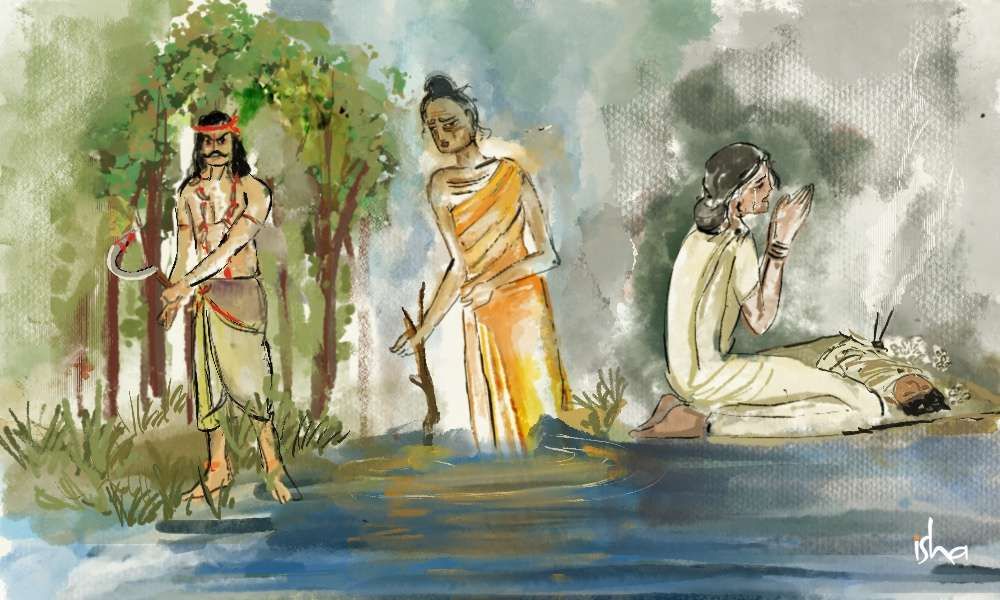
గౌతముడి పేరు విననివాళ్ళు బహుశా ప్రపంచంలో ఎవరూ ఉండరు. ఎందరో బుద్ధులు ఉన్నారు, కానీ ఆయన పేరు మాత్రం కలకాలం నిలిచి పోయింది. ఆయన కలిగించిన ఆధ్యాత్మిక చైతన్యం అంత గొప్పది, బహుశా ఆయనే ఈ మొత్తం భూమి మీద ఎంతో విజయవంతమైన ఆధ్యాత్మిక బోధకుడు. ఆయన జీవిత కాలంలోనే ఆయన దగ్గర 40 వేల మంది సన్యాసులు ఉండేవారు. ఈ సన్యాసుల సేన ఆధ్యాత్మిక చైతన్యాన్ని సృష్టించడానికి బయటికి వెళ్లారు. ఆయన కొత్తగా ఏది చేయలేదు; కానీ, సమాజానికి పనిచేసే విధంగా ఆయన ఆధ్యాత్మికతను అందించారు. అప్పటివరకు ఆధ్యాత్మిక ప్రక్రియ కేవలం సంస్కృత భాషలో మాత్రమే అందించబడింది. సంస్కృత భాష సమాజంలో చాలా కొద్ది మందికి మాత్రమే అందుబాటులో ఉండేది. మిగిలిన వారికి అది నేర్చుకోవడం సాధ్యమయ్యేది కాదు. ఎందుకంటే, ఈ భాషను దివ్యత్వానికి కీలకంగా చూసేవారు. మొట్టమొదటిసారిగా గౌతముడు పాలి భాషలో మాట్లాడారు, అది ఆనాడు వాడుకలో ఉన్న భాష. ఆయన అన్ని రకాల ప్రజలకూ ఆధ్యాత్మికత ద్వారాలు తెరిచారు.
#1. గౌతముడి బాల్యం
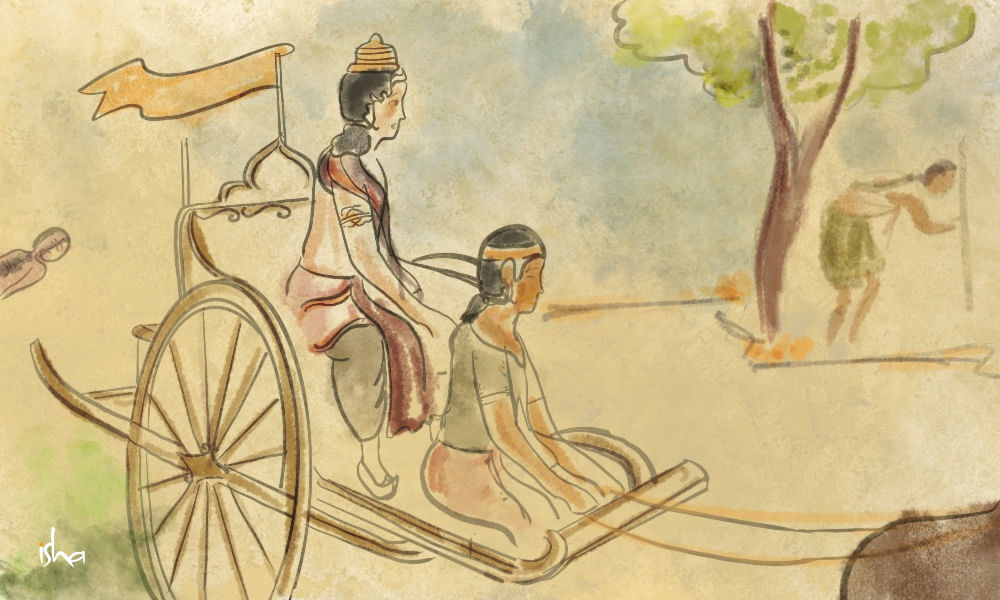
గౌతముడు ఒక చిన్న రాజ్యానికి యువరాజు. ఆయన పుట్టినప్పుడు ఒక యోగి జోస్యం చెప్పాడు. అది ఏమిటంటే, అతను అయితే ఒక గొప్ప సార్వభౌముడు అయినా అవుతాడు లేదా ఒక గొప్ప తాపసి అయినా అవుతాడు అని. ఆయన ఈ జోస్యం చెప్పినప్పుడు గౌతమి తండ్రి ఎంతో ఉత్సాహ పడ్డాడు. ఆయనకు గౌతముడు గొప్ప తాపసి కావడం ఇష్టం లేదు. ఈయన గొప్ప సామ్రాట్ కావాలని అనుకున్నాడు. ఒకవేళ బాధనూ, దుఃఖాన్నీ చూసినట్లయితే ఆయన ఒక తాపసిగా మారవచ్చు అనుకుని, గౌతముడిని ఎప్పుడూ విలాసాలలో ముంచాడు - మంచి ఆహారం, బట్టలు ఇంకా విలాసాలు. అతనికి 19 సంవత్సరాల వయసు వచ్చినప్పుడు తండ్రి ఆయనకు ఎంతో అందమైన యువతితో వివాహం చేశాడు. వారిని ఒక రాజ భవనంలో, మిగతా సమాజం నుండి దూరంగా ఉంచాడు. అక్కడ కేవలం వినోదాలు, విలాసాలు మాత్రమే తప్ప ఎటువంటి బాధలనూ చూసే అవకాశం లేదు. ఒకరోజు గౌతముడు నగరంలో సంచరించాలి అనుకొని, తనని సంచారానికి తీసుకువెళ్ళమని రథసారధిని ఆదేశించాడు.
ఆయన అలా వెళుతున్నప్పుడు ఒక వృద్ధుడిని చూశాడు. అప్పటివరకు తన జీవితంలో వృద్ధులను ఆయన చూడలేదు. ఆయన తండ్రి వీటన్నిటి నుండి ఆయనను సురక్షితంగా ఉంచాడు. "ఇతనికి ఏమైంది?" అని సారథిని అడిగాడు. అందుకు ఆ రథసారథి "ఆయన ఓ వృద్ధుడు, అంతే!" అన్నాడు. "ఇది ఎలా జరుగుతుంది" అని అడిగాడు. అందుకు అతను "అందరూ ఏదో ఒక రోజు వృద్ధులు అవుతారు" అన్నాడు. తనని తాను చూసుకున్నాడు, తను ఎంతో యవ్వనంలో ఉన్నాడు. "ఏమిటి నేను కూడానా?" అని అడిగాడు. దానికి సమాధానంగా “అవును. అందరికీ ముసలితనం వస్తుంది. ఎక్కువ కాలం జీవిస్తే ముసలివాళ్ళు అవుతారు.." అన్నాడు. "నేను కూడా ఆ విధంగా అవుతాను" అని, ఆయన ఒక వాస్తవం తెలుసుకున్నాడు.
ఆ తర్వాత వీధిలో ఒక మనిషి పడుకొని ఉండడం చూశాడు, అతను ఏదో జబ్బుతో బాధపడుతున్నాడు, లేవ లేక పోతున్నాడు ఎంతో బాధలో ఉన్నాడు. గౌతముడు "ఆగు, ఈ మనిషి ఎవరు? ఇతను ఏమి చేస్తున్నాడు?" అని అడిగాడు. రథసారథి, "ఓఁ, దురదృష్టవశాత్తు అయన అనారోగ్యంతో ఉన్నాడు" అన్నాడు. "దాని అర్థం ఏమిటి?" అని గౌతముడు అడుగాడు. "శరీరం ఉంది కదా! అప్పుడప్పుడు దానికి అనారోగ్యం వస్తుంది. అది ఎవరికైనా జరగవచ్చు" అన్నాడు. "నేను యువరాజును, నాకు కూడా అలా జరిగే అవకాశం ఉందా?"అన్నాడు. "ఎవరికైనా అలా జరగవచ్చు." దానితో గౌతముడు "ఓఁ, నేను కూడా ఈ విధంగా కావచ్చు" అని తెలుసుకున్నాడు. దీనితో ఆయన చాలా వ్యాకుల పడ్డాడు. వాళ్లు ఇంకొంచెం ముందుకు వెళ్లిన తర్వాత అక్కడ దహనసంస్కారాలు జరగడం చూశారు. కొందరు ఒక మృతదేహాన్ని మోసుకొని వెళ్తున్నారు. "అతనికి ఏమైంది?" "ఓఁ, అతను చనిపోయాడు అంతే!" "అంటే ఏమిటి?" "ఇది ఖచ్చితంగా అందరికీ జరిగే తీరుతుంది."
అందుకు గౌతముడు"నేను ఏం చేస్తున్నాను? ఇలా తినడం, విలాసాలలో మునిగి తేలడం అంతా అర్థ విహీనం. నాతో నేనేం చేసుకుంటున్నాను?’’ అంటూ అతనిలో విపరీతమైన అలజడి చెలరేగింది. ఉన్నట్టుండి యువరాజుగా ఉండడం, అంతఃపురం విలాసాలు ఇవన్నీ అతని నుండి విడిపోయాయి.
"వీటన్నింటి వల్ల ప్రయోజనం ఏమిటి? ఈ దేహం ముసలిది అయిపోవచ్చు, అనారోగ్యం పాలు కావచ్చు, ఖచ్చితంగా మరణం సంభవిస్తుంది. మరి, నా జీవితాన్ని నేను ఈ విధంగా ఎందుకు సాగిస్తున్నాను?" అని ఆలోచించసాగాడు. కానీ అప్పటికే, ఆయనకు ఒక పసిబిడ్డ ఉన్నాడు. ఎంతో ప్రేమించే భార్యను, ప్రియమైన బిడ్డను అతను వదలలేక పోయాడు. తనలో తాను ఆయన ఎంతో ఘర్షణకు లోనయ్యాడు.
అప్పటికి దాదాపుగా ఏడాది పైన మూడు నెలలు గడిచాయి. ఆ పిల్లవాడికి ఒకటిన్నర సంవత్సరం వయసు ఉన్నప్పుడు, ఆయన ఇక ఆగలేకపోయాడు. ఒక అర్ధరాత్రి వేళ ఎవరికీ చెప్పకుండా ఆయన అంతఃపురం నుండి ఒక దొంగలా బయటపడి, దానిని శాశ్వతంగా వదిలిపెట్టాడు. "నేను ఈ జీవిత సత్యాన్ని తెలుసుకోవాలి" అంటూ, అని ఆయన సత్యాన్వేషణలో బయలుదేరాడు.
బుద్ధుని జ్ఞానోదయ మార్గం
ఆ కాలంలో భారతదేశంలో ఎన్నో భిన్నమైన ఆధ్యాత్మిక మార్గాలు ఉండేవి. ఒకానొక సమయంలో 1,800 విధానాలు ఉండేవి, 18 వందల భిన్నమైన యోగ విధానాలు. ఈనాటి వైద్యశాస్త్రం ఏ విధంగా ఉందో ఇది ఆ విధంగా ఉండేది. ఉదాహరణకు, పాతిక సంవత్సరాల క్రితం, మీకు మెడికల్ చెకప్ కావాలంటే, మీరు కేవలం మీ ఫ్యామిలీ డాక్టర్ దగ్గరకు వెళ్లేవారు. ఈనాడు, మీ దేహంలోని ప్రతి భాగానికి ఒక డాక్టర్ ఉన్నాడు.
యోగ విధానానికి కూడా ఇలాంటిదే జరిగింది. ఎన్నో భిన్నమైన విధానాలలో, చిన్న అంశాలలో ప్రజలు నిష్ణాతను సాధించడం మొదలు పెట్టారు. స్పెషలైజేషన్ అనేది ఒక స్థాయి దాటినప్పుడు ఇక అది హాస్యాస్పదంగా ఉంటుంది. ఇలాంటి సమయంలోనే, పతంజలి వచ్చి అన్నిటినీ యోగసూత్రాలుగా సంకలనం చేశాడు.
గౌతముడు పతంజలి మహర్షి తరువాత వచ్చిన వాడే కానీ, అప్పటికి ఇంకా ఎన్నో విధానాలు ఉన్నాయి. ఆయన ఒక విద్యాశాల నుండి మరొక విద్యాశాలకు వెళుతూ ఎనిమిది రకాల సమాధి స్థితులను అభ్యసించాడు. ఆయనకు ఇవన్నీ ఎంతో అందమైన అనుభూతులుగా ఉన్నాయి. కానీ, అవి ఆయనకు ముక్తిని కలిగించలేదు. ఇలాంటి పరిస్థితిలో ఆయన ఒక ‘సమానా’గా నడవడం మొదలు పెట్టాడు. ఇది ఎలాంటి సాధన అంటే వీళ్ళు ఎవరిని భోజనం కోసం కూడా అడగకుండా నడుస్తూ ఉంటారు. వాళ్లు ఆహారాన్ని వెతుక్కుంటూ వెళ్ళరు, ఎందుకంటే వాళ్ళు మనుగడ యొక్క ప్రాథమిక అంశాన్ని గెలవాలనుకుంటారు.
‘సమానా’లు కేవలం నడుస్తూ ఉంటారు, ఎవరినీ ఆహారం కోసం కూడా అడగరు. కానీ ఆ రోజుల్లో సంస్కృతి సున్నితంగా ఉండేది. ఎవరైనా ఆధ్యాత్మిక వ్యక్తి నడుస్తూ ఉండడాన్ని చూస్తే ప్రజలు ఇంట్లో వంట చేసి, వారి వెంట పరిగెట్టి, వారికి ఆహారాన్ని అందించేవారు. ఎందుకంటే, వీళ్లు ఆహారాన్ని అడగరు అన్న విషయం వారికి తెలుసు. ఈ రోజుల్లో మీరు ఒక ‘సమాన’ అయితే, మీరు చచ్చేంత వరకూ నడుస్తూ ఉండవలసిందే. ఆ రోజుల్లో ప్రజల్లో సున్నితత్వం ఉండేది. సాధనకు స్పందించేవారు అందుకని దేశంలో వేల మంది సమానాలు నడుస్తూ ఉండేవారు. గౌతముడు ఒక సమాన అయ్యాడు. మీరు భోజనం కోసం అడగకపోవచ్చు కానీ ఒక నగరానికి దగ్గరగా నడిచినట్లు అయితే ఆహారం దొరుకుతుంది. కానీ గౌతముడు ఈ వ్రతాన్ని తేలిగ్గా తీసుకోలేదు. అలా నడుస్తూ ఉన్నాడు. ఆయన ఎముకల గూడు అయిపోయాడు. చర్మం కప్పిన అస్తిపంజరంలా తయారయ్యాడు.
అప్పుడు ఆయన నిరంజన అనే ఒక నది సమీపానికి వచ్చాడు. అందులో షుమారు 18 నుండి 20 అంగుళాల నీరు మాత్రమే ఉంది. ఆయన అందులో అడుగుపెట్టాడు. నది మధ్యలో ఉన్నప్పుడు ఆయనకు నదిని దాటే శక్తి లేకపోయింది. ఆయనకు తర్వాతి అడుగు తీసుకోవడానికి కూడా తగిన శక్తి లేదు. కానీ, ఆయన అలా వదిలిపెట్టే మనిషి కాదు. అక్కడ ఒక ఎండిపోయిన చెట్టు కొమ్మ ఉంది, ఆయన దాన్ని అలా పట్టుకుని నుంచున్నాడు. అలా పట్టుకొనే ఉన్నాడు. ఎంతకాలమో మనకు తెలియదు. బహుశా రెండు నిమిషాలు అయి ఉండొచ్చు. మీకు నీరసంగా ఉన్నప్పుడు ఆ రెండు నిమిషాలే మీకు రెండు సంవత్సరాలలా అనిపిస్తాయి. ఆయన అలా పట్టుకొని ఉన్నప్పుడు ఆయనకు ఇది తెలిసింది, "నేను దేని కోసం కృషి చేస్తున్నాను? నేను ఈ దేశాటన దేనికోసం చేస్తున్నాను? ఒక విద్యాశాల నుండి మరొక విద్యాశాలకు, ఇది అది నేర్చుకుంటూ అసలు నేను దేని గురించి వెతుకుతున్నాను?" అని. అప్పుడు ఆయనకు తెలిసొచ్చింది. ‘‘నిజానికి ఉన్నది ఏదీ లేదు. ఈ జీవం కొనసాగుతోంది. నేను చేయవలసిందల్లా అది అనుభూతి చెందడానికి ఏవైతే ఆటంకాలుగా ఉన్నాయో వాటిని తొలగించుకోవడం, మాత్రమే!" అని.
గౌతముడు ఏ విధంగా బుద్ధుడు అయ్యాడు
ఆయనకు సర్వం తనలోనే ఉన్నాయన్న జ్ఞానం కలిగినప్పుడు, వెతికేందుకు ఎక్కడికీ వెళ్లాల్సిన పనిలేదు అని తెలియగానే ఆయనకు తరువాతి అడుగు, ఆ తరువాతి అడుగు తీసుకోవడానికి ఉన్నపళంగా శక్తి వచ్చింది. ఆయన నదిని దాటి ప్రస్తుతం ఎంతో ప్రసిద్ధమైన బోధి చెట్టు కింద కూర్చున్నాడు. ఆ రోజు పౌర్ణమి. ఆయన అక్కడ ఎంతో దృఢనిశ్చయంతో కూర్చున్నాడు "అయితే నేను నా అస్తిత్వం యొక్క మూలాలను ఇప్పుడు తెలుసుకోవాలి, లేదంటే ఇక్కడే కూర్చుని, ఉన్న పళంగానే మరణిస్తాను. అంతే, నాకు అది తెలిసేంతవరకు కళ్ళు తెరవను!" అని.
ఒకసారి ఆయన ఈ దృఢనిశ్చయం చేసిన తరువాత, మీలో ఉన్నది మీకు తెలియడానికి ఒక క్షణం చాలు. జ్ఞానోదయం కోసం మీరు ప్రత్యేకించి ఏదీ చేయవలసిన పని లేదని ఆయన గుర్తించినప్పుడు ఆయనకు పూర్తి ఆత్మజ్ఞానం కలిగింది. నిండు చంద్రుడు మెరిసిపోతున్నాడు. ఆయన ఎన్నో ఏళ్లుగా సరిగ్గా భోజనం చేయలేదు. ఆయన నాలుగు సంవత్సరాలుగా ‘సమాన’ గా ఉన్నాడు. ఆయన వద్దకు అయిదుగురు శిష్యులు చేరారు. వీళ్ళు ఇన్నాళ్ళూ ఏమనుకున్నారంటే, "ఈయన అసలైన వాడు. ఎందుకంటే ఆయన భోజనం చేయడు, కఠినంగా ఉంటాడు" అని. ఇప్పుడు ఆయనని ఏదో పారవశ్య స్థితిలోనూ, ఆయన ముఖంలో ఏదో వెలుగునూ వాళ్ళు చూశారు. కళ్ళు తెరచి వారికి ఆయన ఏదో బోధన అందిస్తారు అనుకున్నారు. ఆయన కళ్ళు తెరిచి వాళ్ల వంక చూస్తూ చిరునవ్వుతో "ఏదైనా వంట చేయండి. మన అందరం తిందాం" అన్నాడు. దానితో వాళ్ళు పూర్తిగా నిరాశ చెందారు. ‘‘ఈయన పతనమై పోయాడు’’ అనుకున్నారు వాళ్లు. నాలుగేళ్లపాటు వాళ్ళ ఆయనతో నడిచారు, ఆయనకు చిత్రహింస తప్ప మరేదీ లేదు. కానీ ఆయనకు ఆత్మజ్ఞానం కలిగినప్పుడు వారు ఆయనను వదిలేశారు. ఎందుకంటే వాళ్ళు ఏదో కఠినమైన విషయాన్ని వినాలి అనుకున్నారు. కానీ ఆయన "వంట చేయండి! మనం తిందాం. మనం మన సమయాన్ని వృధా చేసుకుంటున్నాం" అన్నాడు.
#2 బుద్ధుడు, జ్యోతిష్యుడు
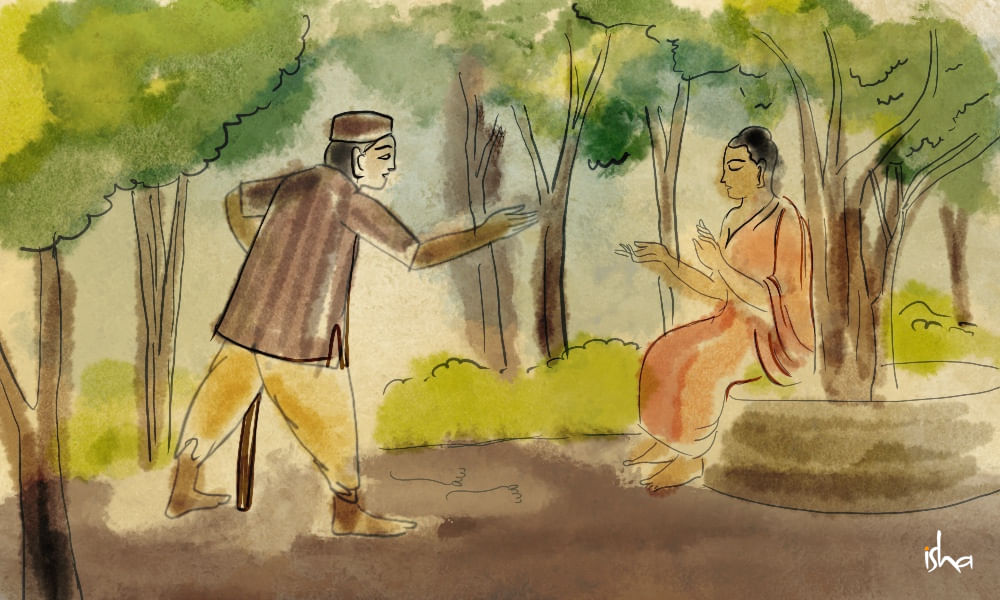
ఒకరోజు గౌతముడు, బుద్ధుడు అయిన తరువాత ఒక చెట్టు కింద కూర్చున్నాడు. చెట్టు కింద కూర్చోవడం ఉత్తమం అని కాదు కాని ఆ రోజుల్లో రియల్ ఎస్టేట్ లేదు కదా. అందుకని అన్నిచోట్లా కట్టడాలు లేవు. చెట్టు కింద కూర్చోడం ఎండలో కూర్చోవడం కంటే ఆహ్లాదకరంగా ఉంటుంది.
ఎంతో ప్రావీణ్యం గల ఒక జ్యోతిష్యుడు అక్కడ నదిలో స్నానానికి వచ్చి, నది ఒడ్డున ఒక కాలి గుర్తు చూశాడు. పాదముద్రలు ఏ విధంగా ఉన్నాయో చూసి, అతను ఏమి చేయగలడో కొందరు జ్యోతిష్యులు కచ్చితంగా చెప్పగలరు.
ఇవి చక్రవర్తి పాదముద్రలు లాగా ఆయన చూశాడు, ఎవరైతే ఈ ప్రపంచాన్ని ఏల గలడో అటువంటి వాడు. ఆ తరువాత, అటువంటి మనిషి ఇలాంటి మారుమూల అడవిలో ఎందుకు ఉంటాడు? అని ఆశ్చర్యపోయాడు. అతను ఆ పాదముద్రలు ఉన్న దిశగానే వెళ్ళాడు ఒక చక్రవర్తిని కలవబోతున్నాననే ఉద్దేశంతో. కానీ ఆయన అక్కడి ఈ సాధువును, గౌతముడిని చెట్టు కింద కూర్చుని ఉండడం చూశాడు. ఇది చూసి ఆయన, "అయితే నా జాతకం అయినా తప్పి ఉండాలి లేదా నన్ను ఎవరో ఆటపట్టిస్తూ ఉండాలి లేదా నేను ఏదో భ్రమలోనో ఉండి ఉండాలి. ఇక్కడ అసలు ఏం జరుగుతోంది?" అనుకున్నాడు. ఆయన గౌతముడి దగ్గరికి వెళ్లి, "నువ్వు ఎవరు?" అని అడిగాడు. గౌతముడు "నేను ఎవరినీ కాదు. కేవలం ఓ అనామకుడిని" అన్నాడు. "కానీ, నీకు ఒక చక్రవర్తి పాదాలు ఉన్నాయి, నువ్వు ఈ ప్రపంచాన్ని జయించాలి" అన్నాడు. గౌతముడు,"అది నేను చేస్తాను, కానీ యుద్ధం ద్వారా కాదు!" అన్నాడు.
ప్రపంచాన్ని జయించేందుకు రెండు మార్గాలు ఉన్నాయి - ఒకటి ఆక్రమించడం ద్వారా లేదా అన్నింటిని కలుపుకోవడం ద్వారా. రెండు విధానాల్లోనూ అది మీది అవుతుంది. మీరు ఆక్రమిస్తూ పోతే అది మీకు బాధ కలిగిస్తుంది. కానీ మీరు అన్నింటిని మమేకం చేసుకుంటే అది మీ జీవితాన్ని ఎంతగానో పెంపొందిస్తుంది. ఆయన "నేను ఈ ప్రపంచానికి చక్రవర్తిని!" అన్నాడు. దానికి జ్యోతిష్యుడు "నువ్వు సాధువువి. ఏదీ నీది కాదు!" అన్నాడు."నాకు ఏదీ సొంతం కాదు. నేను ఎవరినీ కాను. అందుకే అన్నీ నావే!" అన్నాడు.
శూన్యం అవడం(ఏమీ కాకపోవడం) అంటే, మీరు ఎందుకూ ఉపయోగపడరు అని కాదు అర్థం, మీరు శూన్యం అంటే మీరు అన్నింటినీ మీలో కలుపుకున్నారు అని అర్థం. మీరు ఏదో ఒకటి అయితే, మీరు అంత మాత్రంగానే ఉండగలరు. కానీ మీరు ఏదీ కాకపోతే, మీకు ఏ విధంగా కావాలంటే ఆ విధంగా ఉండవచ్చు.ఆ జ్యోతిష్యుడు కూర్చుని "నువ్వు ఒక సాధువువి. నీ దగ్గర ఏదీ లేదు. కానీ నువ్వేమో ‘నేను ఎవరిని కాదు, కానీ సర్వం నాదే’ అంటున్నావు. ఇది ఏమిటి?" అని అడిగాడు. గౌతముడు,‘‘నువ్వు రా! నా దగ్గర నీకో మార్గం ఉంది. నువ్వు జీవితంలో ఏం జరుగుతాయో అంచనాలు వేస్తున్నావు. కానీ నావద్ద ఒక ప్రణాళిక ఉంది" అన్నాడు.
‘‘మీరు జీవితం గురించి ఎందుకు అంచనాలు వేస్తారు అంటే, మీకు ఒక ప్రణాళిక వేసే సామర్థ్యం లేదు కాబట్టి. అందుకే మీరు అంచనాల మీద ఆధారపడతారు. కానీ మీకు ఒక ప్రణాళికను తయారు చేసి దానిని నిర్వహించగల సామర్థ్యం ఉంటే, మీరు అంచనాల గురించి చూడరు.’’ అన్నాడు. గౌతముడు “మీరు అంచనాలు వేస్తూ ఉన్నారు, నాకేమో ఒక ప్రణాళిక ఉంది. వచ్చి నా ప్రణాళికలో పాలుపంచుకుంటే, మనం ఏదో చేద్దాం!" అన్నాడు
#3 బుద్ధుడు ఒక మనిషి తండ్రిని స్వర్గానికి పంపినప్పుడు
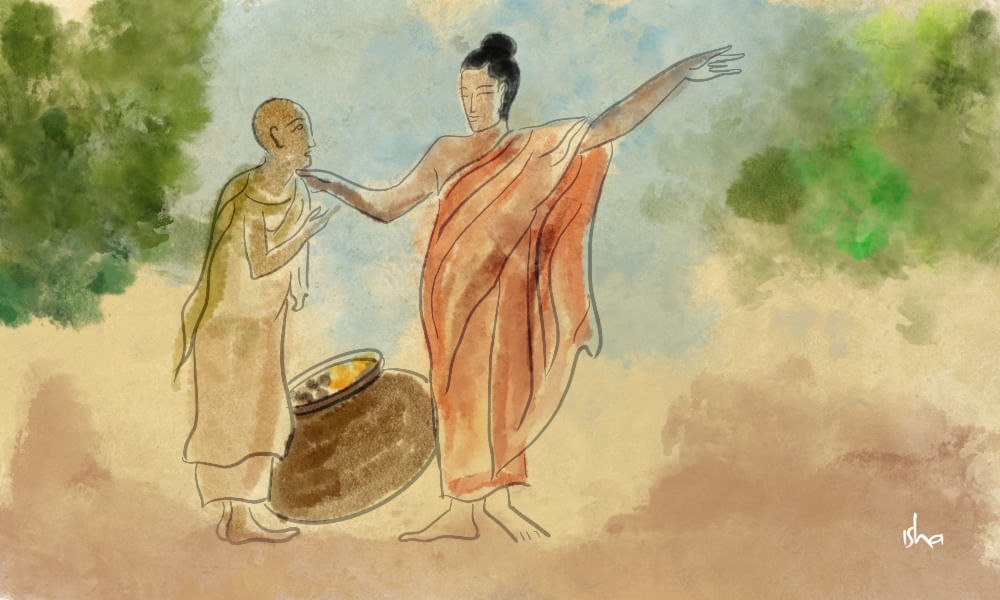
తల్లిదండ్రులు గాని, తాతలు గానీ మరణించినప్పుడు భారతదేశంలో వారికి చేయవలసిన విస్తృతమైన క్రతువులు ఉంటాయి. ఒక మనిషి చనిపోయినప్పుడు, ఎలాగైనా సరే తన తండ్రి స్వర్గానికి చేరుకోవాలి అని అతని కొడుకు అనుకున్నాడు. ఆ ఊర్లో స్వర్గానికి టికెట్లు బుక్ చేసే ట్రావెల్ ఏజెంట్లు ఎంతోమంది ఉన్నారు. అతను ఒక ట్రావెల్ ఏజెంట్ దగ్గర నుండి మరొక ట్రావెల్ ఏజెంట్ కు వెళ్తూనే ఉన్నాడు. అందరూ టికెట్ ఇవ్వడానికి సిద్ధపడ్డారు కానీ ఖచ్చితంగా స్వర్గానికి పంపిస్తామని ఎవరూ చెప్పలేకపోయారు. కానీ తనేమో వాళ్ళ నాన్న గారికి స్వర్గానికి చేర్చే ఖచ్చితమైన టికెట్ కావాలనుకున్నాడు. ఆరోజున గౌతమ బుద్ధుడు ఆ ఊరిలోనే ఉన్నాడు అన్న విషయం తెలుసుకున్నాడు.
ఆత్మజ్ఞానం పొందిన వ్యక్తి అంటే, భగవంతుడుతో ముఖాముఖి మాట్లాడగలిగినట్లే. ఆయనతో కనుక రికమండేషన్ చేయించుకో గలిగితే మీ నాన్నగారు సూటిగా స్వర్గానికి వెళ్తారు, గేట్ల దగ్గర కూడా ఎవరూ ఆపలేరని చెప్పారు. ఇక ఇతను బుద్ధుడిని వెతుక్కుంటూ వెళ్ళాడు.
గౌతముడు ఊరి బయట ఉన్న ఒక పెద్ద సరస్సు ఎదురుకుండా ఉన్న చెట్టు కింద కూర్చుని ఉన్నాడు. ఇతను వెళ్లి గౌతముడి కాళ్ళమీద పడి ఆయన కాళ్ళను ఒక మోసలిలా పట్టుకుని "మా నాన్నగారు ఎంతో మంచి మనిషి. ఆయన చనిపోయారు. ఆయన కచ్చితంగా స్వర్గానికి వెళ్లాలని నేను కోరుకుంటున్నాను. ఆయన పైకి వెళ్లాలి, కిందకు కాదు" అన్నాడు. గౌతముడు నోరు తెరిచి సమాధానం చెప్పే లోపే, అతను "మీరు కాదనకూడదు!" అన్నాడు. భారతదేశంలో ఒక సాంప్రదాయం ఉంది. అదేమిటంటే ఎవరైనా వచ్చి మిమ్మల్ని ఏదైనా కావాలని ప్రాధేయపడితే, మీరు కాదన కూడదు, ఎందుకంటే అవతల వ్యక్తి నిస్సహాయంగా ఉన్నారు కాబట్టి. మీరు ఇంక ఒప్పుకోక తప్పదు. అప్పుడు గౌతముడు, "సరే!, ఇంక నేనేం చేయగలను... నువ్వు నాకు ఈ విధంగా అంక్ష పెట్టావు కాబట్టి, నేను నీకు వీలుకాదు అని చెప్పలేను. సరే నువ్వు ఒక పని చెయ్యి నువ్వు ఇంటికి వెళ్లి, ఉదయం నాలుగు గంటలకు నదిలో స్నానం చేసి, ఒక మట్టికుండ తీసుకుని అందులో సగం వరకు రాళ్లతో నింపు, మిగతా సగం వెన్నతో నింపు. దానిని ఒక గుడ్డతో కట్టి ఇక్కడికి తీసుకురా! నీ తండ్రికి మనం ఏమి చేయగలమో చూద్దాము!"
అతను వెళ్ళాడు. తండ్రిని స్వర్గానికి పంపించడానికి చిన్న కుండ అయితే సరిపోతుందా, అతను ఆ ఊర్లో ఉన్న అతి పెద్ద కుండను తీసుకువచ్చాడు. దానిని సగం రాళ్లతో నింపి మిగతా సగాన్ని వెన్నతో నింపి గట్టిగా కట్టాడు. ఎంతో బరువుగా ఉన్న ఈ కొండను చాలా కష్టపడి అతను మోసుకొని వెళ్ళి గౌతముడు ఎదురుకుండా నిలుచున్నాడు. గౌతముడు అతన్ని చూసి ఇలా అన్నాడు, "ఆ చెరువు చుట్టూ మూడు సార్లు తిరిగి రా". దీనినే ప్రదక్షిణం అంటారు. దీని వెనుక ఒక శాస్త్రం ఉంది, కానీ ఈ రోజుల్లో ప్రజలు దీన్ని హాస్యాస్పదంగా చేసి, అన్నింటి చుట్టూ మూడుసార్లు తిరుగుతూ ఉంటారు. గౌతముడు అతనితో "వెళ్లి ఆ చెరువు చుట్టూరా మూడు సార్లు తిరిగ"మన్నాడు. అతను ఈ బరువైన కొండను మోసుకుంటూ చెరువు చుట్టూ మూడు సార్లు తిరిగాడు. అతను తిరిగి గౌతముడికి దగ్గరికి వచ్చి నిల్చునే సరికి అతని పని సగం అయిపోయింది. గౌతముడు అతని పరిస్థితిని అతని పట్టుదలని గమనించాడు. గౌతముడు అతనితో "నువ్వు నీ ఛాతి వరకు నీళ్లు వచ్చేలాగా, నీళ్ళలోకి దిగిమని" చెప్పాడు. అతను నీళ్ళలోకి వెళ్ళాడు.
అప్పుడు గౌతముడు "మెల్లిగా కుండను నీటిలోకి వదిలేయ్" అన్నాడు. కుండ నీటిలో మునిగిపోయింది. గౌతముడు ఒక దుడ్డు కర్ర తీసుకొని అతని వైపు విసిరి అతనితో ఇలా అన్నాడు "ఈ కర్రను తీసుకొని ఇప్పుడు ఒక్క వేటుతో లోపల ఉన్న కుండను పగలగొట్టాలి. కుండ నీటి లోపల ఉంది, అతను చాలా అలసిపోయి ఉన్నాడు. ఈ పని చేయడం అతనికి చాలా కష్టమే, కానీ అతని తండ్రి స్వర్గానికి వెళతాడు. అందుకని అతను అక్కడ నుంచొని సిద్ధమయ్యాడు. ఆ మనిషి అతనికి తెలుసిన దేవుళ్ళందరినీ తలుచుకొని శ్వాస బిగబెట్టాడు. అప్పుడు గౌతముడు "నువ్వు దీన్ని ఒక్క దెబ్బతో పగలగొడితే, రాళ్లు పైకి తేలి, వెన్న కిందకి పోతుంది అప్పుడు మీ నాన్నగారు స్వర్గం చేరుకున్నట్లే." అన్నాడు. ఒక పెద్ద దెబ్బతో ఆ కుండ పగిలి పోయింది, వెన్న పైకి తేలింది. అపరాధం చేసినట్లుగా అతను చూసి, "వెన్న పైకితేలింది ఇప్పుడు ఏం చేయాలి" అన్నాడు. గౌతముడు "అయితే ఆయన చేరుకోలేదు" అన్నాడు. రాళ్లు పైకి తేలాలి కానీ వెన్న పైకి తేలింది. ఆ మనిషి పూర్తిగా నిరుత్సాహంతో నిస్పృహతో ఉన్నాడు. అతను వెనక్కి తిరిగి నడవడం మొదలు పెట్టాడు.
అతను నీళ్లలో నుంచి బయటికి రావడం మొదలు పెట్టాడు. అతని బుర్ర పని చేయడం మొదలుపెట్టింది. అతను గౌతముడు దగ్గరికి వచ్చి "మీరు వెన్న మునిగిపోతుంది రాళ్లు పైకి తేలతాయి అన్నారు. అసలు అది ఎలా సాధ్యం. ఇది ప్రకృతి ధర్మానికి విరుద్ధం కదా, రాళ్లు మునిగిపోతాయి, వెన్న మాత్రమే తేలుతుంది మీరు నన్ను మోసం చేశారా?" అన్నాడు. అప్పుడు గౌతముడు "ఓఁ, ఇప్పుడు నీకు ప్రకృతి ధర్మాలు తెలుస్తున్నాయి, ఇక సమస్య ఏముంది. మీ నాన్నగారు వెన్న వంటి వారైతే పైకి వెళ్తారు. ఒకవేళ ఆయన ఒక రాయి లాంటి వాడైతే కిందకి పోతాడు. ఇందులో నేను చేయగలిగింది ఏముంది? ఇంకా నువ్వు చేయగలిగింది ఏముంది? నువ్వు చాలా అలసిపోయావు. ఇంటికి వెళ్లి పడుకో!" అన్నాడు
#4 బుద్ధుడు - అంగుళీమాల
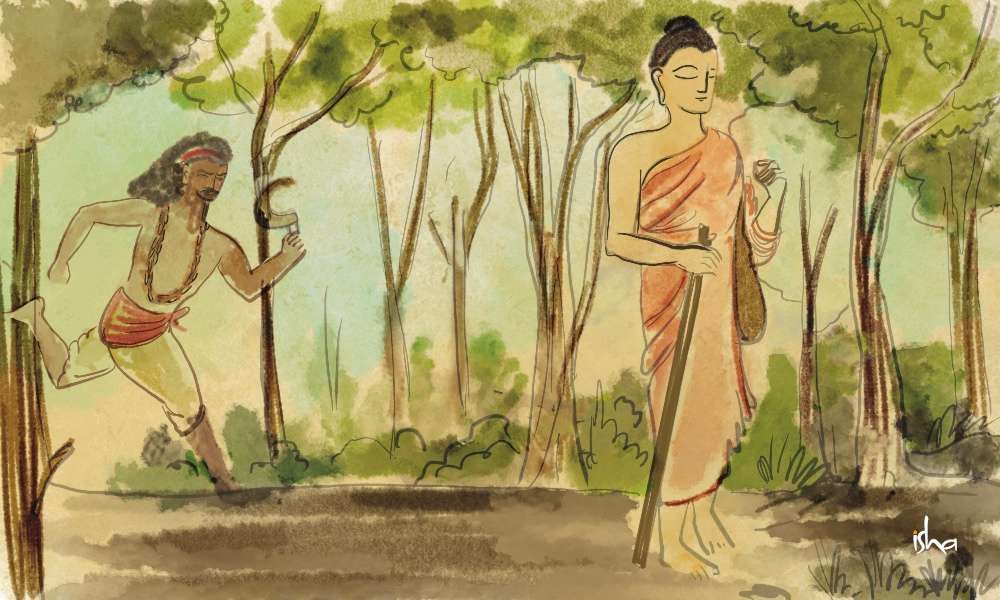
ఒక వ్యక్తి ఉండేవాడు. అతనికి జనాలు ఇచ్చిన పేరు అంగుళీమాల. అతనికి ఏదో ఒక సంఘటన జరిగింది. సమాజం తన పట్ల అన్యాయంగా ప్రవర్తించిందని, అతను ఒక కోపిష్టిగా తయారయ్యాడు. యౌవ్వనంలో మీకు ప్రతిదీ అన్యాయం అనిపిస్తుంది. సమాజంపై కోపంతో, తనతో అన్యాయంగా ప్రవర్తించిన ఈ ఊరిలోని 101 మందిని చంపి, వాళ్ళ ఒక వేలును కత్తిరించి, తన మెడ చుట్టూ ఒక దండలా వేసుకుంటానని. అతను ఒక ప్రతిజ్ఞ పూనాడు.
అతను ఆలా చేస్తూ పోయాడు. అతను ఒక అడవిలో ఉండేవాడు, కానీ, అది అనేక మార్గాల మధ్యలో ఉంది. అందువల్ల, కొన్ని సంవత్సరాలలో, అతను వంద మందిని చంపేశాడు. తన ప్రతిజ్ఞ పూర్తిచేయడానికి, ఇంకొకరు కావాలి. ఒక రోజున గౌతమ బుద్ధుడు ఈ ఊరికి వచ్చాడు. అప్పటికే, ఈ వేళ్ళను మాలగా ధరిస్తుండటం వలన, అతన్ని అంగుళీమాల అంటే - చేతి వేళ్ళను దండగా ధరించేవాడు - అని పిలిచేవారు. తన ప్రతిజ్ఞ పూర్తి చేసుకోవడానికి ఇంకొక చేతి వేలు కావాలి. గౌతమ బుద్ధుడు వచ్చాడు, ఆయన ఈ దోవనే వెళ్ళాలి. “ఆ మార్గంలో వెళ్ళవద్దు. వాడు మనిషి కాడు, ఒక మృగం. బోధించడానికి కానీ, ధ్యాన పరుణ్ణి చేయడానికిగానీ, అతను తగిన వాడు కాదు, మీరు వెళ్ళవద్దు ఎందుకంటే అతనికి ఇంకొక ప్రాణం కావాలి. అది మీరేకావాలని మేము కోరుకోవడం లేదు’’ అని ప్రజలు అన్నారు. అప్పుడు గౌతముడు “నేను వెళ్లక పొతే, ఎవరు వెళతారు? అతను కోరిక నెరవేర కుండానే ఉంటాడు. అతనికి ఇంకొక్క వేలే కావాలి. నన్ను పోనివ్వండి” అంటూ ఆయన వెళ్లారు. అంగుళీమాల ఒక రాతి పైన కూర్చుని, మౌనంగా వస్తున్న సన్యాసిని చూసాడు.
ఇప్పటికే, తన పేరు ప్రఖ్యాతుల పట్ల అతనికి ఆనందంగా ఉంది. ప్రజలు అతనంటే భయ భీతులవుతున్నారు, అది అతనికి చాల ఇష్టం. ప్రజలు అతని పేరు వింటేనే వణికిపోతారు. ఆ రాతి మీద కూర్చుని, ఈ సన్యాసి ఆ విషయం తెలుసుకోవాలన్నట్లుగా “నేను ఇక్కడ ఉన్నాను. నీ చావు మూడుతోంది” అంటూ గర్జించాడు. గౌతముడు అతని వైపు చూసి, తన ముఖంపై చిరునవ్వుతో మౌనంగా నడవ సాగాడు. అది అతనికి నచ్చలేదు. సామాన్యంగా అతన్ని చూసినా, విన్నా ప్రజలు తమ ప్రాణాలు రక్షించుకోవడానికి, అస్తవ్యస్తంగా పరిగెత్తుతారు. అదంటే అతనికి ఇష్టం. మరి, ఈ మనిషి చక్కగా నడిచి వెళుతున్నాడు. అతను రాతి మీద నుండి దూకి, అతని ఎదుటికి వచ్చి ఇలా అన్నాడు, ‘‘నువ్వు ఎవడివి? నేనెవరినో తెలుసా?” అంటూ తన వేళ్ళతో ఉన్న మాలను చూపించాడు. ‘‘నా గురించి నీకు తెలుసా?” అని అన్నాడు, గౌతముడు “ఆఁ! నీ గురించి చాల విన్నాను. అయితే ఏమిటి?” అని నడుస్తూనే ఉన్నాడు. అంగుళీమాల ‘‘ఎక్కడికి పోదామను కుంటున్నావు? నేను మాట్లాడుతుంటే, నువ్వు వెళ్తూనే ఉన్నావు?” దానికి గౌతముడు “నా పయనం ఎప్పుడో ఆగిపోయింది. నేను గమ్యం చేరుకున్నాను. నీవే ఎక్కడికో పోదామని ప్రయత్నిస్తున్నావు.” అన్నాడు. అప్పుడు అంగుళీమాల నవ్వి “చెత్త మాటలు. నువ్వో పిచ్చివాడవు. నేను స్థిరంగా నిలుచున్నాను. నీవేమో వెళ్తున్నానని అంటున్నావు, కానీ నువ్వు నడుస్తున్నావు, అయినా ఎక్కడికి వెళ్లడం లేదంటున్నావు. నీకేమయింది?” అన్నాడు. దానికి గౌతముడు “నేను చాలా కాలం క్రిందే చేరుకున్నాను. నేను ఎక్కడికీ వెళ్లడం లేదు. నీవే ఎక్కడికో వెళ్లాలని ప్రయత్నిస్తున్నావు. కానీ, నీకు ఎక్కడికి వెళ్లాలో తెలీదు. నీకు నా వేలు కావాలా లేక నా మెడ కావాలా? నీ దగ్గర వేళ్ళు ఇప్పటికే ఉన్నాయి, నా తలను వెళ్ళాడ తీయి. అది నీ కంఠమాలలో మంచి పతకంగా ఉంటుంది. ఎందుకంటే నా పని పూర్తయింది, నేను చేరాను. నేను భౌతికంగా ఇక్కడ ఉన్నా, లేకపోయినా పర్వాలేదు. నీకు కావాల్సింది చేసుకో” అన్నాడు.
ఎవరినైనా చంపే ఆనందం, వారు భయ భ్రాంతులై, చావడానికి ఇష్టపడక పోతున్నప్పుడే. కాని, చావాలని నిశ్చయించుకుని, విచారించకుండా ఉంటే, అటువంటివాడిని చంపి ప్రయోజనమేమిటి? ఏమనిపిస్తోందంటే ఈ వ్యకిని చంపినప్పటికీ, 101 మందిని చంపాలన్న కోరిక తీరదు, ఎందుకంటే అది ఆనందం ఇవ్వదు. అప్పుడు అంగుళీమాల “ఆఁగు! నీవు ఇది ఏమిటో నాకు చెప్పు? నీవు కదుల్తున్నావు, నేను చేరాను అంటూనే నడుస్తున్నావు. నేను కదలటం లేదు కానీ కదుల్తన్నానని అంటున్నావు” అన్నాడు. గౌతముడు, “నీవు నీకు తెలసిన పద్ధతిలో తృప్తికై ఎదురుచూస్తున్నావు. నేను ఇప్పటికే తృప్తి పొందాను. ఇదే పెద్ద తేడా. నీవు నా ప్రాణం తీయవచ్చు. దాని వల్ల నీకు తృప్తి వస్తుందని నీవనుకుంటే, నువ్వు ఆ పని చెయ్యి, ఎందుకంటే నా పని ప్రజలను తృప్తి పరచడమే. కేవలం నా గొంతు కోసి, ఏ విధమైన బోధనలు లేకుండానే, నీకు ఇంత సులభంగా తృప్తి వచ్చేస్తే, కానిచ్చేయి. సమస్య ఏముంది?” అన్నాడు.
అప్పుడు అంగుళీమాల ఆయన శిష్యుడయ్యాడు. గౌతముడు “నీవు ఏ ఊరిలో వంద మందిని చంపావో ఆ ఊరికి నీవు తప్పక వెళ్ళాలి” అన్నాడు. గౌతముడి సన్యాసులని బిక్కులు అంటారు. బిక్కులు అంటే యాచకులు అని అర్థం. అప్పుడు గౌతముడు అతనికి ఒక పసుపు పచ్చ గుడ్డ, భిక్ష పాత్ర ఇచ్చాడు. ఆయన “వెళ్ళు, ఊరిలో కొంత ఆహారం కోసం ప్రయత్నించు’’ అన్నాడు. ఒక చిన్న ఊరిలో వంద మంది చనిపోయారంటే, దాదాపు ప్రతి ఇంట్లో, ఒకరు ఇతని వల్ల చంపబడ్డారు. అంగుళీమాల ఈ ఊరికి ఒక సన్యాసిలా వచ్చాడు. ప్రజలు అది చూసి భయభీతులయ్యారు. అతను ఏమి చేస్తాడో అని భయపడి, వారంతా మిద్దెల మీదకు వెళ్లారు.
ఎప్పుడయితే వారు ఇతను సాధువైనాడని, ముందటిలా, దుర్మార్గుడు కాదని చూశారో, అతనిపై రాళ్లు రువ్వడం మొదలు పెట్టారు. ఎందుకంటే ప్రతి కుటుంబం వీడివల్ల ఎవరో ఒకరిని కోల్పోయింది. అయినప్పటికీ అతను ముందుకు పోతూనే ఉన్నాడు, రాళ్లు తగిలి అతని దేహం అంతా రక్తసిక్త మయ్యింది. రాళ్లు విసరడం కొద్దిగా ఎక్కువైనప్పుడు, గౌతముడు వచ్చి "ఇతడు ఇంతకు ముందులాంటి వాడు కాదు. ఈతడు నా ప్రతి రూపం. మీరు నా పై రాళ్లు విసురుతున్నారు. వెంటనే ఆపండి. ఇతన్ని చంపి ప్రయోజనం లేదు, ఎందుకంటే ఇతనికి అతి కష్టమైన మార్గంలో జ్ఞానోదయం అయింది. ఇప్పుడు అతన్ని చంపడం ద్వారా, నష్టపోవద్దు" అన్నాడు. ఆ తరువాత అంగుళీమాల, ఒక ప్రసిద్ధ శిష్యుడై, బుద్ధుని జీవన శైలి, అవగాహనల గురించి దేశం నలుమూలల చాటాడు. కానీ, వారు అతన్ని అంగుళీమాల అనే పిలుస్తూ ఉండే వారు, ఎందుకంటే ఆ వేళ్ళ మాలను తన మెడ చుట్టూ ధరించేవాడు.
#5. బుద్ధుడు, ఆనందుడి కథ
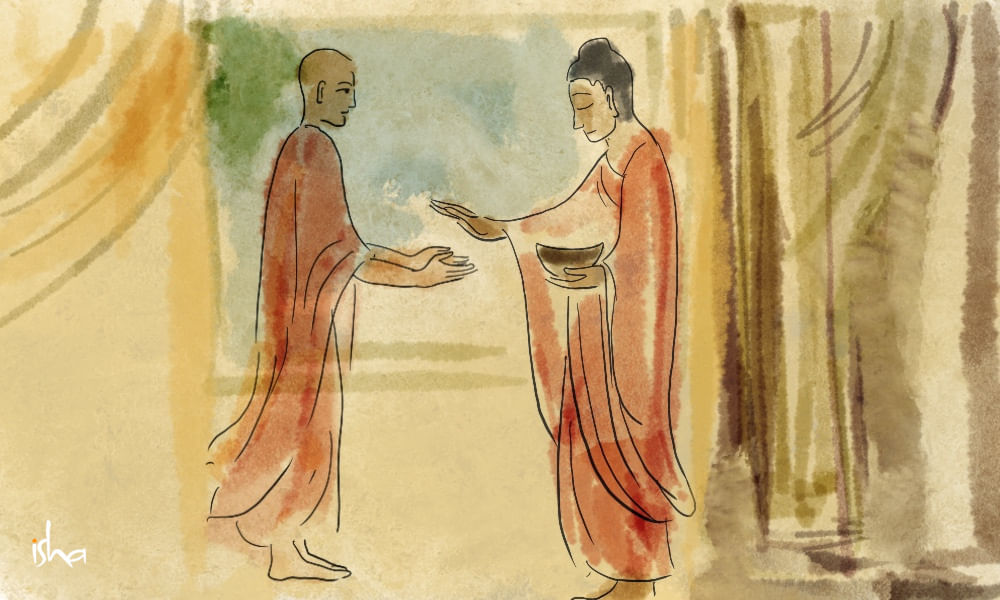
బంధుత్వం రీత్యా, ఆనందుడు బుద్ధుడికి సోదరుడు అవుతాడు. బుద్ధుడు ప్రజలకు సన్యాస దీక్ష ఇవ్వడం మొదలు పెట్టినప్పుడు ఆనందుడు వచ్చి, “నేను కూడా సన్యాసి అవుతాను, కానీ నేను నీ శిష్యుడిని అవ్వాలి అంటే, నేను ఒక షరతు, నువ్వు దానికి ఒప్పుకుని తీరాలి, ఎందుకంటే వరుసకు, నేను నీకు అన్నని. నేను నీ శిష్యుణ్ణి అవుతాను, కానీ నేను ఎప్పుడూ నీతోనే ఉంటాను. నువ్వు నన్ను ఎప్పుడూ, ఏ పనికీ పంపకూడదు. నేను ఎప్పుడూ నీ నీడలా వెన్నంటి ఉంటాను. గౌతముడు అతని వంక చూసి “అది నీ ఇష్టం, నాకు ఏ సమస్య లేదు” అన్నాడు. మీరు శిష్యుడిగా కూడా, షరతు పెట్టాలి అనుకుంటే, అప్పుడు శిష్యుడుగా ఉండటంలోని మాధుర్యం మీకు ఎప్పటికీ తెలియదు. మీరు షరతు పెట్టిన తక్షణమే జీవితంలోని అన్ని సంభావ్యతలను నాశనం చేసినట్టే. గౌతముడు నవ్వి “సరే” అన్నాడు. అతను ఈ షరతు పెట్టినప్పుడు గౌతముడు దాన్ని పాటించాడు, అతనికి ఏ సమస్యా లేదు.
ఒకసారి గౌతముడు తన భార్యను చూడాలనుకున్నాడు, అతను ఆమెను దాదాపు 8 ఏళ్లకు పైగా చూడనేలేదు. తన కుమారుడు పసివాడుగా ఉన్నప్పుడు అతను అర్ధరాత్రి వదిలేసి వెళ్లిపోయాడు. యశోద చాలా అభిమానవతి. కనీసం ఒక్క మాట కూడా చెప్పకుండా, అర్ధరాత్రి అతను వదిలి వెళ్ళిపోయాడని ఆమె చాలా బాధపడింది. అతను తన రాజ్యాన్ని, తన కుమారుడిని, తన భార్యను వదిలేసి, వారితో ఒక్క మాట కూడా చెప్పకుండా వెళ్లిపోయాడు. ఎనిమిదేళ్ల తర్వాత అతను ఆమెను చూడాలని అనుకున్నాడు, ఎందుకంటే తాను అనుభూతి చెందిన ఈ సంభావ్యతను ఆమెకు కూడా అందించాలని అనుకున్నాడు. గౌతముడు ఆనందుడితో, ”ఇప్పుడు నేను నా భార్యను కలవడానికి వెళుతున్నాను, దయచేసి కాస్త దూరంగా ఉండు, ఇప్పుడు నీ అవసరం లేదు. అమెను అర్ధరాత్రి వదిలేసి వెళ్ళిపోయానని ఇప్పటికే చాలా కోపంగా ఉంది. ఇప్పుడు నిన్ను తీసుకుని, ఆమెను కలవడానికి వెళ్తే, ఆమె దాన్ని ఒప్పుకోదు. దయచేసి నువ్వు ఇక్కడే ఉండు.” అన్నాడు. ఆనందుడు,‘‘మీరు మీ మాట నిలబెట్టుకోండి!” అన్నాడు.
అది చాలా ఇబ్బందికరమైన పరిస్థితి. గౌతముడు మాట తప్పే వ్యక్తి కాదు. అతను “సరే!” అని, తన భార్యను కలవడానికి వెళ్లినప్పుడు ఆనందుడిని కూడా వెంట తీసుకువెళ్ళాడు. ఆమె కోపంతో రగిలిపోయింది, రకరకాల శాపనార్థాలు పెట్టింది, అతనిపై కేకలేసింది, అతన్ని పిరికివాడు అని తిట్టింది. అతను మౌనంగా విన్నాడు. అప్పుడు అతను ఆమెతో, “నిన్ను పెళ్లి చేసుకున్న వ్యక్తి ఇప్పుడు లేడు, అతను పోయాడు, కానీ నేను ఇక్కడ ఉన్నాను, ఇప్పుడు నేను ఒక బుద్దుడిని, నేను జ్ఞానోదయం పొందిన వ్యక్తిని. ఆ వ్యక్తి వల్ల సాధ్యమైనది మహా అయితే ఇంకొంతమంది పిల్లలు. కానీ ఇప్పుడు మహత్తరమైనది జరగగలదు. ఈ వ్యక్తి పూర్తిగా భిన్నమైన వాడు. దయచేసి నా వైపు చూడు, నేను అదే వ్యక్తిని కాదు.” అన్నాడు.
అప్పుడు ఆమె “అదేం కాదు, నువ్వు నా భర్తవి!” అంది. ఇవన్నీ ఆనందుడితో షరతు లాగానే బంధంలో ఉండే షరతులు. “నువ్వు పిరికి వాడివి. ఈ పసివాడిని వదిలిపెట్టి వెళ్లిపోయావు. వాడికి కనీసం తన తండ్రి ఎవరో కూడా తెలీదు. నువ్వు పారిపోయావు” అంది. ఇంకా ఎన్నో అంది. ఆమె అనాలనుకున్నవన్నీ అంది. గౌతముడు “పరవాలేదు!” అన్నాడు. అప్పుడు యశోద తను ఎప్పుడూ వాడే యుక్తినే వాడింది, ఆమె, “నీ కొడుకుకి నువ్వు ఇచ్చేది ఏమిటి?” అని అడిగింది. ఆమె తన కుమారున్ని తీసుకువచ్చి, “అతను నీకు ఏమిస్తాడో నీ తండ్రిని అడుగు” అంది. గౌతముడు సిద్ధమయ్యే వచ్చాడు. అతడు ఆనందుడితో “దయచేసి నా భిక్ష పాత్రను తీసుకురా” అన్నాడు. అతను భిక్ష పాత్రను తీసుకువచ్చాడు. అతను తన కుమారుడిని పిలిచి, “నువ్వు ఒక రాజుగా బాధ పడటాన్ని నేను కోరుకోవడం లేదు, అందుకే నీకు పరమోత్తమ స్వేచ్ఛను ఇస్తున్నాను. నా వారసత్వం ఈ భిక్షపాత్ర” అన్నాడు. అతను తన బిక్ష పాత్రను తన ఎనిమిదేళ్ళ కుమారుడికి ఇచ్చాడు, ఇక ఆ కుమారుడు ఒక సన్యాసి అయ్యాడు.
ఆనందుడు తనకున్న సంభావ్యతను కేవలం ఒక్క షరతు మూలంగా నాశనం చేసుకున్నాడు. అతను దాన్ని పూర్తిగా చేజార్చుకున్నాడు. గౌతముడు తన మరణశయ్య మీద ఉన్నప్పుడు, కేవలం జ్ఞానోదయం పొందిన శిష్యులు మాత్రమే లోపల ఉన్నారు. మిగతా వారు బయటే ఉంచ బడ్డారు. ఆనందుడు “నేను అతనితో ఎంతో సన్నిహితంగా ఉన్నాను, కానీ నేను బయటి వారిలో ఉన్నాను. ఎందుకు నాకు జ్ఞానోదయం కాలేదు?” అని ఏడ్చాడు. ప్రజలు ఇదే ప్రశ్నను గౌతముడిని అడిగినప్పుడు, అతను “ఒక చెంచా, వంట రుచిని ఎలా చూడ గలుగుతుంది?” అన్నాడు. మీరు వంట రుచిని చూడాలి అంటే, మీకు నాలికకు ఉండే ఇంద్రియ జ్ఞానం ఉండాలి. మీరు జీవితంపై షరతు పెట్టిన మరుక్షణమే మీరు నిర్జీవంగా మారుతారు. మీరు ఒక వస్తువుగా కుచించుకుపోతారు ఇంకా మీరు మీకున్న సంభావ్యతని కూడా తగ్గించాలని ప్రయత్నిస్తారు. కానీ అది మీకు చాలా దూరంగా ఉంటుంది. ఆనందుడి విషయంలో అదొక దురదృష్టకరమైన విషయం.
#6. దేవుడు ఉన్నాడా ?
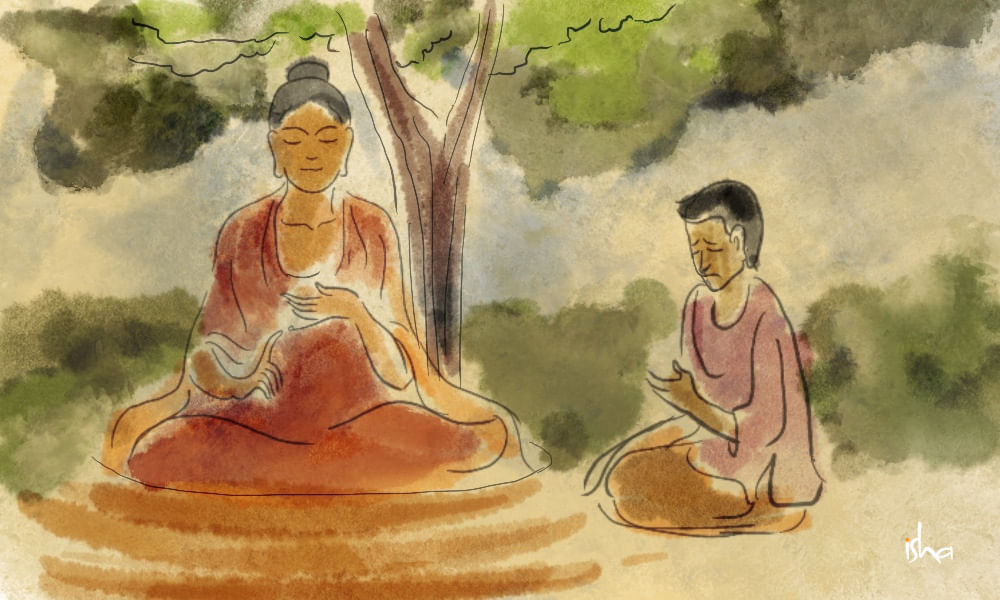
గౌతమ బుద్ధుడి జీవితంలో ఒక అద్భుతమైన సంఘటన జరిగింది. ఒక రోజు ఉదయం, ఆయన తన శిష్యుల మధ్య కూర్చుని ఉన్నప్పుడు ఒక వ్యక్తి వచ్చాడు. అతను రామ భక్తుడు. అతను తన జీవితం అంతా ‘రామా రామా రామా’ అంటూ కేవలం రామనామ జపం మాత్రమే చేస్తూ ఉన్నాడు. అతను గుళ్లకు వెళ్లడం మాత్రమే కాదు, అతను ఎన్నో గుళ్ళను కట్టించాడు కూడా. అతను ఒక గొప్ప భక్తుడు. వయసు పైబడుతుంది, ఇప్పుడు అతనికి ఒక చిన్న అనుమానం తలెత్తింది. “జీవితమంతా నేను కేవలం ‘రామా రామా రామా’ అంటూ రామ నామ జపం చేస్తూ ఉన్నాను. ఇక్కడ దేవుని పైన విశ్వాసం లేని వ్యక్తులు ఎంతోమంది ఉన్నారు, వారు ఇక్కడ కూర్చుని ప్రాపంచిక విషయాలలో ఆనందాన్ని పొందుతున్నారు. నేను కేవలం దేవుని పేరు జపం చేయడం కోసం అన్నింటినీ విడచి పెట్టాను. ఒకవేళ ఇతరులు చెబుతున్నట్టుగానే దేవుడే లేకపోతే, అప్పుడు నేను నా పూర్తి జీవితాన్ని వృధా చేసుకున్న వాడిని అవుతాను” అని సందేహం వచ్చింది. అతనికి దేవుడున్నాడని తెలుసు, కానీ ఒక చిన్న సందేహం.
“ఎలాగూ, ఇక్కడ ఒక జ్ఞానోదయం పొందిన వ్యక్తి ఉన్నాడు, అతనికి తెలిసే ఉండాలి.” అతను గౌతముడి దగ్గరికి వెళ్ళాడు. ఉదయాన్నే, సూర్యోదయం కాకమునుపే, అతడు మసక చీకట్లో నుంచుని, “దేవుడు ఉన్నాడా?” అని అడిగాడు. గౌతముడు ఈ మనిషి వైపు చూసి, “లేడు!” అన్నాడు. మొట్టమొదటిసారిగా గౌతముడు స్పష్టంగా “దేవుడు లేడు!” అని చెప్పాడు. అక్కడ ఉన్న శిష్యులందరికీ, ఎప్పుడూ తమ లోపల ఇది ఒక పెద్ద సంఘర్షణ - దేవుడు ఉన్నాడా, లేడా? అని. ఇది ఎంతో పెద్ద సంఘర్షణ, కొన్ని వేల ఏళ్లుగా ఉన్న సంఘర్షణ ఇది. మనిషి ఈ భూమి మీద నివసించటం మొదలైనప్పటి నుండి అతనిలో ఉన్న సంఘర్షణ ఇది. విశ్వసించే వారికి, ఇంకా విశ్వసించని వారికి ఇద్దరికీ ఉన్నదే ఈ సంఘర్షణ. మొట్టమొదటిసారిగా గౌతముడు కచ్చితంగా “లేడు” అని చెప్పాడు. ఇక అది ఒక గొప్ప ఊరట. ఇక మీరు ఇబ్బంది పడాల్సిన అవసరం లేదు. దేవుడు లేడు. మీ మీద ఎవరూ నిఘా పెట్టి చూడడం లేదు. మీ జీవితంలో మీకు కావాల్సింది మీరు చేసుకోవచ్చు. ఎంత ఆనందమో కదా! అది ఒక పెద్ద ఊరట.
ఆ రోజు సాయంత్రం మరొక వ్యక్తి వచ్చాడు. ఇతను ఒక చార్వకుడు. తమకు కనిపించేది తప్ప, మరి దేన్నీ నమ్మని పూర్తి లౌకికవాదులు వీళ్ళు. దేశంలో ఆ రోజుల్లో, అదే వృత్తిగా పనిచేసే చార్వకులు ఉండేవాళ్ళు. వాళ్ళు మీ పట్టణానికి వచ్చి ఒక సవాలు విసిరే వాళ్ళు, “దేవుడు లేడని నేను మీకు నిరూపిస్తాను. మీరు గనుక దేవుడు ఉన్నాడని నాకు నిరూపిస్తే, నేను మీకు ఇంత డబ్బు ఇస్తాను, కానీ నేను దేవుడు లేడు అని నిరూపిస్తే మీరు నాకు ఇంత డబ్బు ఇవ్వాలి” అని సవాలు విసిరే వాళ్లు. ఇదే వాళ్ళ వృత్తి. అతను ఒక ప్రతిభావంతుడైన చార్వకుడు. మీరు 50 ఏళ్లుగా దేవుడిపై నమ్మకంతో ఉండవచ్చు, కానీ మీరు అతనితో పదిహేను నిమిషాలు మాట్లాడితే, అతను మీకు దేవుడు లేడు అని నిరూపిస్తాడు. అతను దేవుడు లేడు అని కొన్ని వేల మందికి నిరూపించాడు. అతనికి ఇప్పుడు వయసు పైబడుతున్నది, ఇప్పుడు ఒక చిన్న సందేహం వచ్చింది. “ఒకవేళ దేవుడు ఉంటే? అని. దేవుడు లేడు అని అంతకాలంగా నిరూపించిన తరువాత, ఒకవేళ నేను అక్కడికి వెళితే, అతను నన్ను వదిలి పెడతాడా? ఇప్పటికే ఈ విశ్వాసులు దేవుడికి చాలా కక్ష ఉంటుంది అని చెబుతూ ఉంటారు - అతను నన్ను విడిచి పెడతాడా?” ఒక చిన్న భయం వచ్చింది. అతనికి కచ్చితంగా తెలుసు దేవుడు లేడు అని, కానీ ఒక చిన్న సందేహం వచ్చింది.
అతను సాయంత్రాన సూర్యుడు అస్తమించిన తరువాత, గౌతముడి దగ్గరికి వచ్చి, మసక చీకటిలో నుంచుని, అదే ప్రశ్నను అడిగాడు, “దేవుడు ఉన్నాడా?” గౌతముడు ఈ మనిషి వైపు చూసి, “ఉన్నాడు!” అన్నాడు. ఇక శిష్యులలో మళ్లీ అలజడి మొదలయ్యింది. ఉదయాన ‘దేవుడు లేడు’ అని తెలుసుకుని వాళ్ళు చాలా ఆనందంగా ఉన్నారు. సాయంత్రానికి వచ్చేసరికి అతను ‘దేవుడు ఉన్నాడు’ అని అంటున్నాడు. గౌతముడు ఎందుకు ఆడుతున్నాడు? అసలు ఏమిటీ ఆట? అతను కేవలం గందరగోళం సృష్టించడానికి ప్రయత్నిస్తున్నాడా? లేదు! ఈ ఆట అంతా, అన్ని నమ్మకాలను తీసివేయడానికే, అప్పుడే మీరు నిజంగా అన్వేషిస్తారు. నమ్మకంతో మీరు కేవలం అన్వేషణను నాశనం చేస్తారు అంతే.
#7. బుద్ధుడు జన్ సంప్రదాయాన్ని ఎలా ప్రారంభించాడు
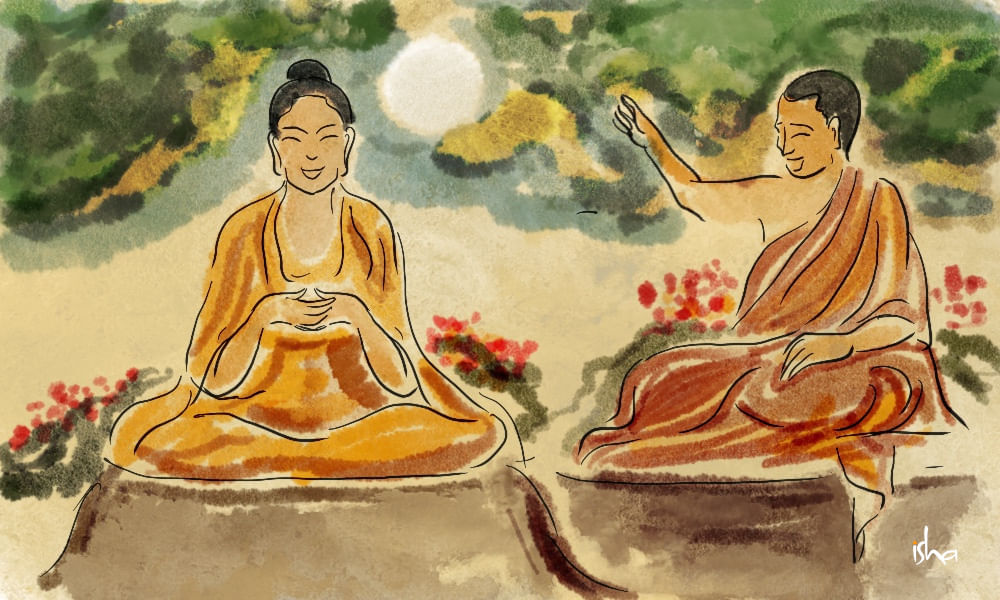
ఒకానొక రోజున, గౌతముడు వచ్చి వేదిక మీద కూర్చున్నాడు. కొన్ని వందల మంది శిష్యులు ఆయన బోధన కోసం వేచి చూస్తున్నారు. వారిలో మహాకశ్యప అనే ఒక వ్యక్తి ఉన్నాడు. ఆ సంఘంలో మిగతావారంతా, అతను వెర్రివాడు అని తీర్మానించారు, ఎందుకంటే అతను ఎప్పుడూ కూర్చుని గౌతమ బుద్ధుడి మాటలు వినడు. అతను ఎప్పుడూ ధ్యానం చేయడు, ఇంకేదీ చేయడు. అతను ఒక మూర్ఖుడిలా ఊరికే అలా ఒక చెట్టు కింద కూర్చుని ఉంటాడు. అతను చురుకైన ఆధ్యాత్మికుడు కాదు. అతను ఊరికే అక్కడ కూర్చుని ఉంటాడు. ఏమి నేర్పించడానికి వీలులేని ఒక మూర్ఖుడని అందరూ అతన్ని వదిలేశారు. ఆరోజున గౌతముడు వచ్చి కూర్చున్నాడు. ఆయన చేతిలో ఒక పువ్వు ఉంది. ఆయన ఊరికే ఆ పువ్వు వైపు అలా చూస్తూనే ఉండిపోయాడు. అందరూ ఆయన మాట్లాడతారని వేచి చూస్తూ ఉన్నారు. కానీ ఆయన ఆ పువ్వులో ఎంతగా లీనమైపోయాడంటే, ఆయన ఒక్క మాట కూడా మాట్లాడలేదు. నిమిషాలు గంటలు అయ్యాయి, కానీ ఆయన అలా ఆ పువ్వు వైపు చూస్తూనే ఉన్నారు. మాట్లాడాలి అని కూడా ఆయన అనుకోలేదు. ఉన్నట్టుండి మహాకష్యపుడు నవ్వడం మొదలెట్టాడు. బిగ్గరగా నవ్వుతున్నాడు. అప్పుడు గౌతముడు మహాకశ్యపుడి వంకా ఇంకా ఆ మిగిలిన అందరివంకా చూసి, “మాటల ద్వారా నేను ఏమి ఇవ్వగలనో, అది మీకు ఇచ్చాను; నేను దేన్నయితే మాటల ద్వారా ఇవ్వలేనో, దాన్ని మహాకశ్యపుడికి ఇచ్చాను” అన్నాడు. అదే జెన్ సంప్రదాయం యొక్క ప్రారంభం. ఇందులో శాస్త్రం ఉండదు, బోధన ఉండదు, గ్రంథాలు ఉండవు, పద్ధతి ఉండదు, లేదా సాధన ఉండదు. మీరు ఊరికే కూర్చుని వేచి చూస్తూ ఉంటారు. అది జరిగినప్పుడు, అది మీకు జరుగుతుంది.
జెన్ సంప్రదాయం ఒక వెర్రి సంప్రదాయం, కానీ అదొక అద్భుతమైన సంప్రదాయం, ఎందుకంటే ఎక్కడ అసలు ఏవిధమైన బంధనమూ ఉండదు. కానీ జెన్ అనేది జరగాలి అంటే, అక్కడ మహాకశ్యపుడి లాంటి వాడు ఉండాలి, ఆ స్థాయి అనుభూతి కలిగిన ఎవరో ఒకరు ఉండాలి; లేదంటే అది జరగదు.
మహాకశ్యపునికి ఇంకా గౌతముడికి మధ్య జరిగినది ప్రపంచంలోనే రికార్డు చేయబడిన మొట్టమొదటి జెన్. అది అంతకు ముందు ఎన్నో సార్లు జరిగి ఉండవచ్చు, కానీ అప్పుడు అది ఒక ఆధ్యాత్మిక మార్గంగా కాలేదు.
#8. బుద్ధుడు “పడేయి” అంటున్నాడు
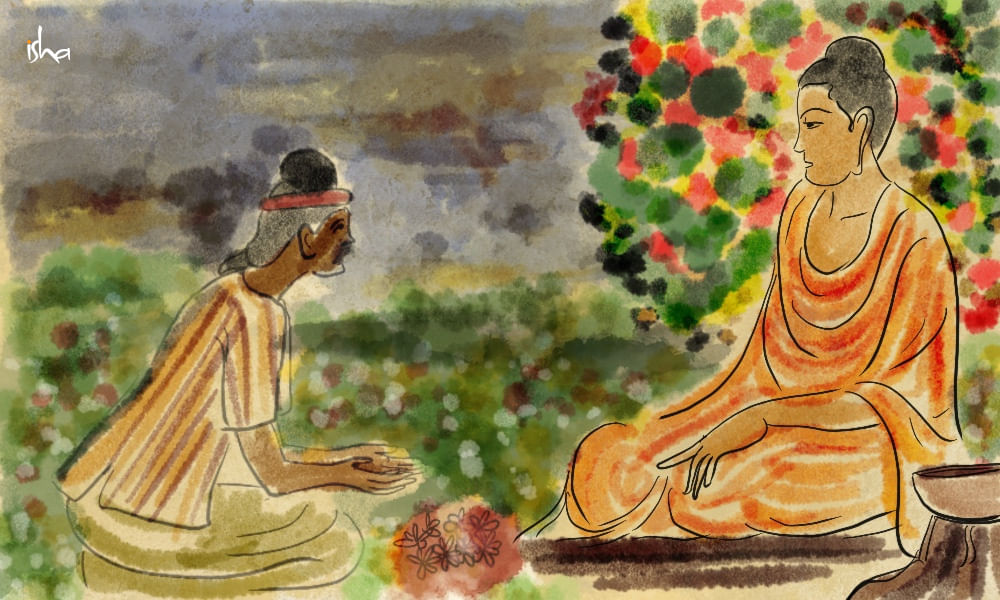
ఒక రోజున, ఒక వ్యక్తి గౌతమ బుద్ధుని చూడడానికి వచ్చాడు. గౌతముడు ఏకాంతంగా ఒక చిన్న ఆవరణలో కూర్చుని ఉన్నాడు, ఆ వ్యక్తి తన రెండు చేతుల నిండా పూలను తీసుకుని వచ్చాడు, ఎందుకంటే అది భారతదేశంలో గురువుకు అభివాదం చేసే విధానం. ఆ వ్యక్తి గౌతమ బుద్ధుడి వైపు వస్తూ ఉండగా, గౌతముడు అతని వైపు చూసి “పడేయి” అన్నాడు. అతను అలా అన్నప్పుడు, సమర్పణగా పూలను తీసుకొచ్చాడు కాబట్టి వాటిని క్రింద పడవేయమని అంటున్నాడేమో అని అతను అనుకున్నాడు. మళ్లీ వీటిని ఎడమచేతిలో తీసుకుని వస్తున్నాను కాబట్టి, బహుశా అది అమంగళమైనదేమో అని అతను అనుకున్నాడు. ఇది కూడా ఈ సంస్కృతిలో భాగమే. మీరు దేన్నయినా మీ ఎడమచేతితో ఇస్తే, దాన్ని అమంగళమైనదిగా భావిస్తారు. కాబట్టి అతను తన ఎడమ చేతిలోని పూలను పడేసి, వినయంగా ముందుకు సాగాడు. గౌతముడు అతని వైపు చూసి మరొకసారి “పడేయి” అన్నాడు. ఇప్పుడు అతనికి ఏం చేయాలో తెలియలేదు, ఈ పూలతో వచ్చిన తప్పేంటి? అతను మిగిలిన పూలను కూడా పడేశాడు. అప్పుడు గౌతముడు, “నేను పడేయమన్నది, పూలను కాదు, ఈ పూలను తెచ్చిన వాడు ఎవడైతే ఉన్నాడో అతన్ని పడేయి.” లేదంటే మీరు బుద్ధుడిని తెలుసుకోలేరు. మీరు వస్తారు, నమస్కారం చేస్తారు, వింటారు, వెళతారు, కానీ మీరు ఆత్మజ్ఞానం పొందిన వ్యక్తితో ఉండటం అంటే ఏంటో తెలుసుకోలేరు. మీరు ఈ సంభావ్యతను పూర్తిగా కోల్పోతారు.
మీరు మీ జీవితంలోకి ఒక పూర్తిగా సరికొత్త పార్శ్వాన్ని తీసుకురావాలి అనుకుంటే, మీరు దాన్ని పడేయాలి, మరొక దాన్ని కాదు. మీ పనిని వదిలేయడం, మీ కుటుంబాన్ని వదిలి వెళ్ళటం, లేదా దీన్ని, దాన్ని వదిలేయటం వల్ల ఏమీ కాదు. ప్రస్తుతం మీరు దేన్నయితే “నేను” అని అంటున్నారో, అది కేవలం ఆలోచనల, భావోద్వేగాల, మనోభావాల, అభిప్రాయాల ఇంకా విశ్వాసాల సమాహారం మాత్రమే. మీరు దాన్ని పడేయకపోతే, ఇక కొత్త సంభావ్యతకు ఆస్కారం ఎక్కడ? మీరు కేవలం పాత వాటినే కొత్త విషయాలతో అలంకరణ చేయాలనుకుంటున్నారా? అది మీకు పని చేయదు. అది విషయాలను మరింత కష్ట తరంగా చేస్తుంది. కానీ మీరు పడేద్దాము అనుకున్నంత మాత్రాన అది పడిపోదు. కాబట్టే ఈ పడిపోవటం అనేది జరిగేలా చేయడానికి అవలంబించ వలసిన విధానాలు, ప్రక్రియలు ఉన్నాయి.
#9. బుద్దుడు ఒక సన్యాసిని ఒక వేశ్య దగ్గరకు ఎందుకు పంపించాడు?
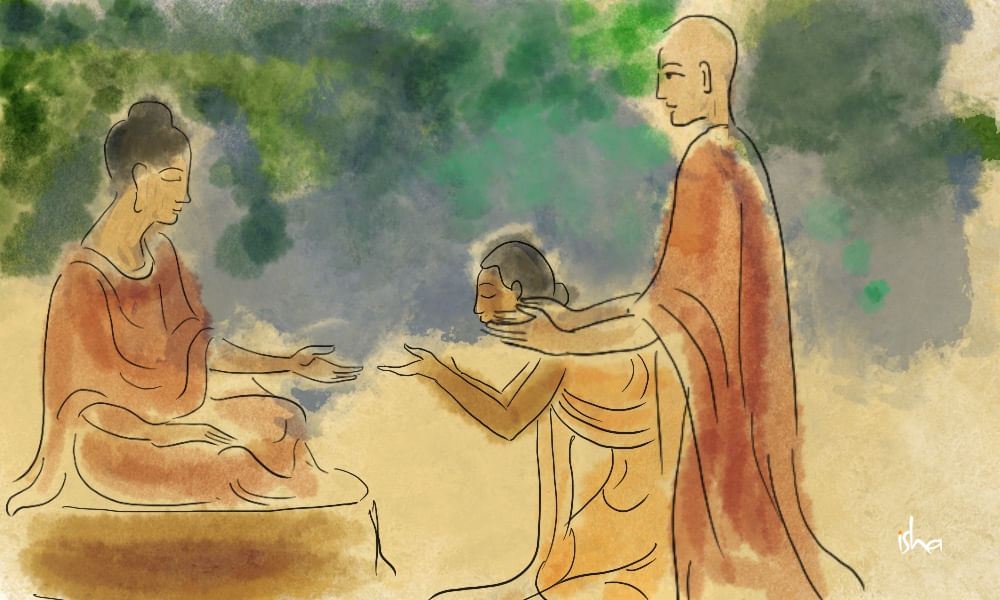
గౌతమ బుద్ధుడు, ఆయన శిష్యులు నిరంతరం గ్రామం నుండి గ్రామానికి, పట్టణం నుండి పట్టణానికి పయనిస్తూనే ఉండేవారు. అతను వెళ్ళినప్పుడల్లా అతనితోపాటు 2000 నుంచి 3000 మంది సన్యాసులు ఉండేవాళ్ళు. వీళ్ళందరూ కూడా తమ ఆహారం కోసం బిక్షాటన చేసే వాళ్ళు. భారతదేశంలోని సంస్కృతి ఏమిటంటే, ఒక ఆధ్యాత్మికుడు మీ ద్వారం వద్దకు వచ్చి ఆహారం కోసం అడిగితే, ఆఖరికి మీ సొంత పిల్లలు తినకపోయినా సరే, మీరు ముందు ఆయనకు ఇవ్వాలి. ప్రజలు ఈ విధంగా ఉన్నప్పుడు అతను రెండు, మూడు వేల మంది సన్యాసులతో ఒక పట్టణంలోకి వెళ్ళినప్పుడల్లా, ఉన్నట్టుండి ఆ పట్టణ వాసుల మీద భారం పడేది. కాబట్టి అతను ఒక నియమం పెట్టాడు, వాళ్లు ఎప్పుడూ ఒకే చోట రెండు, మూడు రోజులకు మించి ఉండకూడదు, ప్రజల మీద భారం పడకుండా ఉండడం కోసం.
ఉత్తర, తూర్పు భారత భూభాగాలలో చాలా ఎక్కువ వర్షం పడుతుంది కాబట్టి, కాలినడకన వర్షాకాలంలో అడవులలో ప్రయాణం చేయడం కష్టం. అలా అడవులలో నడవడం చాలా ప్రమాదకరం, చాలా మంది తమ ప్రాణాలు కోల్పోతారు. అందుకే, ఆ సమయంలో వారు ఏదైనా, ఎక్కువ ఇళ్లు ఉన్న పట్టణంలో బస చేస్తారు.
పగటి పూట ఆ సన్యాసులు భిక్షాటన కోసం వెళ్లేవాళ్లు. ఆనంద తీర్థుడికి ఒక వేశ్య ఎదురయ్యింది. ఆమె అతనికి బిక్ష ఇచ్చి, పొడుగైన, అందమైన అతని వైపు చూసి, “సన్యాసులు ఆశ్రయం కోసం చూస్తున్నారని విన్నాను. మీరు నా ఇంట్లో ఎందుకు ఉండకూడదు?” అంది. ఆనంద తీర్థ, “ఎక్కడ ఉండాలి అనే విషయం నేను బుద్ధుణ్ణి అడగాలి” అన్నాడు. ఆమె చాలా గట్టిగా “ఓ నువ్వు నీ గురువుని అడగాలా? వెళ్లి అతన్ని అడుగు, అతను ఏమంటాడో చూద్దాం!” అంది. ఆనంద, గౌతముడి దగ్గరకు వెళ్లి తను తెచ్చిన భిక్ష అతని కాళ్ల వద్ద ఉంచాడు. ప్రతివారూ వెళ్ళిన చోట, ఆహారాన్ని ఇంకా ఆశ్రయాన్ని వెతుక్కోవడం సంప్రదాయం కాబట్టి, ఆనంద, “ఈ స్త్రీ నన్ను ఆహ్వానిస్తోంది, నేను అక్కడ ఉండవచ్చా?” అని అడిగాడు. గౌతముడు, “ఆవిడ నిన్న ఆహ్వానిస్తున్నప్పుడు, నువ్వు వెళ్లి అక్కడ ఉండి తీరాలి” అన్నాడు. ఆ మాట విన్నప్పుడు అతని చుట్టూ ఉన్న ఆ పట్టణవాసులు వ్యతిరేకించారు. “ఇదేంటి? ఒక సన్యాసి ఒక వేశ్య ఇంట్లో ఉండటమా? అలా అయితే, ఈ ఆధ్యాత్మిక ప్రక్రియ కలుషితమై పోయినట్లే” అన్నారు. గౌతముడు వారి వైపు చూసి, “మీరు ఎందుకు కంగారు పడుతున్నారు? ఆ స్త్రీ అతన్ని ఆహ్వానిస్తోంది. అతన్ని అక్కడ ఉండనివ్వండి. సమస్య ఏంటి?” అన్నాడు.
ప్రజలు లేచి వెళ్ళడం మొదలు పెట్టారు. ఆయన “ఆగండి! నేను ఈ మార్గాన ఉన్నది ఎందుకంటే, జీవించేందుకు అత్యంత విలువైన ఇంకా శక్తివంతమైన విధానంగా నేను దీన్ని చూస్తున్నాను. ఇప్పుడు మీరు నాకు నా విధానాల కన్నా ఆవిడ విధానాలు శక్తివంతమైనవని చెప్తున్నారా? అదే గనుక వాస్తవం అయితే, నేను కూడా వెళ్లి ఆమెతో కలసిపోవాలి. ఒక సత్యాన్వేషిగా ఉండాల్సిన విధానం అదే. మీరు ఏదైనా మరింత ఉన్నతమైనది చూస్తే, మీరు దానికై వెళ్లాలి’’ అంటాడు. ప్రజలకు చాలా కోపం వచ్చింది, చాలామంది వెళ్లిపోయారు కూడా. కాని, ఆనంద ఆవిడతోనే ఉన్నాడు. వర్షాల కారణంగా చలి పెరిగింది. అతను కేవలం ఒక పలుచని వస్త్రం మాత్రమే ధరించి ఉన్నాడు. ఆవిడ అతనికి ఒక చక్కని పట్టు వస్త్రాన్ని ఇచ్చింది. అతను అది కప్పుకున్నాడు. ఇది చూసి, అతను పెడదారి పడడానికి, ప్రజలు దీన్ని రుజువుగా తీసుకున్నారు. ఆమె అతనికై మంచి ఆహారం వండింది, అతను భోజనం చేశాడు. సాయంత్రం ఆమె అతని కోసం నృత్యం చేసింది. అతను అత్యంత ఏకాగ్రతతో చూస్తూ ఉన్నాడు. ప్రజలు ఆ సంగీతాన్ని విన్నప్పుడు వాళ్లు అతను పతనమై పోయాడు అనుకున్నారు. కాలం గడిచింది. వర్షాకాలం అయిపోయాక, ఇక బయలుదేరవలసిన సమయం వచ్చినప్పుడు, ఆనందుడు గౌతమ బుద్ధుడి దగ్గరికి ఒక ఆడ సన్యాసితో వచ్చాడు. ఇది సత్యమార్గంలో ఉండటంలోని శక్తి.
#10. బుద్ధుడిని ఒక తల్లి, తన చనిపోయిన కుమారుడిని బ్రతికించమని అడుగుతుంది
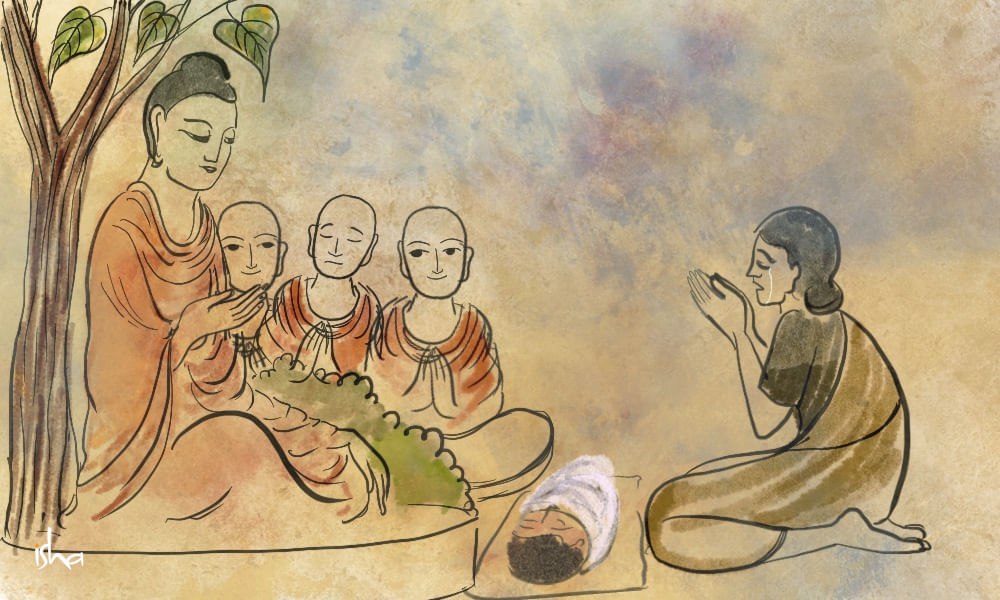
ఒకానొక రోజున, ముగ్గురు పిల్లలు గల స్త్రీ ఒకరు, భర్తను కోల్పోతుంది, ఆమె సహజంగానే శోకంలో మునిగిపోయింది. ఆ తరువాత ఆవిడ ఆ ముగ్గురు పిల్లలే తన ప్రాణంగా చూసుకుంటూ ఉంది. కానీ ఒక సంవత్సరం తర్వాత వారిలో పెద్ద కుమారుడు చనిపోతాడు. ఆ తర్వాత, వెంటనే రెండో కుమారుడు చనిపోతాడు. ఇక తనకు మిగిలిన ఒకే ఒక్క కుమారుణ్ని తన ప్రాణంగా చూసుకుంటూ ఉంటుంది. కానీ ఆ తర్వాత, ఈ పిల్లవాడు కూడా చనిపోతాడు. దీన్ని భరించలేక ఆమె ఆ చిన్న పిల్లవాడి మృత దేహాన్ని తీసుకుని గౌతమబుద్ధుని వద్దకు వస్తుంది. ‘‘మీరు, మీ ఆధ్యాత్మికత అంతా వ్యర్థం. మీరు నా పిల్లవాడిని తిరిగి బ్రతికించకపోతే, అవన్నీ అర్థంలేని విషయాలే. నా భర్త చనిపోయాడు ఎలాగోలా దాన్ని భరించాను. నా మొదటి కుమారుడు చనిపోయాడు, ఆ తర్వాత రెండో వాడు కూడా. అయినా నేను నిలదొక్కుకున్నాను. ఇప్పుడు ఆఖరి కొడుకు కూడా పోయాడు. మీరే గనక నిజమైతే, ఇప్పుడు ఈ పిల్లవాడిని తిరిగి బ్రతికించడం ద్వారా రుజువు చేసుకోండి” అంది.
గౌతముడు ఆమె వంక చూసాడు, భావోద్వేగంతో ఉన్న ఈ స్థితిలో, ఏమి చెప్పినా, ఏమి చేసినా లాభంలేదు అని అతనికి తెలుసు. కాబట్టి అతను, “నేను నీ పిల్లవాడిని తిరిగి బ్రతికిస్తాను. నువ్వు వెళ్లి నాకోసం, అసలు చావే చూడని ఇంటి నుండి కాసిని నువ్వులు తీసుకురా!” అంటాడు. ఈ పిల్లవాడి మృతదేహాన్ని తీసుకొని, అసలు చావే ఎరుగని ఇంటి కోసం వెతుకుతూ, ఇంటింటికీ వెళ్తుంది. పట్టణం మొత్తం తిరిగాక, ఆవిడ ఆ విధంగా ఒక్క ఇల్లు కూడా లేదు అని గ్రహిస్తుంది. ఆవిడ ఆ మృతదేహానికి చేయాల్సిన కర్మలు చేసి, తిరిగి వచ్చి గౌతమబుద్ధుడి ముందు కూర్చుంటుంది. ఆ తర్వాత తన జీవితకాలమంతా ఆమె అతని వద్దే ఉంటుంది.
#11. బుద్దుడు ఎలా చనిపోయాడు
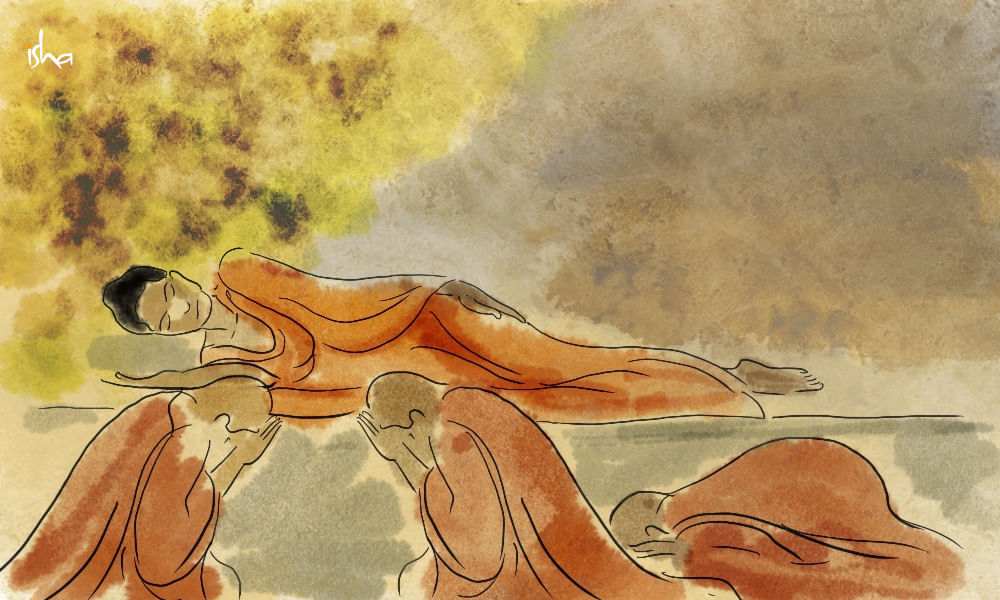
బుద్ధుడు విషప్రయోగం వల్ల చనిపోతాడు. అతని ఆహారంలో విషాన్ని కలుపుతారు, దాన్ని తిన్నాక ఆ విషయం తెలుసుకుంటాడు, ఇంకా దాన్ని తప్పించుకోలేం అని అతనికి తెలుసు. ఆ ఆతిథ్యం ఇచ్చిన వారు బుద్ధునికి, ఇంకా అతనితో పాటు ఉన్న సన్యాసులందరికీ అన్నం వండుతారు. “మీరు నాకు అద్భుతమైన ఆహారం ఇచ్చారు. నేను దాన్ని తీసుకున్నాను. కానీ నా శిష్యులు ఈ ఆహారాన్ని జీర్ణించుకోగలరని నేను అనుకోవడం లేదు. నేను తిన్నాను కాబట్టి, మీరు ఇచ్చిన ఆతిథ్యంతో మీరు సంతృప్తి పడాలి. నా వారికి అది పెట్టకండి” అంటూ ఆయన ఒరిగి పోతాడు. అతను ఇంకా చనిపోలేదు, కానీ అనారోగ్యంతో పడిపోయాడు. శిష్యులు గుమిగూడతారు, ఆయన వాళ్ళతో దీన్ని ఎలా ముందుకు తీసుకువెళ్లాలి అన్న విషయమై కొన్ని సూచనలు ఇస్తాడు. ఎందుకంటే ఆయన ఊహించని విధంగా చివరి దశకు వచ్చాడు. అతను ఇంకొన్ని సంవత్సరాలు బతికి ఉండేవాడు. కాని ఇప్పుడు అతను కూర్చోలేక పోతున్నాడు. పడుకుని మాట్లాడడానికి వీలయ్యేది కాదు. కాబట్టి అతను తన తలకు ఊతం తీసుకొని మాట్లాడాడు. ఆ భంగిమే గౌతముని మహాపరినిర్వాణ భంగిమగా అయింది. బౌద్ధులకు ఆ భంగిమ ఎంతో పవిత్రమైనది. బుద్ధుడు పడుకొని ఉన్న చిత్రాలు ఎన్నో ఉన్నాయి, ఎందుకంటే అతని ఆఖరి సందేశం, ఈ ఉద్యమం ఎలా కొనసాగాలి అన్న దానిపైన అతను మార్గనిర్దేశం చేయడం అనేది ఆ సమయంలోనే జరిగింది. కాబట్టి చాలా మంది బౌద్ధులు ఈ భంగిమలో పడుకోవడం మొదలుపెట్టారు. అది ఒక సంస్కృతి. మీరు ఆ భంగిమను అనుకరించవచ్చు, కానీ మీరు ఒక బుద్దుడు కాలేరు.
Questioner : ప్రశ్న: సద్గురూ, అంటే నేను ఒక బుద్దుడిని కాలేననా ?
Sadhguru : సద్గురు: గౌతముడు ఒక బుద్ధుడిగా కాగలిగినప్పుడు, మీరు ఒక బుద్ధుడిగా ఎందుకు కాలేరు? బుద్ధుడు అంటే బుద్ధికి అతీతమైన వాడు అని. ఇన్నర్ ఇంజినీరింగ్ లోని కృషి అంతా కూడా మిమ్మల్ని ఒక బుద్ధుడిగా చేయడం కోసమే. కొన్ని క్షణాల పాటు మేము మిమ్మల్ని బుద్ధుడిగా చేసాము, ఎందుకంటే కొన్ని క్షణాల పాటు మీరు మీ తర్కానికి అతీతంగా ఉన్నారు. ఇప్పుడు అసలు విషయం అంతా, అక్కడే ఉండడం ఎలా అన్నదే; అక్కడ ఉండడానికి అవసరమైన ఎరుకని తెచ్చుకోవడమే కావలసింది.
Referring to those who conduct death rituals to assist the deceased person’s transition.
Related Tags
- Search Menu
- Advance articles
- Author Guidelines
- Submission Site
- Online Submission Site Instructions
- Open Access
- Why Submit?
- About The Journal of Hindu Studies
- About The Oxford Centre for Hindu Studies
- Editorial Board
- Advertising and Corporate Services
- Journals Career Network
- Self-Archiving Policy
- Dispatch Dates
- Terms and Conditions
- Journals on Oxford Academic
- Books on Oxford Academic

Article Contents
Colonial backdrop: buddhacaritramu by the twin poets, english, the new language of power, the prabandha genre in telugu, brahmin acceptance of buddhist non-violence, gandhian buddhism: saundaranandamu by katuri and pingali, modernist critique of buddhism: buccibabu, brahminic reaction: a jātaka tale by viswanatha satyanarayana, concluding remarks.
- < Previous
Buddhism in Modern Andhra: Literary Representations from Telugu
- Article contents
- Figures & tables
- Supplementary Data
Velcheru Narayana Rao, Buddhism in Modern Andhra: Literary Representations from Telugu , The Journal of Hindu Studies , Volume 1, Issue 1-2, 16 October 2008, Pages 93–119, https://doi.org/10.1093/jhs/hin005
- Permissions Icon Permissions
This essay explores the hermeneutics of modern Buddhism in colonial and post-colonial Andhra, the Telugu speaking area of India. Using four literary works in Telugu: Buddhacaritramu by Chellapilla Venkata Sastri and Divakarla Tirupati Sastri (known as the Twin Poets), Saundaranandamu by Pingali and Katuri, a play Tiṣyarakṣita by Buccibabu, and a short poem entitled ‘A Jataka Tale’ by Viswanatha Satyanarayana, the essay attempts to interpret each of the works in view of the social, political, and cultural background in which they were written. Each writer is introduced with brief information about his life and works, and each of the works is analysed for its literary ideology and impact. None of the writers were Buddhists and their works did not lead to a revival of Buddhism as a religion either.
The essay argues that two of the above works, Buddhacaritramu and Saundaranandamu, written under the influence of Edwin Arnold and Mahatma Gandhi, create a modern version of Buddhism that blends into a modern Hinduism. The essay also describes how the Nehruvian ideology of Indian nationalism incorporates both religions as integral parts of India's great culture. The play by Buccibabu and ‘A Jataka Tale’ by Viswanatha Satyanarayana attempt a critique of Buddhism from a modernist and Brahminic point of view respectively, but they have not made a serious difference to the general nationalist approval of Buddhism.
On 30 January 1948, the news that Gandhi had been assassinated by a Hindu fanatic named Nathuram Vinayak Godse was broadcast through the All India Radio station. Within minutes, along with the details of the news, the well-known excerpt from the Bhagavadgīta could be heard on the airwaves: 1
yadā yadā hi dharmasya glānir bhavati bhārata , abhyuttānam adharmasya tadātmānam sṛjāmy aham paritrāṇāya sādhūnām vināśāya ca duṣkṛtām dharmasamsthāpanârthāya sambhavāmi yuge yuge
Son of Bharata, whenever there is a decline in dharma , and the absence of dharma increases, I create myself.
I come into being from age to age with the purpose of fixing dharma – as a refuge for those who do good and as a doom for those who do evil.
The idea is clear: The Mahatma is seen as an incarnation of the god Vishnu born to free India from the non- dharmic rule of the English. But when oleographs of Gandhi's images started to appear in the market–the choice of equating Vishnu with Gandhi did not work. The painters of Gandhi images were unable to come up with any Avatar of Vishnu that was non-violent, and they invariably painted Buddha in the background with Gandhi in the foreground, both blessing the people of India from up above in the sky.
A year earlier, when India's new government chose the symbols of the nation, the Ashokan chakra on the national flag and the lion capital as the seal, no one objected. Using clear Hindu symbols, on the other hand, would have been objectionable to the Muslims, Christians, Sikhs, and a number of secular-minded people. One way of avoiding religion in national symbols was to adopt Buddhist images almost as if they represented not a religion but a culture. 2 Long before these Buddhist symbols came to be acceptable as national symbols, Buddhist themes became popular in literature. Andhra is known for its Buddhist monuments, which take the memory of Buddhism back to the second century before the common era. Modern Telugu people are constantly reminded of their Buddhist past by the great monuments at Nagarjunakonda, Amaravati, and a large number of other sites. However, nothing by way of the written word from this past has survived. 3 In the early 20th century, during the colonial period, Buddhism was (re)introduced to Telugu literature via Britain, through English. In this paper, I want to explore the hermeneutics of these new writings on Buddhist themes in Telugu literature during the course of the 20th century, and how poets and writers shaped the modern understanding of Buddhism among Telugu people.
There are two striking facts related to Buddhism in the history of 20th century Telugu literature. One: an unusually large number of poets and writers wrote on Buddhist themes. Two: none of them were Buddhists. Nor did their works lead to anything like a revival of Buddhism in Andhra. I wish to examine four literary texts–three poems, and a play–written by major poets and writers in the 20th century and ask two questions of each of them: What were the reasons that led the authors to choose the Buddhist theme, and what was the meaning their readers derived from their work? I will introduce the writers briefly with some biographical information, locating their place in modern Telugu literary history, and discuss in detail the Buddhist-themed texts they wrote and their impact on readers of the time.
Buddhacaritramu is the result of collaboration between Venkata Sastri ( 1870–1950) and Tirupati Sastri (1872–1920 ) 4 . Together they called themselves Tirupati–Venkata poets (hereafter, Twin Poets). As a team they were a powerful influence on Telugu literature during the first half of the 20th century. They developed a genre called śatāvadhānam . The two of them would stand before one hundred scholars and poets and respond orally to their requests in verses created on the spot. The requests included riddles to be solved, verses to be composed in a particular metre describing some theme, person, or event, using specially chosen words which often were not easy to weave into the verse. The poets were to take up each request and give their responses in verse. They composed the verse together, i.e. if one poet composed the first line, the other would compose the next. By the end of the event, they would both recite all the verses in the order in which they had been requested. This new performance genre–called śatāvadhānam, because it demanded, avadhāna , attention, to śata , one hundred [people]–became famous. They were received by scholars and poets all over the state and zamindars awarded them their choicest honours. The Twin Poets were not just collaborators; they were friends who behaved as if they were one person living in two bodies. Their friendship was such that after the death of Tirupati Sastri, Venkata Sastri continued to publish his own work under their collective name: Tirupati–Venkata poets.
Neither Venkata Sastri nor his collaborator Tirupati Sastri knew much English; their strength was in their Telugu and Sanskrit in which they were great scholars. Their extemporaneous poems were so popular that they were memorized and quoted by educated people in conversation. Verses from their plays based on the Mahabharata theme were remembered and sung even by peasants and farmhands in villages. 5
For most of their lives, Venkata Sastri and Tirupati Sastri did not have stable jobs. Their major patrons were Telugu zamindars, who were scattered all over Andhra. One such zamindar was Krishna Rao of the Koccerlakota family. A Brahmin, he was educated in English and even had a BA degree, which was considered a very high degree in those days. He read English literature and developed a taste for it. During this time, the early 1900s, Edwin Arnold's biography of Buddha, The Light of Asia , was enjoying an unusual degree of popularity among English-educated Indians. If you did not appreciate The Light of Asia , you were not considered a person of good taste. Indians were coming to recognise the greatness of their culture through the eyes of European and British scholars and savants who had developed a deep interest and admiration in things Indian. Those who had earlier accepted the colonial message that India was a decadent and downtrodden country that needed the help of the British to be civilised began to see a new respect and admiration for their own culture in Western writings about India. Edwin Arnold's The Light of Asia came at exactly the right time to appeal to this clientele.
Krishna Rao wanted the Twin Poets to translate The Light of Asia 6 into Telugu for him. 7 The Twin Poets were rigorous Smārta Brahmins who lived by the traditions and ritual conventions that their families had practised for generations. They grew up in an atmosphere where ‘Buddhist’ was the harshest term fathers could hurl against their sons when young boys deviated from strict Brahminic practices. Furthermore, the poets were scholars who had studied Śankara's Advaita Vedānta and knew that Buddha was unacceptable to Brahmins because he rejected the authority of the Veda. This was the background in which the Twin Poets wrote the Buddhacaritramu –the life of Buddha.
It is interesting to speculate why the Twin Poets should have agreed to create a Telugu version of Buddhacaritramu , and that too using an English source, a language they did not control as well as Sanskrit, when Aśvaghoṣa's poem about Buddha's life, Buddhacarita , was easily accessible to them.
One obvious reason for not following Aśvaghoṣa is that he was not popular among Telugu scholars of Sanskrit. His Buddhacarita was not considered much of a kāvya by pundits who favoured Kalidasa, Bhavabhuti, Murari, and such illustrious kāvya poets. For more substantial reasons, one has to look into the contemporary political situation, with its historical and cultural components.
It is well known that the British Raj wisely distanced itself from Christian missionary activities. It shrewdly left the Brahmins free to practise their religion without governmental interference, and even patronised Hindu temples. Most Brahmins found no difficulty in allowing the British to take over the symbolic role of the Kshatriya in the Sanskritic four- varṇa order, as long as they, the British, let the Brahmins be Brahmins without question. In the early days of the Raj, Brahmins were very supportive of the government and even enjoyed munificent administrative positions under the Raj. They quickly learned English and played the courtier to the new kings.
The Brahmin poets under the patronage of zamindars found no contradiction in accepting Queen Victoria and, later, King George V as their monarchs and praising them in the traditional style reserved for great Hindu emperors of the past. The zamindars provided a comfortable space for traditional Brahmin pundits and poets who continued to live in the imagined world of the glorious patron-king relationship familiar from the remembered history of South India. Long ago, in the sixteenth century, Emperor Krishnadevaraya held court in his assembly hall called Bhuvana-vijayam –‘Conquest of the World’–with his eight poets called aṣṭa diggajas , after the eight mythological cardinal elephants that kept the earth stable. The symbol suggests that the poets supported the empire through poetry, with their emperor enthroned in the centre. This symbol endured historical scrutiny and was firmly implanted in the minds of educated Telugu people. For Brahmin poets who were supported by one of these zamindars, their imagined world continued undisturbed.
Following the trend of the times, the Twin Poets travelled from one zamindar to another seeking support. They imagined themselves in the role of great poets like Srīnātha of the fourteenth century who travelled from king to king, patron to patron, reciting his poems for them and receiving honours including gajārohaṇa , being paraded through the town on an elephant. As was conventional with poets of the past, the Twin Poets also generated for their zamindari patrons an imagined status as great kings. For instance, the language which the Twin Poets use to describe their patron Krishna Rao unmistakably announces the glory they imagine for him. They call him Krishṇarātprabhū, Lord Krishna Rao, and Krishṇarāḍbiḍauja, Krishna Rao who is like Indra the king of gods, and so on. Furthermore, taking advantage of the similarity in name between the zamindar Krishna Rao and the sixteenth century monarch Krishna-deva-raya, the Twin Poets wrote:
Though the victorious Krishna-raya ruled his kingdom on the shores of the river Tungabhadra and supported a number of great poets, he was not happy because he was born as the son of a servant maid–so he was born again in a Brahmin family, as Krishna Rao, to rule his kingdom from the shores of the river Godavari.
There is a folk legend that Krishnadevaraya was born to a maidservant. His father was told by a sage to make love to his wife at a certain auspicious moment so a great warrior would be born. When his wife delayed coming to bed, he made love to a nearby maid so as not to let the auspicious moment pass.
Despite the glorious images the Twin Poets imagined for the zamindars, and in turn for themselves, the zamindars were hardly more than tax farmers, and the poets hardly more than everyday supplicants. Zamindars leased land from the British government and paid a fixed amount of money agreed upon at the time of lease. They enjoyed the trappings of kings sporting titles such as ‘Raja’ or, if the British Government permitted, even more glorious titles such as Maharaja, (as in the case of the Maharaja of Vizianagaram). They had no real political power and their crowns, if they wore them, were ‘hollow’, to borrow a phrase from Dirks ( 1987 ). These zamindars came in all shapes and sizes. Some of them were very learned in the two trans-regional languages of high culture, Sanskrit and Persian, and had a good English education as well. But most of them had a smattering of Sanskrit and Telugu and an English education from one of the newly established British-style colleges. Most zamindars came from land-owning castes such as Velama and Kamma, but there were a few from traditionally non-land-owning castes such as Brahmin and Vaisya. Not all zamindars were of the same status. Some, like the Maharaja of Vizianagaram, had their own kingdoms before the British took away their troops and reduced them to tax farmers. They had relatively richer properties in addition to recognition as ‘kings’ of their area. Other newer zamindars, like Krishna Rao, were upwardly mobile wealthy people who acquired their position by courting the favours of local British officers.
No matter what the origin, caste, or source of wealth of these zamindars, they were all uniformly loyal to the British raj. They were obedient servants of the British royalty, whose authority and glory they obeyed and celebrated. They invariably hung royal portraits in their court halls and made sure they paid appropriate tributes on every important occasion, such as birthdays. During the coronation of King George V, these zamindars had their court poets write poems for the king and the queen, wishing them a long and healthy life. Poems written in ornate Telugu with high-flown Sanskrit vocabulary, applying to the British royals the same epithets that were once used to celebrate great Hindu emperors such as Krishna-deva-raya, would of course make no sense to an English-speaking Christian monarch sitting in Buckingham palace in London, even assuming that the poems reached His Majesty, which they did not. Some of the best poets of the time, including the Twin Poets, wrote such poems.
While playing loyal courtier to the British King, some of these zamindars felt a faint sense of pride in their own culture. Politically, they were loyal to the British, and culturally they were getting closer to Western styles of living. They were pleased when Sanskrit scholars and Telugu poets addressed them with Sanskritic titles and praised them as if they were kings wearing a crown, while they themselves were dressed in suits, played cricket, spoke English, and enjoyed the company of white men and women. Thus they lived in two worlds, with a deep respect for Hindu/Indian culture and a sense of pride in it, and a fascination for the West. At this juncture, when Orientalist British and German scholars themselves came to admire India's great culture, these zamindars hailed them enthusiastically. For instance, publication of Max Mueller's translation of the Rig Veda was underwritten by the Maharajah of Vizianagaram.
The three gods, Siva, Vishnu and Brahma are like the Governors, The minor gods are the lower level officials, The great island Maṇidvīpa is like London, And she herself is Her Majesty the Queen, May she, the Great Goddess who rules the world, Protect Krishna Rao with compassion.
For the Twin Poets, the location of London and the titles Queen and Governor enhance even the position of the Goddess of the universe and of the gods that surround her. This is the background to the Twin Poets' acceptance of Arnold's Light of Asia in preference to Aśvaghoṣa's Buddhacarita in writing their Buddhacaritramu.
As I will show later, Arnold's poem, once the Twin Poets began to translate it, transformed them, as it did many of its readers at the time. 8 But before we see how the English poem transformed the Twin Poet's ideas, let me outline the features of the Telugu prabandha genre, which the Twin Poets chose for their translation of Arnold's The Light of Asia , and the main problems they faced in conforming to the conventions of that genre.
a young woman, graceful as a golden goose, eyes like petals of a fresh lotus blossom, breasts towering and round, body fragrant as campak flowers, her face veiled by shyness, Yaśodhara – with a lovely lower lip.
She stands before him and, as if she knew him well, asks with an intimate tone,
Where are my gifts–give them and I've got to go. 9
Siddhartha smiles and sees that all the gifts are gone, and says: 10
“Woman with beautiful eyes! The gifts are given away, but here is one that no one else deserves”. He was speaking in a special way. As everyone looked on, he took a chain of emeralds from his neck and placed it around hers with his own hands.
Despite the prabandha requirements, the Twin Poets handle śṛngāra , the erotic mood, minimally so as not to compromise the main theme of the book, which depends on śānta, the mood of peace.
There is another area where the Twin Poets made a major change. While they follow Arnold's narrative fairly faithfully, they do not even mention Arnold's name. Instead they mention Aśvaghoṣa's Buddhacarita as their source. To a modern reader it is clear plagiarism not to acknowledge Arnold, and a lie to give the credit to Aśvaghoṣa. This is where we should take a careful look at the conventions of prabandha.
The template of a prabandha requires that it should begin with a prayer to the gods, blessings to the patron of the work for whom it is recited in court, detailed praise to the great Sanskrit and Telugu poets of the past (pūrva-kavi-stuti), and a censure of bad poets (kukavi-ninda) . This is followed by a full description of the family of the patron. The poet then narrates in detail the occasion in which the patron has requested a specific poem to be written for him by giving the poet betel leaves (and gold) and thus sealing the commission. The prabandha is courtly poetry, and its conventions require that the patron be described as a king. This template has been in place for at least nine hundred years, from the time Rājarāja Narendra, the Cāḷukya king of Vengi, requested his court poet Nannaya to compose in Telugu the Mahābhārata ‘spoken’ in Sanskrit by Vyāsa. Such a time-honoured template requires that the patron ask his poet to take a Sanskrit text as his original in order to compose his Telugu poem. Because the convention was so rigid, a Sanskrit book was always presented as the original even when it was not really followed. Clearly this tradition would not allow an English poem to be brought into the picture. That would be unacceptable and literarily jarring. Everyone in the literary community knew for a fact that the Twin Poets were commissioned by their patron Krishna Rao to compose a Telugu poem based on Edwin Arnold's The Light of Asia . 11 Venkata Sastri himself says in his autobiography (which he wrote in verse in third person as if someone else wrote it)
ātaḍ' inglīṣu bhāsalon āranālḍu kavi raciñcina buddhuni katanu dĕlgu jesi kṛti tanak immani vāsiy alara gorě tirpati venkaṭa dhīra kavula.
‘Make into Telugu the story of the Buddha written by Aranālḍu [Arnold] in the English language and dedicate it to me’. That's what zamindar Krishna Rao asked of the Tirupati–Venkata poets. 12
The mention of Aśvaghoṣa in the preface to the Telugu poem is, as they say in Telugu, śastrāniki , to respect the convention. 13 The Twin Poets leave themselves room to bring Arnold in when they say that Krishna Rao commissioned them to ‘write the life story of Buddha following Aśvaghoṣa and others’. The tag ‘and others’ allows the Twin Poets to bring in Arnold without a problem.
One tricky point the poets faced relates to the ideal of Buddhist non-violence. One day, Bimbisāra orders a large number of goats to be slaughtered for a Vedic ritual. When Buddha sees the shepherds driving their goats from the pasture into the city earlier than their usual time, he asks why they are rushing back so soon and finds out that king Bimbisāra has ordered them to bring the goats for the ritual. Buddha, who is himself carrying a wounded goat on his shoulders in order to nurture it back to health, asks to go with them. He arrives at the ritual place where the Vedic priest is chanting the mantras and is about to raise his knife to cut off the head of a goat. Buddha dramatically stops him from bringing the knife down on the goat's neck and lectures Bimbisāra on the virtues of non-violence. Convinced that violence is wrong, Bimbisāra announces by way of an inscription that people thereafter should avoid killing animals, eating meat, and so on.
The Twin Poets adopt Arnold's description of the sacrifice very faithfully. However, powerful as this description is, it poses two problems. First, from a Brahminic perspective, ritual killing is not violence; and second, this is not the way an animal is killed at a Vedic sacrifice. What Arnold describes is the way an animal is killed for a village goddess. It is very likely that Arnold had seen such ritual sacrifices at village goddess shrines during his time in India. Technically speaking, no animal is killed with a knife in a Vedic sacrifice. It is smothered to death, spilling no blood. As David Knipe says in his seminal essays on Vedic practices in the Konasima area of Andhra Pradesh, paśubandha is practised even today by Vedic Brahmins in their śrauta rituals such as Paundarīka or other forms of the Agnicayana. 14
One might ask how these nuances were lost on the Twin Poets who were traditional Brahmins. They were the least Westernised among the Telugu poets of the 20th century. They dressed in the most conventional Brahmin way, without a shirt and with a śāluva, shawl, on their shoulders. They wore their sacred thread visibly across their chest, strictly observed restrictions on food, and meticulously followed their daily ritual observations. They were the most Brahmin of the Brahmin poets of the time. Given their lifestyle, religious learning, and knowledge about the ritual killing of animals, one might wonder why the Twin Poets found no difficulty in translating Arnold verbatim, representing all killing as violence and furthermore overlooking the technical difference between eṭa , killing of an animal at a village goddess shrine, and paśubandha the killing of an animal at a Vedic ritual.
In an essay published in 1944, some forty-two years after the publication of Buddhacaritramu, Chellapilla Venkata Sastri, the senior of the Twin Poets who survived his partner by several decades, writes thoughtfully on the concept of violence. He quotes from the Mahabharata to show that killing animals at Vedic rituals was not acceptable to some great sages of the past. He admits that Manu says in his Dharmasastra that eating meat is not wrong ( na māmsabhakṣan,e doṣam ) but interprets it as a statement for the times ‘because everyone was eating meat at that time’. After reflecting on the pros and cons of the issue, he finally declares that animal killing is cruel even if it is accepted by the Vedas. He unequivocally concludes that following the teaching of Buddha in this matter is the right thing to do. 15
Traditionally, Brahmins in South India are strictly vegetarians. They do not kill animals for food, nor do they eat the meat of animals killed by others, as Buddhists do. Their vegetarianism is so strict that they do not even go near a place where meat is being cooked, nor do they sit by the side of a person eating meat. In this sense, South Indian Brahmins are stricter vegetarians than Buddhists. Any suggestion that Vedic Brahmins ate meat and had cows killed to feed honoured guests would be repulsive to a South Indian Brahmin even if it were to be factually correct. 16 That ritual killing of animals was practised by a few Vedic Brahmin families in the secluded area of Konasima, as discussed by Knipe, was not common knowledge among all Brahmins. While the Vedas and Vedic rituals are generally glorified in Sanskrit and Telugu literary texts, the practice of killing animals at one of those rituals does not find detailed description in any of them. 17 For all practical purposes, the vegetarian Brahmins who chanted the Veda had virtually erased from their minds the idea that animals were killed at Vedic rituals and would not even know what method of killing was adopted. The only killing they would be aware of was the one low-caste people practised at a village goddess shrine.
It would therefore make sense to assume that the Twin Poets did not find it difficult to describe killing at Vedic rituals as violence and, since they apparently were not mindful of the technical difference between the Vedic paśubanda and village eṭa , went along with Arnold's description of animal sacrifice. In their mind non-violence was a Brahminic virtue as well. Generations of vegetarianism in their families easily confirmed this conclusion.
In his autobiography, Venkata Sastri describes his meeting in Madras with Annie Besant, the Irish leader of the Theosophical movement, who was hugely popular for her lectures on Hinduism among the English-educated elite. Venkata Sastri and his collaborator were mesmerised by her knowledge of Hindu religious texts and her admiration for Hinduism. The brief description Venkata Sastri gives of this meeting does not offer enough scope to measure the impact she might have had on the minds of the poets when they were young, but we do know that Theosophy's appreciation of Hinduism did not include the killing of animals at Vedic sacrifices. Furthermore, western influences on the interpretation of Hinduism and Buddhism were in the air as the Twin Poets began to move among the modern elites. Arnold's The Light of Asia clearly added to the new perspective the Twin Poets were developing. The way they blend Buddhist and Hindu concepts in their work seems to result from their understanding of the two religions as partners in peace and spirituality.
In this context it is also noteworthy that the Twin Poets detach themselves from the Hindu representation of Buddha as one of the ten avatars of Vishnu. According to this story, Vishnu is born as Buddha to willfully misguide the anti-gods to despise the Vedas and the Upanishads and to seduce their wives so as to deprive them of their pātivratya , the power of a faithful wife. When the wives lose their chastity, their husbands lose in their battle with the gods. This story, retold in poetry and song, and represented in sculpture for at least six centuries, was already losing its impact on educated minds by the time the Twin Poets wrote their work. 18 The Twin Poets would remember the negative description of Buddha as an avatar of Vishnu from the many Telugu prabandhas they knew so well that they could recite verses from them from memory. We can only conclude that they avoided any reference to that story, not only because it would be inappropriate in the text they were translating but because it was distasteful to them.
The Twin Poets smoothly pass over difficult areas where Buddhism differs from Hinduism. For instance, when Buddha, in one of his discourses, raises the question of whether there is an ātman that survives the body, the Twin Poets do not pay critical attention to the issue. They present the idea as a seamless part of a flowing narrative, and make it appear fairly non-controversial. 19 They use words such as dharma , karma, śānti , and ahimsā , throughout the poem without subjecting the concepts to serious examination that would sharpen the differences between their Brahminic and Buddhist meanings. The poets even describe the Buddhist way as jñāna mārga , the path of knowledge, giving the impression that it is similar to one of the many paths available in Brahminic teachings. This gives rise to the impression that what Buddha said was not all that different from what the Brahminic sages taught. This may appear like interpretive fuzziness, but I suggest that the Twin Poets deliberately adopt this new hermeneutics. Equating concepts represented by a terminology shared by Brahminism and Buddhism allows for a new Brahminism which accepts Buddha's teaching and a new Buddhism that finds Brahminism not too alien. The fact that such representation of Buddha's teachings was not found objectionable by scholars of the time suggests that the Twin Poets were not seen as too radical. At the end of the poem the Twin Poets have a confession to make:
Śankara was angry with this religion and crushed it, but still Buddhism flourishes in the world at large. If you put all the people in the world who follow other religions on one side of the scales and the Buddhists on the other side, the needle will tilt towards the Buddhists. Among all the religions in the world, Buddhism stands superior even today. The reason is because this religion teaches compassion to all living beings, and that's why it wins. 20
This is an extraordinary statement from Brahmin scholar poets who grew up in traditional Brahmin families. If we recall that ‘Buddhist’ was a curse word in their community during their childhood, they have travelled far indeed, as has the society around them.
The next generation of poets came under the influence of Gandhi and were sympathetic to the national movement that he was leading against the British. Among them were Katuri Venkateswara Rao (1895–1962) and Pingali Lakshmikantam(1894–1972), hereafter Katuri and Pingali, who were students of Chellapilla Venkata Sastri. In fact, nearly all major poets who came into the literary field during the 1930s were Venkata Sastri's students. The Twin poets were an inspiration and a role model for many poets of this generation. Imitating them, a number of young poets paired up in teams of two to compose their works. Following the trend, Katuri Venkateswara Rao and Pingali Lakshmikantam together wrote Saundaranandamu 21 in Telugu based on Aśvaghoṣa's Sanskrit poem. Both Katuri and Pingali were trained by traditional pundits in Sanskrit and Telugu, and Pingali was educated in English as well. Katuri, who was independently wealthy, did not need a paid job, but Pingali served as a Professor of Telugu at Andhra University and later at Sri Venkateswara University.
Although they were students of Chellapilla Venkata Sastri, they were powerfully drawn into the new poetry movement famously known as Bhāvakavitvam, (poetry of feeling). The Bhāvakavitvam movement was a response to the pundits' control of grammars and restrictions on poetry by means of an outdated alamkāra śastra –also a protest against the prabandhas which described the female anatomy, limb by limb, from head to foot, breasts and pubic hair included. The modern poets felt that an excess of interest in the female body left no room for a woman's feelings. Prema , love, in the Bhāvakavitvam vocabulary, replaced kāma , desire, in the prabandha poems. Through Bhāvakavitvam, Katuri and Pingali were exposed to the literary influence of Tagore, whose poetry emphasises love. Tagore's philosophy of love is that it should be unblemished by desire and sensuousness and find meaning in celebrating beauty. Tagore's God is in the heart of one who loves beauty. 22
Politically, Katuri was a Gandhian. Gandhi was leading a peaceful satyagraha against the British, and his message of service to the poor and downtrodden appealed to the Telugu poet. Katuri wrote some of the best poems in modern Telugu literature celebrating the entry of untouchables into the famous temple of Venkateswara at Tirupati. Pingali's political sympathies are not so clearly evident, but he was willing to be led by Katuri, who many of his contemporaries thought was the better poet of the two. 23 Two things led Katuri and Pingali to choose the theme of Saundarananda: the Gandhian philosophy of service to the poor and the downtrodden, and the Bhāvakavitvam philosophy of love free from eroticism. Neither of them were particularly Buddhist, and the poets themselves were not interested in the serious Buddhist teachings of the Sanskrit text. It is understandable that they borrowed the theme but none of the details of the narrative of Aśvaghoṣa.
Katuri and Pingali did not even mention Aśvaghoṣa's name in their work. All they needed was the title and the theme. They did not write a prabandha, as the Twin Poets had. During the Bhāvakavitvam period, the prabandha genre, with its erotic overtones, was out of favour. Instead, they created a new genre that, unlike the prabandha, enters the narrative right at the beginning and does not have room to acknowledge any sources, much less to describe the context in which the poets came to compose the work. They dedicated their book to their teacher, Chellapilla Venkata Sastri, on his sixtieth birthday as a tribute to ‘the one who created a whole world of modern poets’. However, it is common knowledge among the literary community that Katuri and Pingali had Aśvaghoṣa as their source. 24
The theme of Saundaranandamu is simple. Nanda, the younger brother of Buddha, is passionately involved with his beautiful wife Sundari, and spends every minute of his life in her presence. Sundari is everything to him. One day, Buddha comes to his door begging for food ( bhiksha ), and Nanda and Sundari, lost in each other, fail to notice. When Buddha does not get a response, he moves on to another house. Nanda realises his terrible mistake. He promises his wife that he will be back before the makeup he has applied to her face dries, and runs out to catch up with Buddha and bring him back to his house. Buddha sees his brother and without a word puts his begging bowl in his brother's hands and keeps on walking. Fearing to ask him for permission to leave, Nanda obediently follows, with Buddha's begging bowl in hand, all the time worried about his beloved at home.
Soon he finds himself in Buddha's monastery, where the monks forcefully shave his head, give him ochre robes, and ordain him while he violently kicks and screams. The next chapter describes how Sundari, so suddenly separated from her lover, becomes intensely distressed by his absence and questions his love for her. The servants tell her that they have seen him in the monastery. Unable to believe that her husband has become a monk out of his own volition, she concludes that Buddha has forced him to convert. She accuses Buddha of ruining her life and that of her husband. At the monastery, Nanda is grieving endlessly, missing his loving companion, when Buddha comes to see him. Nanda tells Buddha that his love for Sundari is not infatuation, it is a love that would brighten their world and make it a beautiful place to live in. Buddha insists that this love is rooted in passion and gives Nanda a sermon on celibacy and freedom from desire. After this eloquent speech Nanda appears to be persuaded and asks Buddha if Sundari could also be ordained, if she accepts the principles of celibacy. On Buddha's invitation Sundari is ordained and begins to serve the poor.
The narrative ends with a poignant scene where Sundari and Nanda find themselves at the bedside of a dying poor woman in an untouchable colony. They are about to call each other ‘my love’ but stop before they even complete the first syllable and instead say, ‘I surrender to Buddha’. Before she dies, the poor woman puts her little son's hand in Sundari's and her little daughter's hand in Nanda's, thus entrusting her children to them. Suddenly Buddha appears and says that even though he had separated them from each other, he is now giving a new Nanda to Sundari to raise as her little brother and a new Sundari to Nanda to raise as his little sister. The poem ends with Nanda and Sundari joyfully singing the praises of Buddha.
Compared to Aśvaghoṣa's Saundarananda 25 the Telugu Saundaranandamu reads like a romantic tale with a Buddhist flavour. The Sanskrit poem is a serious Buddhist text with relentlessly harsh Buddhist teachings. Following Nanda's forceful induction into the monastery, a monk lectures him about how unreliable, selfish, wicked, and cruel women are. Buddha takes him to heaven and shows him all the beautiful apsarasas . Nanda falls madly in love with them. But he finally realises that his desire and the handsomeness of his body are the main obstacles to nirvāṇa when he sees that even the enjoyment of pleasures with the apsarasas in heaven is a part of the cycle of rebirth and death.
Saundaranandamu was considered good poetry in Telugu and received praise soon after its publication. The carefully carved poems and the soft, smooth words that make up each stanza appealed to readers who appreciated its lyricism. A controversy about whether it worked as poetry because it combined śṛngāra (eroticism) and śānta (peace), two rasas that should never be combined, was limited to a small circle of critics and did not damage the poem's literary standing.
To a more modern taste, the work might sound sentimental and unconvincing, but in the 1930s when it was published it was received as a poem with a noble message. It appealed to the educated middle class who admired Gandhi's vow of celibacy ( brahmacarya ) , his philosophy of truth and non-violence, and his call to work for the uplift of the untouchables. In the mind of this new class, Gandhi and Buddha were easily associated together and became symbols of modern India. The untouchable colony reminded readers of actual untouchable colonies in Indian villages, with lepers and beggars looking for food on filthy and narrow streets filled with stray dogs and pigs. There is a subtle influence of Christian values in the description of Sundari serving the sick and the poor. Even the image of Buddha depicted in the poem as he preaches to the people on the streets of Kapilavastu is reminiscent of the Christian evangelists. However, the shared ethos with Christianity was not noticed by contemporary readers, and the poets themselves were unaware of it, apparently because in their minds it was inseparably mixed with the Gandhian message of service to the poor. 26 Gradually, an image of Buddhism as the religion of peace, and Buddhist monks as selfless servants of the poor and suffering masses, became popular. Buddhism was now accepted as a clean form of Hinduism, free from its caste hierarchies and the blemish of treating some members of the religion as untouchables, as Gandhi himself believed Hinduism should be.
By the mid-1930s, a new wave of critical realism became popular in Telugu. Writers and poets rewrote the epics and Purāṇas radically reinterpreting them and revising the conventional reading of problematic incidents and negative characters. These writers took tremendous risks in opening up gaps in the established meanings of classical texts. They questioned the moral stance of heroes like Rama in the Rāmāyaṇa . Sita, who suffered hardships in the original Rāmāyaṇa , received a more sympathetic treatment in their works. The more radical writers among them even had Sīta reject Rāma and declare her love for Rāvaṇa.
In this vein of critical realism, Buccibabu's play Tiṣyarakṣita (1940) 27 is a direct indictment of Buddhism and everything it stood for. The play was broadcast on All India Radio at a time when the euphoria about Buddha as a messenger of peace reverberated in poetry, theater, and film; and images of Buddha appeared in many drawing rooms of modern, educated Indians. Next in popularity was Ashoka, described in history textbooks as an emperor who chose peace, renouncing war after his victory. He was so remorseful for the violence he caused that he turned to Buddhism. He was represented as a popular emperor who ruled over a welfare state. A routine line from school textbooks in those days said that he planted trees on the roadside to provide shade for travellers.
One would think that a play which shattered popular positive images of Buddha and Ashoka would stand out as a good candidate for condemnation. Surprisingly, there was no serious negative reaction to it. Rather, it was received with appreciation. Listeners of the radio play (and readers when a longer version of it was published in 1964) 28 took it as an interesting story that revealed the darker side of a famous emperor known for his good work. It was appreciated as a human drama that depicts some of the complex psychological problems in history.
Buccibabu (1916–67), whose birth name was Sivaraju Venkata Subbarao, was educated in English literature and taught English in college before he worked for All India Radio. He was one of the few modernist writers in Telugu at a time when most of the prominent writers and poets were nationalists, Marxists, or advocates of one social reform movement or the other. Already well known for his novel Civariki migiledi (What Lasts, 1946), Buccibabu wrote in a style that created a new language of sensual expressivity in Telugu. His syntax captures the mental movements of his characters and shatters the façade of normalcy that put a lid on sexual desire, especially the sexual desire of women. One may have thought that Buccibabu's style, like that of his predecessor Chalam (1894–1979), would have provoked controversy. However, Chalam had paved the way and had made radical openness about sex less controversial. Moreover, in the minds of a modern educated middle class, legends and stories from Buddhism and even Hinduism were treated as parts of a national culture and not so much as integral aspects of specific religious belief systems. The play thus did not cause an uproar as being an attack on anyone's faith.
The theme of this play is based on a story from Buddhist lore, from Aśokâvadāna 29 , and is hardly known in Andhra except among specialists. The parts of the story in the Aśokâvadāna that Buccibabu borrows go as follows: First there is the Bodhi tree under which Buddha attained enlightenment. The emperor Ashoka worships this tree with special reverence. He sends the most precious of royal jewels to the tree. His wife Tiṣyarakṣita thinks that Bodhi is a woman and grows very jealous. She asks a sorceress to kill Bodhi, which the sorceress agrees to do for some money. When the tree begins to show signs of distress, the king's messengers inform him. Ashoka collapses at the news and says he will die if Bodhi dies. Tiṣyarakṣita comes to console him and reassures him that she will make him happy if that woman should die. The king tells her that Bodhi is not a woman but a tree. Tiṣyarakṣita realises her mistake and asks the sorceress to bring the tree back to life. The sorceress undoes her spell and nurtures the tree back to health.
The second set of events relates to Tiṣyarakṣita's falling in love with Ashoka's son Kuṇāla. Kuṇāla was born with extraordinarily beautiful eyes. He was called Kuṇāla because his eyes resembled the eyes of the Himalayan bird Kuṇāl. When Tiṣyarakṣita comes across Kuṇāla meditating alone in the forest, she is so irresistibly attracted to him that she embraces him and expresses her love for him. Kuṇāla rejects her by gently saying:
You are mother to me! Shun this non- dharmic path For it will lead to a lower rebirth.
Tiṣyarakṣita is wounded by this rejection and threatens his life in anger. Thereafter, Ashoka falls ill with a mysterious disease; excrement begins to come out of his mouth. When his doctors are not able to cure him, he decides to make his son Kuṇāla the emperor. Tiṣyarakṣita fears that as king Kuṇāla would put her to death, so she takes it upon herself to cure her husband. She finds a patient who suffers from the same disease and has him killed so that his body can be cut open. Finding a worm in this patient, she discovers that onions will kill the worm; she then treats her husband with onions and brings him back to health. A grateful emperor offers to give anything as a reward for her services to him. Tiṣyarakṣita asks for the kingship for seven days. When she gets the throne, she orders the blinding of Kuṇāla. She stamps the letter with the emperor's teeth when he is in deep sleep, and sends the letter off. Kuṇāla is duly blinded. When the emperor sees him and discovers that the perfidy has been masterminded by Tiṣyarakṣita, he has her brought to him to be punished. But Kuṇāla pleads for forgiveness on her behalf and says he himself does not feel any pain and has no suffering. He says he only has kind thoughts for his mother. When he says this, his eyesight is miraculously restored. Ashoka however, does not forgive Tiṣyarakṣita. He has her thrown into a lacquer house to be burned to death.
Buccibabu borrows this storyline very minimally and transforms the character of Tiṣyarakṣita from a jealous, ruthless, and cruel woman into a passionate, dynamic, brilliant, and articulate woman who is the victim of a religion that has destroyed all human emotions. Buccibabu borrows traces of the story from the Ashokāvadāna where Tiṣyarakṣita is at times passionate and intelligent–for instance in the way she takes charge of Ashoka when he falls ill, and the way she ruthlessly but brilliantly conducts her experiments with another patient afflicted with the same disease. The idea of dissecting a body to find out how a disease spreads is original (and modern) in itself, and her determination to save the emperor, while purely motivated by a selfish desire to prevent Kuṇāla from taking over, shows a strong-willed person at work. Buccibabu leaves out the details but picks up on important character traits from the original legend.
The Aśokâvadāna as a collection stories about Ashoka appears to be, as John Strong tells us, based on popular legends orally told among the community. These legends had a life of their own and served as a record of collective memory before they were written up in Sanskrit, thus acquiring an authoritative status among the Buddhists. Now a modern Telugu writer uses this to create an entirely new legend out of one of its stories. That Buccibabu did this in an atmosphere where others were rewriting legends and stories about gods, kings, queens, and ministers, reveals a revisionist attempt to reshape the collective memory. The poets and writers of this generation refused to see the ancient past as glorious and golden, as poets during the nationalist movement had. Rather, they represented the ancient heroes as human beings with faults and foibles. The evil characters of the old stories are given a new voice and more complex personalities, whereas characters that were presented as totally good now appear with deadly weaknesses.
In Buccibabu's play, the venerated Buddhist theological concept of sūnyatā , emptiness, becomes literally empty. One of his characters, a Chinese young man called Li Lov, explains what Truth is to another minor character, Sulabhā-darśini.
Li Lov opens his closed fist and shows an empty palm. He says:
That's what the Truth is. Whoever teaches it, Bodhisattva, the Devānāmpriya, Dharma-mahā-māta, whoever–that's what the Truth is. Once, Ānanda and Kaśyapa made an announcement that they were going to give away the book that contains the sacred teachings of the Buddha, and a certain monkey came all the way from China to get it, just like me. They gave the monkey an unwritten bunch of palm leaves and said that was the Sacred Book.
That is for starters. The play relentlessly demonstrates that the young and energetic Tiṣyarakṣita is surrounded by men with no desires, no feelings, and time after time we see her confronting them, even teasing them to reveal their insensitivity. Tiṣyarakṣita had been in love with Mahendra, Ashoka's brother, before Ashoka married her. Mahendra had rejected her to become a Buddhist. She tries to provoke him in an effort to rekindle a passion in him. In defense of herself she says:
Tell me which plant grows without sunlight? Which wave of the ocean that did not rise up to reach the moon took the lost sailor safely to shore? Don't reject my love. A flower that has not opened is not fit for worship. A voice does not break until you sing. There's an unknown energy in me, which one day will explode as an earthquake.
Time and again in the play, it is a frustrated and emotionally deprived Tiṣyarakṣita who continues to speak rebelliously, irreverently, and utterly fearlessly. Buccibabu uses the Bodhi tree legend from the Aśokâvadāna to show that Tiṣyarakṣita defies power, even that of the chief judge and the Emperor himself. Near the end of the play, we see Tiṣyarakṣita chopping into small pieces a branch. She tells her maidservant that she ordered the branch to be cut from the Bodhi tree because she was not happy that her husband was paying more attention to it than he was to␣her. The legend of Tiṣyarakṣita mistaking Bodhi to be a woman and correcting her mistake is not even mentioned. Buccibabu evidently presents his heroine not as a jealous woman, but as a frustrated one. Neither are her failed advances towards Kuṇāla presented in the play. We come across a mention of the incident a little before the last scene and then again when Tiṣyarakṣita is being interrogated by the chief judge, Dharma-mahā-māta. Tiṣyarakṣita admits that she is responsible for sending Kuṇāla away from the country. She has been ordered to stay away from him but she could not resist touching him as long as he stayed in the palace. She also admits that she is the one who had his eyes plucked out. 30
In an outburst of emotion at the end of the play, Tiṣyarakṣita declares Ashoka a sham. She says Ashoka married her after his first wife died because he did not want to give up the pleasures of his youth. He played with her and enjoyed himself. She thought he was in love with her and so she respected him, even worshipped him. Ashoka is not young any more, his strength and energy have waned. He has realised he cannot keep his empire through physical power. So he has resorted to Buddhism because he can maintain peace with a message of non-violence. His desire to expand his empire has now become possible through peaceful means on the basis of this religion. While his empire has grown strong in the name of religion, his fame has grown with it. Tiṣyarakṣita says that this is all a game. Now that Ashoka is old and his body has withered he wants to use religion to blame the body, so he imprisons his wives in his palaces. This is his strategy and he is even succeeding in it. Finally she declares:
Buddhism is the devil that masks all weaknesses and differences. As long as this religion is alive, human beings will not have happiness or freedom. In the end all religions will die. The human being who withstands the prophets, lives fully, enjoys pleasures, and finds freedom right here in this world.
The play ends with Tiṣyarakṣita pulling a huge stone statue of Buddha onto herself; she dies crushed under its weight.
Buccibabu's play destroys the illusion that Buddhism is a peace-loving and humanistic religion. The play's message in the end is that no religion is truly liberating and that all of them are destructive of the spirit of human freedom and life. The play, however interesting it might have appeared to middle-class intellectuals, did not create an anti-Buddhist, or anti-religious atmosphere. Rather, it helped promote a general secular understanding of Buddhism as a part of the Indian culture.
Buddhism was not perceived as a religion that people could convert to, but as a part of ancient Indian history and a symbol of national pride. Ashoka was represented as a great emperor of ancient India, unique among emperors, because he opted for peace, not because he was too weak to fight a war, but because he repented for the violence he had caused. This was the atmosphere that led to a proud acceptance of the images of Buddha and Gandhi as messengers of peace while a newly independent India inhabited the minds of middle-class intellectuals as a nation of peace. Nehru, the first Prime Minister of India, went around the world as a messenger of peace refusing to align India with either the Soviets or the Western bloc that were fiercely contesting with each other to dominate the world. This euphoria was rudely disturbed by the Sino-Indian war over a disputed border in the Himalayan region. Many Indian political leaders began to question the wisdom of the Nehru government in following a policy of peace without adequate military preparation.
Satyanarayana ( 1895–1976 ) was also a student of Venkata Sastri. Satyanarayana had a phenomenal control of Sanskrit and classical Telugu; he wielded Telugu meters with a command superior even to the traditional writers of the past. His words were arcane, his syntax difficult. In everything he was different from everyone else writing during his time. He was so different that his teacher Venkata Sastri had to say:
He doesn't follow my path, nor the path of my father's or grandfather's. His way is different, and no one knows what it is. But then that is no reason to think of him as an ordinary poet. This student of mine is called the King of Poets–and he deserves that title. I am happy for him.
Satyanarayana's formidable scholarship was matched by his monumental imagination and creative energy. He took Telugu poetry to unsurpassed heights using mythological themes and writing in a classical style, but with a compelling modern sensibility. Boldly challenging those critics who argued against traditional values and traditional poetry, Satyanarayana took the less popular position, arguing that it was English education that made Telugu poets and intellectuals lose their heritage and their traditional excellence. Defying the fashionable modern position that themes like the Rāmāyaṇa were detrimental to the progress of society, he wrote a Rāmāyaṇa of his own, in six volumes, and called it Rāmāyaṇa Kalpavṛkṣamu ( Rāmāyaṇa , the Wish-Giving Tree ). Satyanarayana is best represented by a poem he wrote in one of his mythological plays expressing rage against the enemies of the Vedic sages in breathtaking Sanskrit words:
atimanobuddhyahaṅkṛtul aupaniṣadul āttagaṇḍuṣitatrayul aurvavahni- garbhitântahtapaskulu ghanulu ṛṣulak ĕvvaḍu virodhi tad-vadhak' ĕttina yadi
They are beyond the mind, intellect or ego. They personify the Upanishads and hold the three Vedas in their full-throated voices. Fierce with the submarine fire in the depths of their inner self– they are the seers, the wise men, the greats. Anyone who dares to oppose them, I'll kill him.
The high-voltage Sanskrit compounds and the energetic combinations of its phonemes create an atmosphere of breathless rage. The opening vowels of the first three phrases /a/ and /au/ and the long /a/ are followed by another diphthong and a compound with the difficult consonantal cluster of / hni /; then a repetition of / ta /, once with a visarga , makes you almost breathless–but before you have the chance to catch your breath, the poem relentlessly demands utterance of an aspirate / gh /, and you cannot stop when the clause ends with / evvaḍu virodhi / but are forced to go on until the sentence ends with tad-vadhak' ettina yadi . This one-sentence poem and its style came to represent Satyanarayana in his battle against the nāstikas to protect the Vedas. As a defender of Vedic Brahminism, Satyanarayana was not ready for compromises with Buddhism, as his teacher was. He was not confused about the position of Buddha in Indian religions, and he was well informed of the major difference between Buddha's teaching and that of the Brahminic texts.
Satyanarayana's short poem, entitled ‘A Jataka Tale’, is a good example of his position on Buddhism. 31 Written in conventional meter, this poem tells a story that follows the lines of a Buddhist Jataka tale. Here is a summary of the poem.
In one of his many lives the Buddha was born as a snake. He was a wise scholar and very peaceful. He became the teacher of the king of snakes. Snakes have poison in their fangs which can be deadly when they bite. So no one touched the snakes. Therefore the snakes lived in comfort.
The Buddha thought it was a sin to bite and kill people, and wanted to uplift the lives of the snakes. He went to the king of snakes and said: ‘Don’t bite anymore. I am the Buddha and I will teach you love'. Seeing the Buddha with a halo around his head, the king of snakes said: ‘Bhagavan, I will not bite anymore, my heart is filled with compassion. I won’t commit this sin any longer. My clan is at your feet, make us good'.
From that day on the snakes became peace-loving Buddhists. The tigers and lions praised them. But there was a clan of rodents in the neighbouring country–a mean group that did not love peace. When the snakes became peaceful, the rats bit the snakes, crushed their throats, and ran all over the land of snakes. The rats dug up the anthills where the snakes lived. The snakes were troubled and said to themselves: this is ridiculous–we are snakes and cannot even stand up to mere rats! They went to ask their king to put an end to this nonsense.
The king said he could not suffer even the sound of the word ‘violence’. ‘Our ancestor is the great First Snake, Adi Sesha, who peacefully serves as the bed of Vishnu’, he said. ‘It is not right to give up our cause of peace because of these silly rats. Rats fear cats. The king of cats loves peace, and is a great soul. I will seek his help’, said the king of snakes. He went to the king of cats and secured a promise that the cats would come to help. From then on, the cats stood guard at the snake holes and protected them from the menace of the rats. But the rats were trickier. They lay in wait until the cats left the place, and then they jumped on the snakes. In the course of time the population of snakes grew thinner until they were practically eliminated. When anyone would ask what a snake looked like, people would show a string of twine and say, “they were thin like this”.
Satyanarayana clearly does not accept the notion that Buddhism as a non-violent religion is more humane than Brahminism. The deceptively simple new Jataka tale he creates gives a clear message that a nation cannot exist if it follows an altruistic policy of peace at all costs, without a strong military to fight the enemy. The strategy of having your enemy killed by somebody else or, in other words, waging a proxy war is no less violent, and in principle admits to a failure of the practice of non-violence as a religion. The alternative to fighting your own war could result in total destruction of your nation.
Theoretically, Satyanarayana's poem ( 1965 ) is a response to the general national willingness to adore Gandhi as an apostle of peace. Satyanarayana was not a blind admirer of Gandhi, as were most poets of his time. He wrote subtly hinting at the incongruity of calling Gandhi an avatar of Vishnu, daridra-narāyaṇa (Vishnu as a poor man), because none of the ten avatars of Vishnu are non-violent and Vishnu took those avatars expressly to punish the evil-doers on earth. Perhaps Satyanarayana was a little too realistic for his time.
But Satyanarayana presents his Brahminic message with the skill of a poet. The poem begins with a magnificent image of Buddha in a few simple words: talacuṭṭuṅgala vĕlgu goḷam'agu buddhasvāmi , Buddha, the lord, with a globe of light encircling his head, which is immediately followed by the unconditional conversion of the king of the snakes to surrender his clan at the feet of Buddha. The power of an arresting personality and the immediate transformation of a venomous creature into a devotee of love are depicted here in a tone of calm honesty and goodness in a short couple of lines.
The poem moves into the realm of reality when thousands of snakes approach their king to present their woes. Here, Satyanarayana begins to ridicule the policy of peace, very subtly, when he describes the snake king's solution to the problem posed by the rats. The rest of the poem and the matter-of-fact but devastating ending completes the disastrous effect of Buddha's message of peace. The entire poem superficially replicates the telling of a Jataka tale, but the underlying movement or the final message of the tale makes it a quiet parody. The low-key nature of the tale serves to enhance the unspoken Brahminic critique of the Buddhist doctrine of peace. However, directly revisiting the ancient opposition between Brahminism and Buddhism would have sounded irrelevant since neither Brahminism nor Buddhism, as Satyanarayana would present them, was alive. However, the poem reinforced the political fact that Gandhi and his message of peace and non-violence had lost their appeal.
The four literary texts I have chosen represent four important phases of Telugu literary and cultural history during the 20th century. In the first phase poets were comfortable with colonial rule, as their patrons were making a good living under the umbrella of the British Raj. The Twin Poets' representation of Buddhism was received very favourably by the English educated elite. The Telugu poem reinforced their understanding of The Light of Asia , and they felt good that Buddhism was a proud part of India's cultural greatness. The Twin Poets also had a deeper impact on the traditional, non-English-educated Brahmin community. The prabandha genre they chose and the classical style they adopted achieved what a straight translation of a poem written in a western language could not have done. The teachings of Buddha couched in a language that sounded similar to Brahminic/Hindu religious texts were so convincing that devout Hindus read the work with reverence. Buddha was accepted as a revered sage who taught compassion towards all living beings. The book was reprinted as many as six times, which suggests that it was hugely popular. I sometimes wonder if not mentioning Arnold in the book had something to do with its popularity among traditional Brahmins, most of whom were still very conventional in their life style. It might be that with all the prestige English had acquired in the secular sphere, it had not yet entered the religious discourse or the puja room of Brahmin households. But their resistance to new ideas was slowly growing weaker and the influence and importance of English was surely felt in their lives.
Pingali and Katuri's Saundarandamu , a romantic tale with a Gandhian message of celibacy and service to the poor, reinforced the middle-class understanding of an ideal Indian society. The Buddhism these poets represent is close to what Gandhi talked about as an integral part of Hinduism; a ‘cleansed Hinduism’. Gandhi wrote in his autobiography how he was influenced by Arnold's The Light of Asia . Significantly Gandhi equated Arnold's work with the Bhagavadgita . Acceptance of Buddha's teachings, which Gandhi learned from Arnold, paved the way for the Mahatma to propound a new interpretation of Hinduism, which his followers fervently supported. The Gandhian interpretation toned down the colonial criticism of Hinduism as a religion that supports caste hierarchies and untouchability. Images of Gandhi and Buddha began to appear in middle-class drawing rooms, even as an understanding of Buddhism in conformity with the secularism imagined by India's greatest modern leader and its first Prime Minister, Jawaharlal Nehru, gained ground. Buddhism and Hinduism were now seen as parts of the great Indian culture that could be proudly showcased to the world.
An atmosphere where religion is seen as culture, instead of as a scripturally sanctioned belief system, was precisely right for writers like Buccibabu. This was the high noon of Nehruvian India in which writers questioned and critically rewrote religious themes. Rational thought gained hold of the elite, who favoured European thinkers and writers such as Sigmund Freud, Bertrand Russell, and Aldous Huxley. Buccibabu's play Tiṣyarakṣita was welcomed by a modern, secular middle-class elite, the same elite that was already comfortable with the Nehruvian understanding of Buddhism as a part of the great culture of India. Consequently, the rationalism the play presented did not conflict with the new ideology of modern India.
Satyanarayana's poem, ‘A Jataka Tale’, which defends a Brahminical reading of Buddhism, appeared three years after the Sino-Indian war. By that time the general public opinion in India had shifted away from the Gandhi–Buddha message of peace in favour of a stronger military. Alongside the images of Gandhi dressed in a loin cloth and bent over his walking stick, statues of Subhas Chandra Bose in his military uniform began to appear in public places. Satyanarayana opposed the populist version of Buddhism and its message of peace and clearly supported a stronger Indian nation with the military capability to protect its borders from invaders. His poem was right along the lines of the new Indian ideology with its enhanced military budgets. However, it had a limited appeal, which faded as the border problem with China subsided.
In present-day Andhra, a more relaxed attitude towards Buddhism as a part of India's ancient culture prevails. A few intellectuals seriously engage with Buddhist doctrine and philosophy and make scholarly efforts to make Buddhist texts accessible in Telugu. Their efforts have been received well, even though they have not yet generated much discussion. 32
When a huge 17-meter-tall monolithic statue of Buddha, said to be the tallest in Asia, was erected (after several failed attempts) in the middle of the Hussain Sagar Lake in Hyderabad, the capital city of Andhra, it was welcomed with pride. When the Dalai Lama visited Andhra Pradesh to perform the Kālacakra ceremony in 2006, the state government gave him a red-carpet welcome and paid to renovate the ancient Buddhist stūpa at Amaravati. The press welcomed it as a tribute to the ancient culture of Andhra. Buddhism has apparently been incorporated as part of Telugu nationalism.
Thanks to David Shulman and Joyce Flueckiger for their close reading of the paper and for their suggestions both stylistic and substantial, and to Laurie Patton for her comments after reading the first draft. Thanks to Paruchuri Sreenivas and V.S.T. Sayee for making inaccessible Telugu sources available to me in record time and to Vasireddi Naveen and Sivaraju Subbalakshmi for helping me with information about Buccibabu's play.
1 Patton ( 2008 ) p. 51.
2 For a discussion of the debates in the Constituent Assembly when it adopted the flag and the seal of the new Republic of India, see Roy ( 1906–2002 ) pp. 485–527. Roy writes, ‘Nehru’s resolution was presented as a fait accompli in that there was no debate on the design or the meaning of the flag' (p. 509). For the eloquent speech of Jawaharlal Nehru introducing the resolution to adopt the national flag with the chakra of Ashoka on it, see, Asoka 2300 , Jagajjyoti (1997) pp. 165–8. In Nehru's words, ‘…the Asokan period in Indian history was essentially an international period of Indian history. It was not a narrowly national period. It was a period when India’s ambassadors went abroad to four countries and went abroad not in the way of an empire and imperialism but as ambassadors of peace and culture and goodwill' (168).
3 For the history of early Buddhism in Andhra, see Sarma ( 2008 ), and Sekhar ( 2006 ).
4 For a brief introduction to the Twin Poets, see Krishnamurthi ( 1985).
5 For more on the Twin Poets see ‘A Historical After-Essay’ in Narayana Rao ( 2003 ) pp.␣277–323.
6 Arnold ( 1969 ). For a publishing history of The Light of Asia , see Right ( 1957 ) pp. 68–75.
7 Venkata Sastri and Tirupati Sastri ( 1956 ).
8 Among the admirers of Arnold's The Light of Asia was Gandhi himself who wrote in his autobiography that he read it with even greater interest than the Bhagavadgita.
9 Buddhacaritramu, ibid, 2.62.
10 Buddhacaritramu , ibid, 2.63.
11 Also, Telugu Sāhitya kośamu: Ādhunika sāhityamu ( 1986 ), records that Buddhacaritramu of the Twin Poets is based on Edwin Arnold's The Light of Asia .
12 Venkata Sastri ( 1956 ) p. 519.
13 Sāstrāniki is a Telugu word colloquially used to indicate a symbolic gesture to satisfy a sastric prescription.
14 See Knipe ( 1997 ) pp. 306–332 and Knipe ( 2000 ). Knipe describes in rich detail the actual process of killing goats by suffocation at Vedic sacrifices in Andhra.
15 ‘Edi ahimsa’? Andhra Vani , 1944, reprinted in Venkata Sastri ( 1958 ) pp. 151–7.
16 Publications such as Jha ( 2001 ) are factually unassailable.
17 Except in a satirical manner in the Basavapurana . See Siva's Warriors: The Basava Purāṇa of Pālkuriki Somanātha . Tr. Velcheru Narayana Rao assisted by Gene Roghair, Princeton: Princeton University Press, 1990, pp. 232.
18 The story of the Buddha as one of the ten incarnations of Vishnu is told over and over in Telugu. The earliest reference to the Buddha as an incarnation of Vishnu is in Pālkuriki Somanātha (thirteenth Century), Paṇḍitārādhyacaritramu, where it is briefly mentioned that Vishnu took the avatar of the Buddha in support of Siva who went to destroy the three cities of the anti-gods. He teaches the anti-gods to despise the Vedas because they preach violence in sacrifices. Then he seduces their wives. Reference to the Buddha as an avatar of Vishnu appears continually in Telugu literary texts through the centuries. The story is told in detail in Rāmayamantri ( 1926 ).
A 20th century reference for the story is in Cinavenkataraya ( 1925 ).
19 Buddhacaritramu, ibid, 6.78 .
20 Buddhacaritramu , ibid, 6.101–102.
21 Lakshmikantam and Venkateswara Rao ( 1932 ).
22 For more on Bhāvakavitvam see Velcheru Narayana Rao, Hibiscus on the Lake, ibid pp. 277–323, and for Tagore's philosophy of love, see Kaviraj ( 2006 ) pp. 161–82.
23 As one who knew both of them and many others in the literary circles personally, I␣knew that such opinion was held by a number of people.
24 Telugu Sāhitya Kośamu, ibid, records that Katuri and Pingali's Saundaranandamu is based on Aśvaghoṣa's Saundarananda.
25 Covill ( 2007 ).
26 For more on the Christian and Gandhian influences on Pingali and Katuri see Rockwell ( 2006 ).
27 Though Telugu Sāhitya Kośamu , ibid, says it was written in 1940, it was apparently not published until 1964. The text I have is from Subbarao ( 1964 ) pp. 41–75. Unfortunately, this publication is not properly proofread. In places, sentences are garbled. A shorter version of the play, apparently abridged for broadcasting on radio, is published in an anthology entitled Subbarao. Neṭi Uttama Nāṭikalu .
28 No information is available as to the date when the play was broadcast. It must have been some time between 1948–56, when Buccibabu worked for All India Radio in Bezawada, now called Vijayawada (Oral communication via telephone from his widow Sivaraju Subbalakshmi, 23 June 2008).
29 Strong ( 1983 ). I am indebted to John Strong for all the information I have about this book, including the translation of the passage which I quote.
30 In the text that I use Tiṣyarakṣita says she was responsible for blinding Kuṇāla. The positive and emphatic admission atani kaḷḷu tīyincindi nenenu (It was I that had his eyes removed) is unequivocally clear, but a conjunction kāni , ‘but’ precedes this sentence which makes no sense. Moving kāni to the beginning of the next sentence would make more sense. I had the shorter version of the play (see footnote 27) read to me by a friend from Hyderabad on telephone, in which Tiṣyarakṣita denies blinding Kuṇāḷa. I am still uncertain as to how to interpret Buccibabu's representation of this event. My interpretation here is tentative. I am preparing a complete translation of the 1964 version of the play where I will discuss the textual problems and possible emendations.
31 Satyanarayana ( 1972 ) pp. 136–8.
32 The political arguments of the neo-Buddhist followers of Ambedkar, actively presented in the newspapers, are not relevant to this article and are not discussed here.
Google Scholar
Google Preview
Email alerts
Citing articles via.
- Recommend to your Library
Affiliations
- Online ISSN 1756-4263
- Copyright © 2024 Oxford University Press and the Oxford Centre for Hindu Studies
- About Oxford Academic
- Publish journals with us
- University press partners
- What we publish
- New features
- Open access
- Institutional account management
- Rights and permissions
- Get help with access
- Accessibility
- Advertising
- Media enquiries
- Oxford University Press
- Oxford Languages
- University of Oxford
Oxford University Press is a department of the University of Oxford. It furthers the University's objective of excellence in research, scholarship, and education by publishing worldwide
- Copyright © 2024 Oxford University Press
- Cookie settings
- Cookie policy
- Privacy policy
- Legal notice
This Feature Is Available To Subscribers Only
Sign In or Create an Account
This PDF is available to Subscribers Only
For full access to this pdf, sign in to an existing account, or purchase an annual subscription.
Talk to our experts
1800-120-456-456
Essay on Gautam Buddha

An Introduction
Gautam Buddha is popularly called Lord Buddha or The Buddha. He was a great and religious leader of ancient India. He is regarded as the founder of Buddhism, which is one of the most followed religions in the world today.
The followers of Buddha are now called Buddhists which means the enlightened beings, the ones who have rediscovered the path to freedom starting from ignorance, craving to the cycle of rebirth and suffering. Buddha himself propagated it for nearly 45 years.
His teachings are based on his insights of suffering and dissatisfaction ending in a state called Nirvana.
Gautam Buddha is considered to be one of the greatest religious preachers in the world. He was the preacher of peace and harmony. In this Gautam Buddha essay, you will find one long and one short piece about the epic religious guru followed by many. Studying this piece will help you learn who Gautama Buddha was and what made him choose the path of spirituality. The long and short essay on Gautam Buddha will help students of Class 5 and above to write one on their own. These essays are specially designed so that you can have all the needed information about Gautam Buddha. This essay will help you to understand the life of Gautam Buddha in minimum words. Basically in a few words, this essay gives you a brief detail about Buddha.
Gautam Buddha, the messenger of peace, equality, and fraternity, was born in Lumbini in the 6th Century BC, the Terai region of Nepal. His real name was Siddhartha Gautam. He belonged to the royal family of Kapilavastu. His father was Suddhodhana, the ruler. Maya Devi, Gautam’s mother, died soon after giving birth to him. He was a thoughtful child with a broad mind. He was very disciplined and liked to question contemporary concepts to understand and gather more knowledge.
He wanted to devote his life to spirituality and meditation. This was what his father did not like about him. He went against his father’s wishes to find spirituality. His father was worried that someday, Gautam will leave his family to pursue his wishes. For this, Suddhodhana always guarded his son against the harshness surrounding him. He never let his son leave the palace anytime. When he was 18 years of age, Gautam was married to Yashodhara, a princess with magnificent beauty. They had a son named ‘Rahul’. Even though Siddhartha’s family was complete and happy, he did not find peace. His mind always urged him intending to find the truth beyond the walls.
As per the Buddhist manuscripts, when Siddhartha saw an old man, an ailing person, and a corpse, he understood that nothing in this material world is permanent. All the pleasures he enjoyed were temporary and someday, he had to leave them behind. His mind startled from the realization. He left his family, the throne, and the kingdom behind and started roaming in the forests and places aimlessly. All he wanted was to find the real truth and purpose of life. In his journey, he met with scholars and saints but nobody was able to quench his thirst for truth.
He then commenced meditation with the aim to suffer and then realized the ultimate truth sitting under a huge banyan tree after 6 years. It was in Bodh Gaya in Bihar. He turned 35 and was enlightened. His wisdom knew no boundaries. The tree was named Bodhi Vriksha. He was very satisfied with his newly found knowledge and gave his first speech on enlightenment in Sarnath. He found the ultimate truth behind the sorrows and troubles people face in the world. It was all due to their desires and attraction to earthly things.
A couple of centuries after he died, he came to be known as the Buddha which means the enlightened one. All the teachings of Buddha were compiled in the Vinaya. His teachings were passed to the Indo-Aryan community through oral traditions.
In his lecture, he mentioned the Noble Eightfold Path to conquer desires and attain full control. The first 3 paths described how one can gain physical control. The next 2 paths showed us how to achieve the fullest mental control. The last 2 paths were described to help people attain the highest level of intellect. These paths are described as Right Understanding, Right Thought, Right Speech, Right Action, Right Livelihood, Right Effort, Right Mindfulness, and Right Concentration synchronously.
The title “Buddha” was used by several ancient groups and for each group, it had its meaning. The word Buddhism refers to a living being who has got enlightened and just got up from his phase of ignorance. Buddhism believes that there have been Buddhas in the past before Gautam Buddha and there will be Buddhas in the future also. The Buddhists celebrate the life of Gautam Buddha starting from his birth to his enlightenment and passage into Nirvana stage as well.
In his life, Gautam Buddha had done a lot of spiritual things and lived his life by going through so much. Each suffering and each liberation of his has turned into teachings.
Some of them are explained below:
Finding Liberation: the ultimate motive of our soul is to find liberation.
The Noble truth of Life: for salvation, you need to know about all the four Noble truths of your life.
Suffering is not a Joke: each suffering leads you to experience a new you.
There are noble eightfold paths that you need to follow.
Death is final, the one who has taken birth will die surely and everything in life is impermeable, you are not going to have anything that will be permanent so focus on salvation rather than pleasing others.
He preached that only sacrifice cannot make a person happy and free from all the bonds he has in the world. He also defined the final goal as Nirvana. Even to this day, his preaching finds meaning and can be related to our sorrows. According to his teachings, the right way of thinking, acting, living, concentrating, etc can lead to such a state. He never asked anyone to sacrifice or pray all day to achieve such a state. This is not the way to gain such a mindful state.
He didn’t mention any god or an almighty controlling our fate. His teachings are the best philosophical thoughts one can follow. Gautam Buddha was his new name after gaining Nirvana and knowing the truth. He was sure that no religion can lead to Nirvana. Only the Noble Eightfold Path can be the way to achieve such a state. He breathed last in 483 BC in Kushinagar, now situated in Uttar Pradesh and his life became an inspiration.
Even after being in a happy family with a loving wife and son, he left his royal kingdom in search of the truth. No one was able to satisfy him with knowledge. He then attained his enlightenment under a banyan tree in Bodh Gaya. He described the Noble Eightfold Path that everyone should follow to get rid of sorrow and unhappiness. He died in 483 BC but his preaching is found to be still relevant to this date. This tells us how Siddhartha became Gautam Buddha. It also tells us about his valuable preaching and shows us the way to achieve Nirvana.

FAQs on Essay on Gautam Buddha
1. What made Siddhartha realize pleasures are Temporary?
When he first saw an ailing person, a corpse, and an old man, he realized worldly pleasures are temporary. He realized that all the pleasures that this world is running behind are fake. Nothing will stay forever, even the ones whom you love the most will leave you sooner or later, so you should not run behind these material pleasures. Focus on attaining salvation. Everyone who has taken birth will definitely leave one day, the thing that you have today will not be there tomorrow. There is only one soul for yourself. The body or the material things that you are proud of today will leave you tomorrow. Everything is not going to be the same.
2. What did he do to achieve Knowledge and Peace?
Gautam Buddha was more focused on achieving salvation, he wanted to know the truth of life. He wanted to have knowledge of all the things and peace along with Moksha. To receive knowledge and peace, Gautam Buddha left his home and his family behind. He wandered here and there aimlessly just to find peace in his life. Not only this, he talked with many scholars and saints so that he could receive the knowledge of everything that he was searching for.
3. What did he Preach?
Gautam Buddha was the preacher of peace. In this essay, we are introduced to the preaching of Gautam Buddha. He has taught all about how to receive salvation and attain Nirvana without following any particular religion. Some of his preachings are :
Have respect for your life.
No lying and respect for honesty.
No sexual misconduct and at least you should respect the people of the same community and respect women as well.
The path of sufferings, truth of causes; these factors will create a path of salvation for you. You need to believe in the reality of life and then move towards attaining the ultimate.
4. Does Gautam Buddha believe in God?
Buddhists actually don't believe in any dainty figure or God but according to them, there are some supernatural powers present in this universe that can help people or they can even encourage people to move toward enlightenment. Gautam Buddha, on seeing people dying and crying, realized that human life is nothing but suffering and all you need to do is get over this materialistic world and lead your life towards attaining salvation. Nothing is permanent nor even this body, so enlighten yourself towards the path of salvation.

Telugu govt jobs
Buddhist Texts In Telugu, Ancient History Study Notes in Telugu For APPSC Group 1 and Group 2 | బౌద్ధ గ్రంథాల గురించి తెలుగులో
Buddhist Texts In Telugu: The most important source of Buddhism is the Tripitaka written in the Pali language. They are: Sutta Pitaka, Vinaya Pitaka. Read more details about Buddhist Texts here
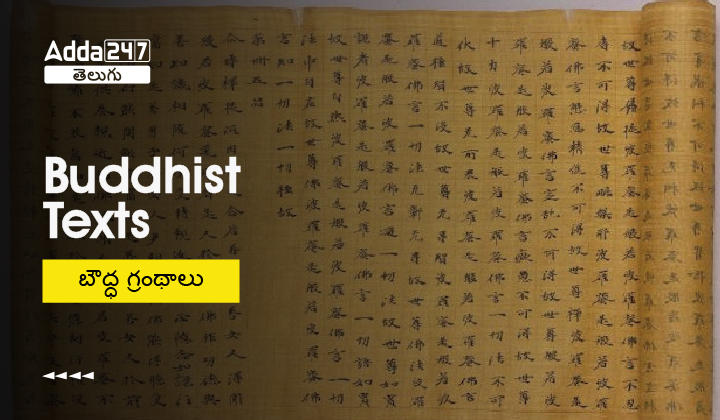
Table of Contents
Buddhist Texts In Telugu : బౌద్ధమతాన్ని గౌతమ బుద్ధుడు స్థాపించాడు. బౌద్ధమతం యొక్క అతి ముఖ్యమైన మూలం పాళీ భాషలో వ్రాయబడిన త్రిపిటకం. అవి: సుత్త పిటక, వినయ పిటక, అభిధమ్మ పిటక, దమ్మపద, మిలింద పన్హా, బుద్ధచరిత. బౌద్ధమతం యొక్క ఈ అన్ని ముఖ్యమైన గ్రంథాలు: సుత్త పిటక, వినయ పిటక మరియు అభిధమ్మ పిటక. ఇక్కడ మనం బౌద్ధ గ్రంథాలను తెలుగులో వివరిస్తున్నాము. TSPSC, APPSC పరీక్షలు, SSC, RAILWAYS మరియు UPSC పరీక్షల వంటి ఇతర పోటీ పరీక్షలకు కూడా చరిత్రలోని ఈ అంశాలు ఉపయోగపడతాయి.

APPSC/TSPSC Sure shot Selection Group
Buddhist Texts | బౌద్ధ గ్రంథాలు
- బుద్ధుడు మరణించిన దాదాపు 500 సంవత్సరాల తర్వాత బౌద్ధ గ్రంథాలు సేకరించబడ్డాయి మరియు సంకలనం చేయబడ్డాయి.
- అతి ముఖ్యమైన బౌద్ధ గ్రంథాలు త్రిపిటకాలు – వినయ పిటక, సుత్త పిటక, అభిధమ్మ పిటక.
- సూత్రాలు బుద్ధుని పదాలు మరియు బోధనలను కలిగి ఉన్న బౌద్ధ గ్రంథాల నియమావళి.
- ఇతర రకాల బోధనలు, ప్రవర్తనా నియమాలు మరియు మరణం తర్వాత పరివర్తన స్థితులపై వ్యాఖ్యానం చేసే అనేక ఇతర బౌద్ధ గ్రంథాలు కూడా ఉన్నాయి.
- బౌద్ధమతంలోని వివిధ వర్గాలు విశ్వాసాల ఆధారంగా తమకు కావలసిన గ్రంథాలను అనుసరిస్తాయి.
Vinaya Pitaka | వినయ పిటకా
- త్రిపిటకములోని మూడు విభాగాలలో వినయ పిఠకము మొదటిది.
- వినయ పిటకా సన్యాసులు మరియు సన్యాసినుల సన్యాస జీవితానికి వర్తించే ప్రవర్తన మరియు క్రమశిక్షణ నియమాలను కలిగి ఉంటుంది.
- ఇది మొదటి బౌద్ధ మండలిలో సంకలనం చేయబడింది మరియు ఉపాలిచే పఠించబడింది.
- సుత్తవిభంగా
Sutta Pitaka | సుత్త పిటకా
- త్రిపిటక యొక్క మూడు విభాగాలలో సుత్త పిటక రెండవది.
- బుద్ధుని మరణానంతరం జరిగిన మొదటి బౌద్ధ మండలిలో బుద్ధుని బంధువు ఆనందచే మొదట మౌఖికంగా అభ్యసించిన సుత్త పిటకా యొక్క వ్రాతపూర్వక గ్రంథంగా మారింది.
- సూత్ర పిటకా బుద్ధుని ప్రధాన బోధనలు మరియు ధర్మాలతో వ్యవహరిస్తుంది.
- ఇందులో బుద్ధుడు మరియు అతని సన్నిహిత అనుచరులకు సంబంధించిన సుమారు 10,000 సూత్రాలు ఉన్నాయి.
- మజ్జిమ నికాయ
- సంయుత్త నికాయ
- అంగుత్తర నికాయ
- ఖుద్దక నికాయ

Abhidhamma Pitaka | అభిధమ్మ పిటకా
- అభి అంటే “ఉన్నతమైనది” మరియు ధమ్మం ఇక్కడ బుద్ధుని బోధనను సూచిస్తుంది. ఈ విధంగా అభిధమ్మ బుద్ధుని ‘ఉన్నత బోధన’గా రూపొందింది.
- అభిధమ్మ పిటక అనేది త్రిపిటకలోని మూడు విభాగాలలో మూడవది, ఇది థెరవాడ బౌద్ధమతం యొక్క గ్రంథాల యొక్క ఖచ్చితమైన కానానికల్ సేకరణ.
- అభిధమ్మ పిటక అనేది సూతాలలో బుద్ధుని బోధనల యొక్క వివరణాత్మక పాండిత్య విశ్లేషణ మరియు సారాంశం.
- ఇక్కడ సూత్రాలను ‘బౌద్ధ మనస్తత్వశాస్త్రం’ అని పిలువబడే సాధారణ సూత్రాల స్కీమాటైజ్డ్ వ్యవస్థగా పునర్నిర్మించారు.
అభిధమ్మ పిటక ఏడు పుస్తకాలను కలిగి ఉంటుంది
- పుగ్గలపన్నట్టి
Other important texts | ఇతర ముఖ్యమైన గ్రంథాలు
- దమ్మపద: ఇది సుత్త పిటక ఖుద్దక నికాయలో ఒక భాగం. ఇది పద్య రూపంలో బుద్ధుని వివిధ పంక్తుల సమాహారం.
- మిలిందా పన్హా: దీని సాహిత్యపరమైన అర్థం మిలిందా యొక్క ప్రశ్నలు. ఇది 100 BCలో వ్రాయబడింది మరియు ఇండో-గ్రీక్ రాజు మెనాండర్ I లేదా బాక్ట్రియాకు చెందిన మిలిందా మరియు ఋషి నాగసేన మధ్య సంభాషణను కలిగి ఉంది. ఇది బౌద్ధమతానికి సంబంధించిన ప్రశ్న సమాధానాల ఆకృతిలో ఉంది.
- బుద్ధచరిత: క్రీ.శ. 2వ శతాబ్దంలో అశ్వఘోష్ స్వరపరిచారు, ఇది బుద్ధుని జీవితం గురించిన పురాణ కావ్యం.

Sharing is caring!
What are the Tripitakas?
The important Buddhist texts are Vinaya Pitaka, Sutta Pitaka, and Abhidhamma Pitaka. They are known as Tripitakas.
How many books are there in Abhidhamma Pitaka?
There are seven books in Abhidhamma Pitaka. Dhammasaṅgaṇi, Vibhang, Dhatukatha, Puggala Pannatti, Kathavatthu,Yamaka, Paṭṭhana
Test Mate – Adda247 Telugu

EMRS Non-Teaching Batch

SSC MTS Batch 2023

TSPSC Group 2
Tspsc group 4, appsc group 2.

AP Grama Sachivalayam

EMRS Hostel Warden

IMPORTANT EXAMS
Study material.
- Daily Quizzes
- Current Affairs
- Monthly & Weekly Current Affairs
TSPSC Group 3
Our other websites.
- Teachers Adda
- Bankers Adda
- Adda Malayalam
- Adda Punjab
- Defence Adda
- Sarkari Result
- Government Jobs
- Adda Bengali
- Engineers Adda
- Adda Marathi
- Adda School

Get Govt Job Vacancy in Telugu 2024. Get Notification for SSC, Railway, Banking, and other Govt jobs. Latest Vacancies for 10th, 12th, graduate, engineers, etc.
Download Adda247 App
Follow us on
- Responsible Disclosure Program
- Cancellation & Refunds
- Terms & Conditions
- Privacy Policy

Buddha Quotes in Telugu | గౌతమ బుద్ధుని సూక్తులు తెలుసుకోండి
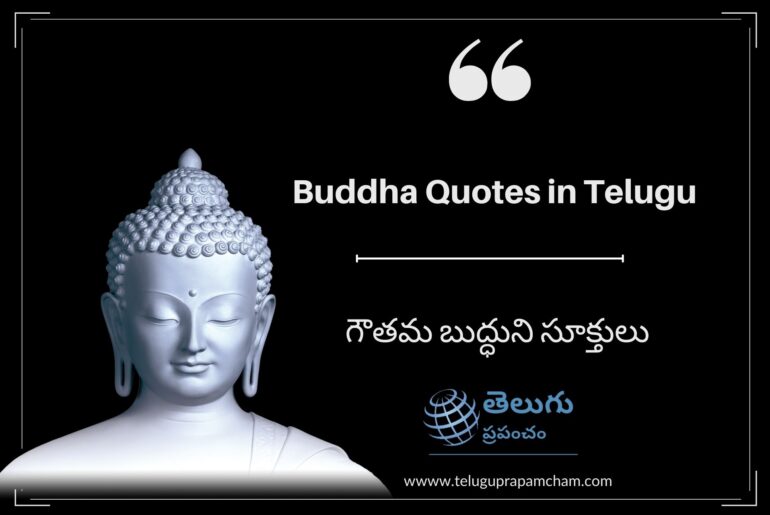
Best Buddha Quotes in Telugu We have amazing collection of buddha quotes in telugu you will enjoy reading gautham buddha quotes
బౌద్ధ ధర్మానికి మూల కారకులు గౌతమ బుద్ధుడు . ఆనాటి ఆధ్యాత్మిక గురువులలో ఒకరు గౌతమ బుద్ధుడు. బౌద్ధులందరిచే మహా బుద్ధుడిగా కీర్తింపబడేవాడు
గౌతమ బుద్ధుని సూక్తులు,
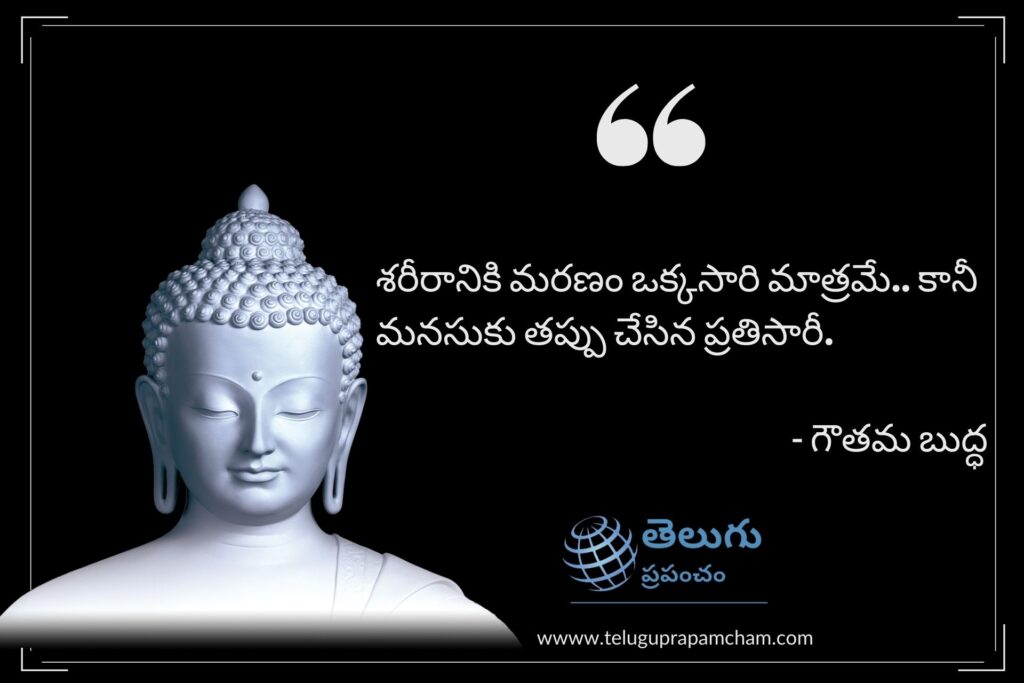
శరీరానికి మరణం ఒక్కసారి మాత్రమే.. కానీ మనసుకు తప్పు చేసిన ప్రతిసారీ.
ఉత్తములు ఎదుటివారిలో మంచితనాన్నే చూస్తారు.
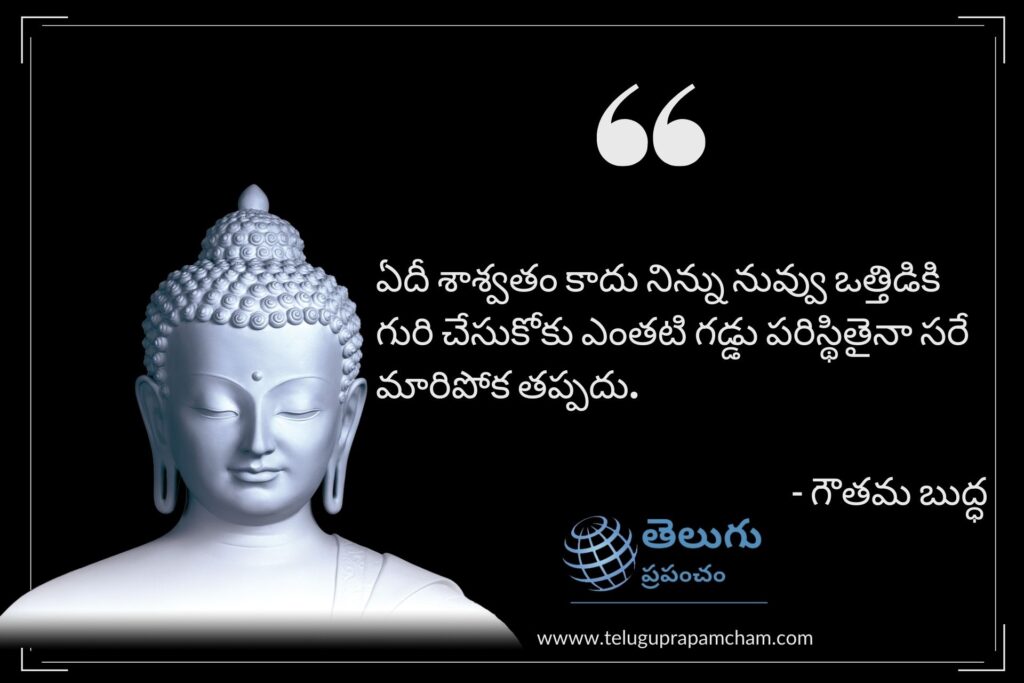
ఏదీ శాశ్వతం కాదు నిన్ను నువ్వు ఒత్తిడికి గురి చేసుకోకు ఎంతటి గడ్డు పరిస్థితైనా సరే మారిపోక తప్పదు.
తనని తాను.. వశపర్చుకోగలిగిన మనిషిని దేవతలు సైతం.. ప్రభావితం చేయలేరు అతని విజయాలను, అపజయాలుగా మార్చలేరు
Buddha Quotes in Telugu
పుకార్లు శత్రువుల ద్వారా పుట్టి అజ్ఞానుల ద్వారా పాకి మూర్ఖుల ద్వారా అంగీకరించబడతాయి..!!
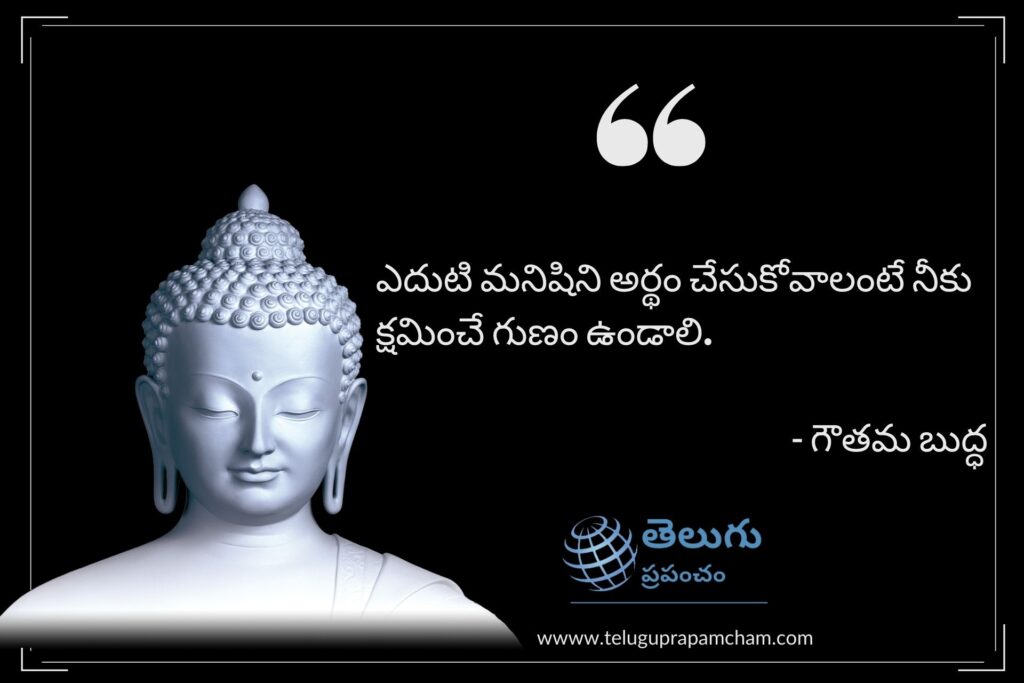
ఎదుటి మనిషిని అర్థం చేసుకోవాలంటే నీకు క్షమించే గుణం ఉండాలి
నీవు సంతోషంగా ఉండు ఈ సంతోషాన్ని నలుగురితో పంచుకో ఇదే అసలు సిసలైన సంతోష రహస్యం
కాలాన్ని వృధా చేయడమంటే నిన్ను నువ్వు దోపిడీ చేసుకోవడమే.
Positive Thinking Gautam Buddha Quotes in Telugu
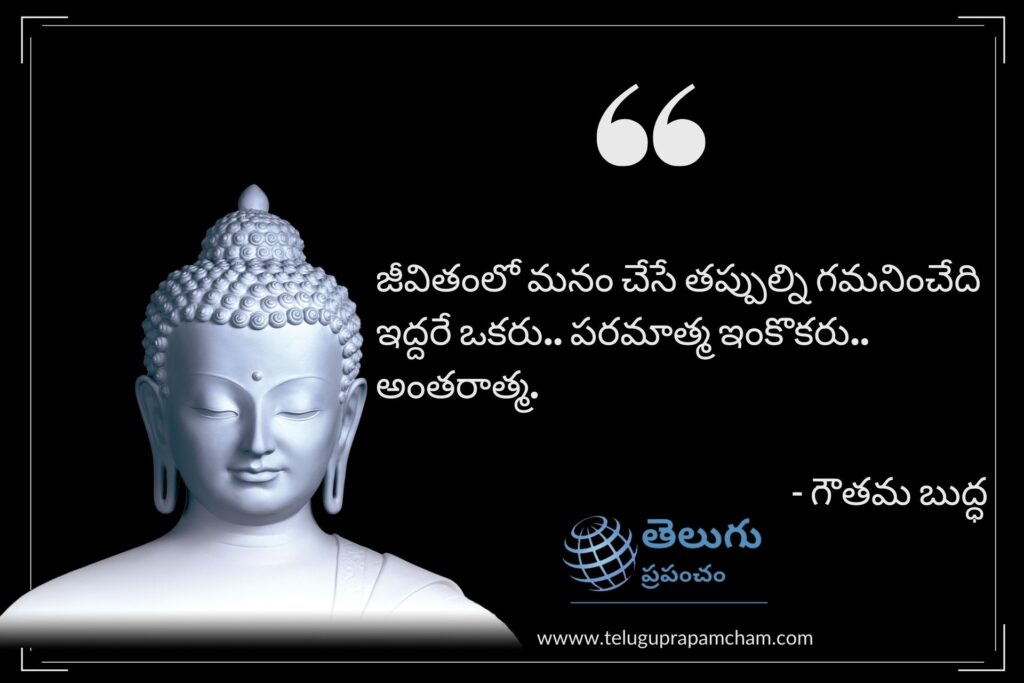
జీవితంలో మనం చేసే తప్పుల్ని గమనించేది ఇద్దరే ఒకరు.. పరమాత్మ ఇంకొకరు.. అంతరాత్మ.
ఆనందంగా ఉండే వారు తమ దగ్గర ఉన్న దాని గురించి మాత్రమే ఆలోచిస్తే.. ఆనందంగా ఉండలేనివారు తమ దగ్గర లేని వాటి గురించి మాత్రమే ఆలోచిస్తారు.
విద్య నేర్చుకుని ‘గురువు’ని మర్చిపోకు.. ధనం వచ్చాక ‘స్నేహం’ మర్చిపోకు.. భార్య వచ్చాక ‘కన్నవారిని’ మర్చిపోకు.. గౌరవం వచ్చాక ‘గతం’ మర్చిపోకు.. అవసరం తీరాక ‘సాయపడిన’ వారిని మర్చిపోకు..
అసూయపడే వారితో మన అభివృద్ధి గురించి.. ఆవేశపడే వారితో మన ఆలోచనలు.. చెప్పుకోవడం.. మన మూర్ఖత్వం
సానుకూల ఆలోచనలు ఉన్నవారికి.. ఆనందం నీడలా వెంటే ఉంటుంది.
మనం ఎలా ఆలోచిస్తే .. అలానే ఉంటాం .
యుద్ధంలో వెయ్యిమంది వీరులను సంహరించే వాడికన్నా తన మనసును తాను ..జయించిన వాడే నిజమైన వీరుడు.
జీవితం అంటేనే పోరాటం, అలాంటప్పుడు స్వార్థం కోసమో , అధర్మం కోసమో ఎందుకు పోరాటం చేస్తావు ఆ పోరాడేదేదో ధర్మం కోసం పోరాడు.
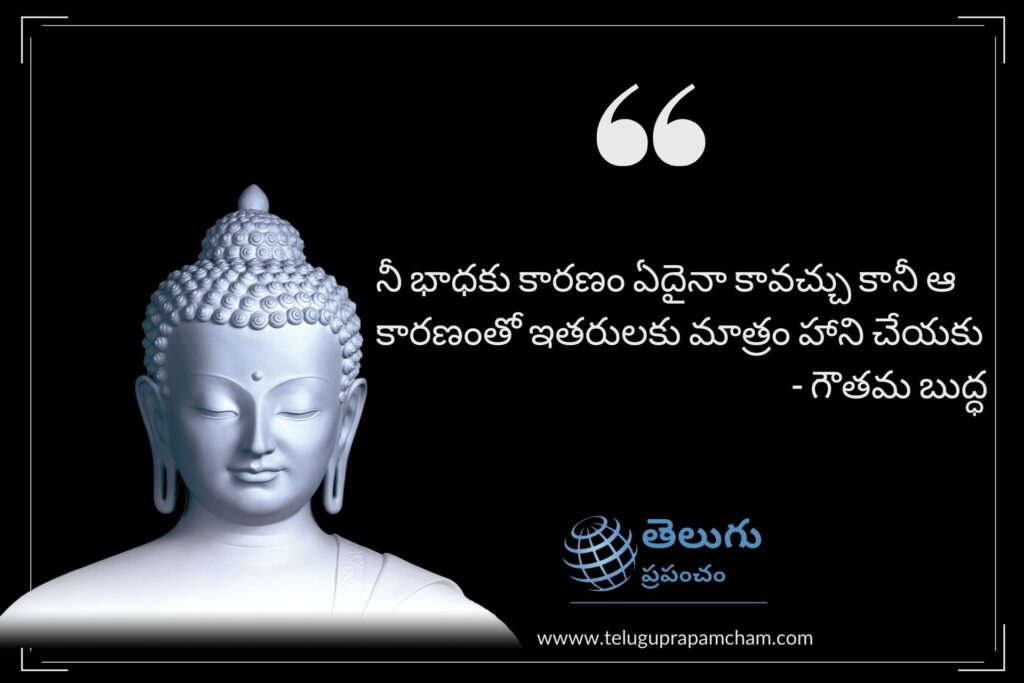
నీ భాధకు కారణం ఏదైనా కావచ్చు కానీ ఆ కారణంతో ఇతరులకు మాత్రం హాని చేయకు .
ఆశ దు:ఖానికి హేతువు అవుతుంది, ఆశ నుండి విముక్తి పొందితే దు:ఖం అంతమవుతుంది.
మనస్సు ఆనందంగా ఉంటే… తనువు ఆరోగ్యంగా ఉంటుంది.
Gautam Buddha Quotations in Telugu
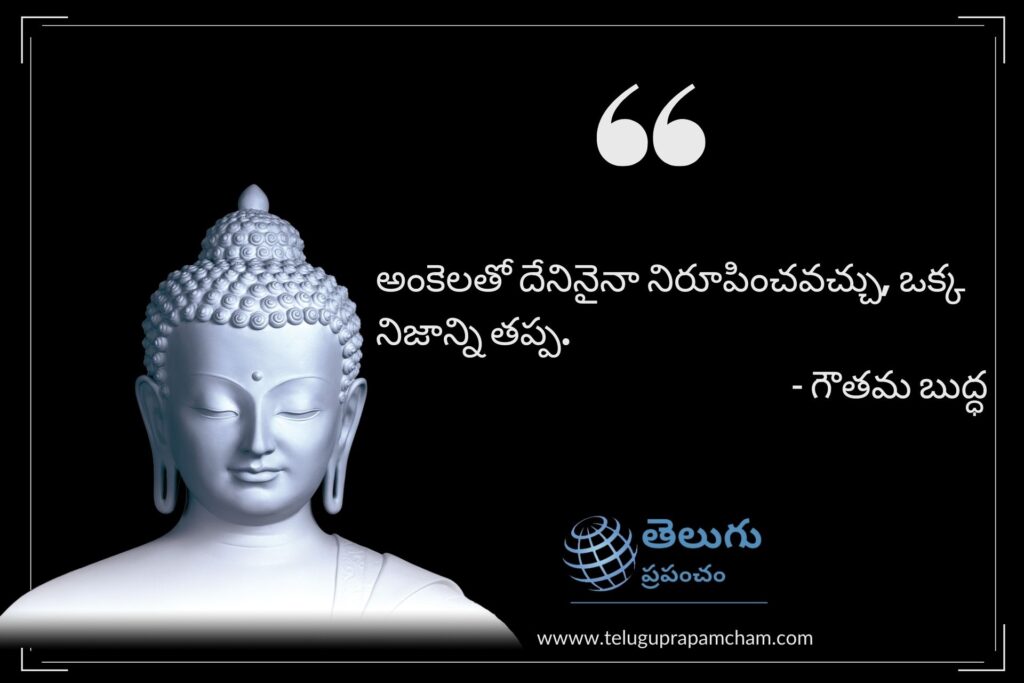
అంకెలతో దేనినైనా నిరూపించవచ్చు, ఒక్క నిజాన్ని తప్ప.
నీలోని లోపాన్ని ప్రపంచానికి చూపకండి, ఎందుకంటే ! దానితో ఆడుకోవడానికి ఈ ప్రపంచం కాచుకు కూర్చుని ఉంటుంది.
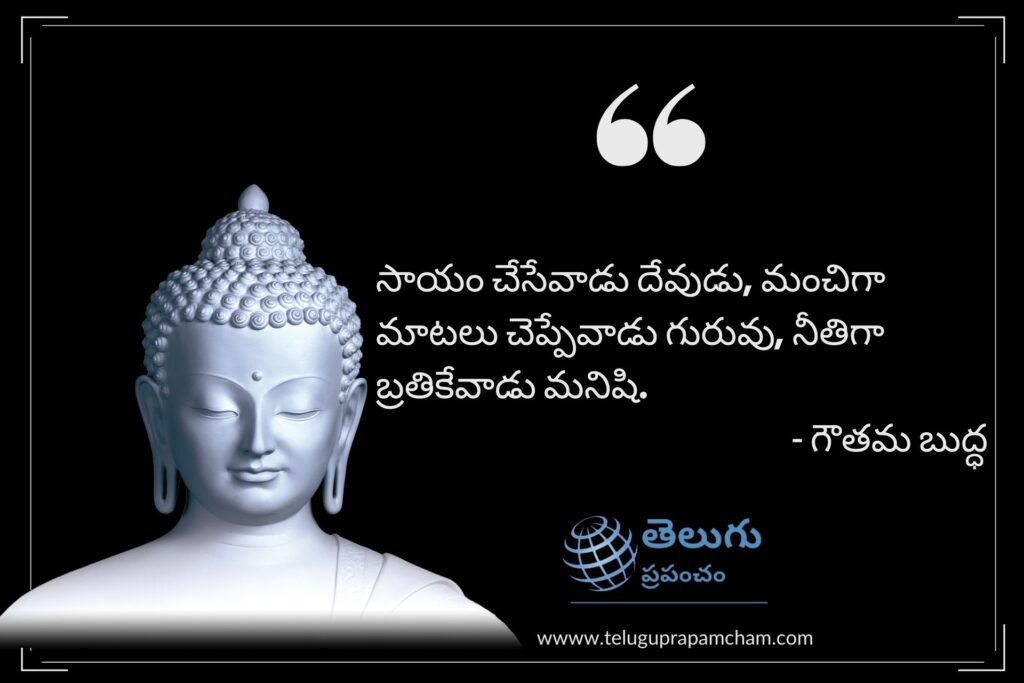
సాయం చేసేవాడు దేవుడు, మంచిగా మాటలు చెప్పేవాడు గురువు, నీతిగా బ్రతికేవాడు మనిషి.
వేలాది వ్యర్ధమైన మాటలు వినటం కన్నా శాంతిని , కాంతిని ప్రసాదించే మంచిమాట ఒక్కటి చాలు
మనసు చెప్పినట్టు మనం వినడం కాదు, మనం చెప్పినట్టు మనసు వినేలా చేసుకోవాలి .. !!!
తనని తాను వశపరచుకోగలిగిన మనిషిని దేవతలు సైతం ప్రభావితం చేయలేరు , అతని విజయాలను వారు అపజయాలుగా మార్చలేరు..
అందరిపట్ల విధేయత కనపరచండి , కానీ మీ నమ్మకాలకు భిన్నంగా ప్రవర్తించకండి….
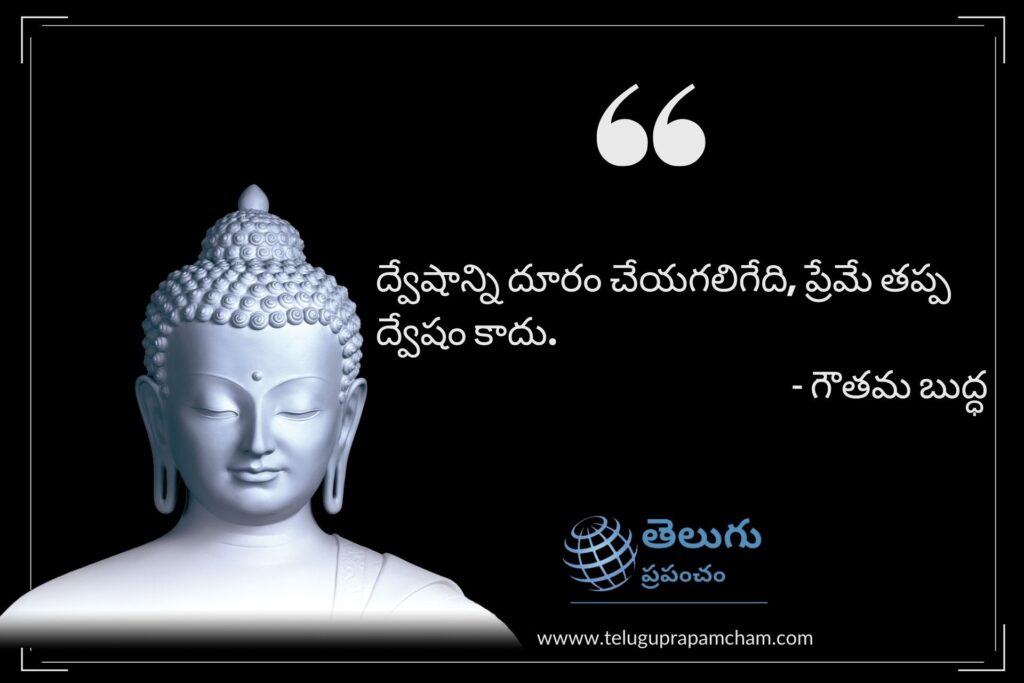
ద్వేషాన్ని దూరం చేయగలిగేది, ప్రేమే తప్ప ద్వేషం కాదు
ప్రక్కవాడు ఏడుస్తుంటే ఆనందించకు ఎందుకంటే నీకెందులోనైతే ఆనందం దొరుకుతుందో దేవుడు నీకదే ప్రసాదిస్తాడు
తనకు ఇష్టమైన పనిని ఎవరైనా బాగానే చేస్తారు , వివేకవంతులు మాత్రమే తాము చేసే పనిని ఇష్టంగా మార్చుకుంటారు
నిన్ను నువ్వు ఒత్తిడికి గురి చేసుకోకు, ఎంతటి గడ్డు పరిస్థితి అయినా మారిపోక తప్పదు .. ” ఏది శాశ్వతం కాదు “
Buddha Quotations Telugu
మానవుడు ద్వేషంతో ధనవంతుడు కాలేడు, కోపంతో గుణవంతుడు కాలేడు, కానీ మంచితనంతో మాత్రం మాధవుడు కాగలడు…
నాకు ఏమి తెలీదు అనుకునే వాడు . ” అమాయకుడు “, నాకు అన్ని తెలుసు అనుకునే వాడు .. ” మూర్ఖుడు ” నేను తెలుసుకోవాల్సినవి ఇంకా చాలా ఉన్నాయి అనుకునే వాడు …. ” నిత్య విద్యార్థి తెలుసుకున్న వాటిలో సత్య అసత్యాలు గ్రహించే వాడు . ” మేధావి “
అవసరమైతే మాట్లాడు లేదంటే నిశ్శబ్దంగా ఉండు , సాధ్యమైనంతవరకు సంబాషణల్లో ఇతరుల ప్రస్తావన వద్దు, ఉత్తమ సంభాషణలు సిద్ధాంతాల చుట్టూ తిరుగుతాయి, నీచమైన సంభాషణలు వ్యక్తుల చూట్టూ తిరుగుతాయి ….
హింస అంటే శారీరకమైనదే కాదు, మాటలతో ఎదుటివారిని బాధపెట్టినా అది హింసే అవుతుంది.
మనం చేసే మంచి పనులైనా , చెడు పనులైనా నీడలా మనల్ని వెంటాడుతూనే వుంటాయి
ఒక మనిషి గురించి మరొక మనిషికి జీవితాంతం గుర్తుండిపోయే రెండే రెండు విషయాలు .. చేతితో చేసిన సాయం .. మాటతో మనసుకు చేసిన గాయం ..
నీవు సంతోషంగా ఉండు , ఈ సంతోషాన్ని నలుగురితో పంచుకో , ఇదే అసలైన సిసలైన సంతోష రహస్యం.
అదుపులేని ఆలోచనలు శత్రువుకన్నా ప్రమాదకరం
మన దు:ఖానికి కారణం కొడుకో , ఆప్తుడో కాదు , మనలోని అజ్ఞానమే కారణం
మనిషికి నిజమైన ఆనందం లభించేది, కేవలం వారి ఆలోచనవల్లే
అన్ని విషయాలు తెలుసుకో , నాకే తెలుసునని గర్వపడకు , ఇతరుల కంటే ఎక్కువ అని నువ్వు భావించుకోకు , నిన్ను నీవు ఇతరులతో పోల్చకు .
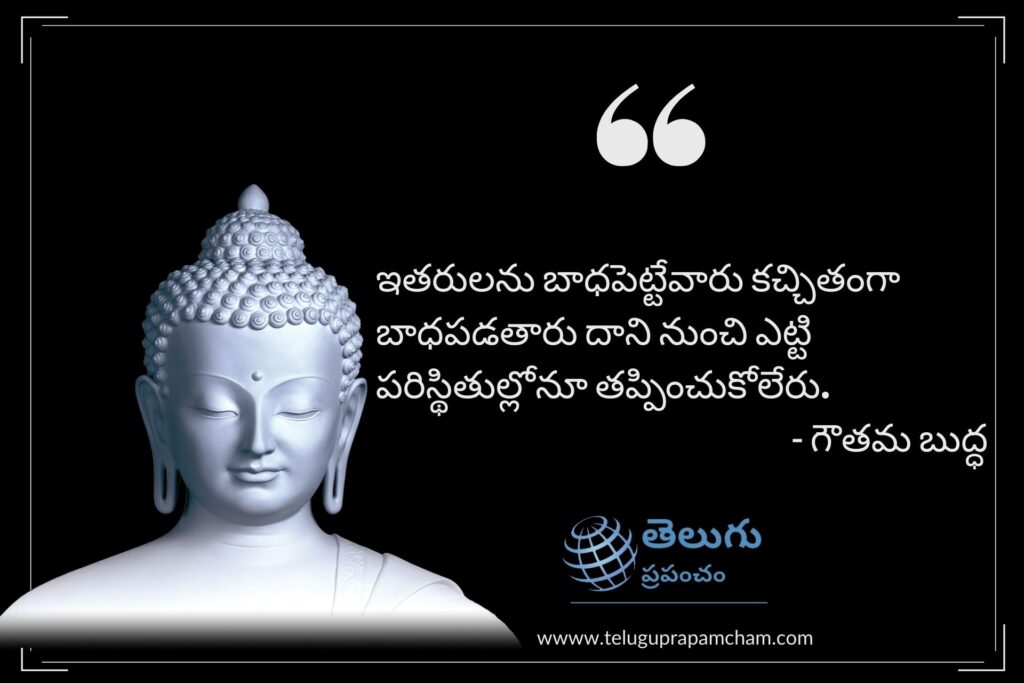
ఇతరులను బాధపెట్టేవారు కచ్చితంగా బాధపడతారు దాని నుంచి ఎట్టి పరిస్థితుల్లోనూ తప్పించుకోలేరు
సంపదలన్నింటిలోనూ ఆధ్యాత్మిక సంపదే ఉన్నతమైనది . దాన్ని కాంక్షించేవాడు కామం , క్రోధం , లోభం , మోహం , అసూయ , ద్వేషాలను అసురగుణాలకు దూరంగా ఉండాలి.
లేని గొప్ప తనాన్ని ప్రదర్శిస్తే నీలో ఉన్న నిజమైన గొప్పతనం మరుగున పడుతుంది.
ధ్యానాన్ని ఒక పనిగా చేయకు , ప్రతి పనిని ఒక ద్యానంగా చేయి
గౌరవము అనేది వయసుని బట్టి ఉండదు సంస్కారముని బట్టి ఉంటుంది… తాటి చెట్టు ఎంత పెరిగినా దాని కింద ఎవరూ నిలబడరు .. మర్రిచెట్టు చిన్నగా ఉన్న దాని కిందే అందరూ నిలబడతారు
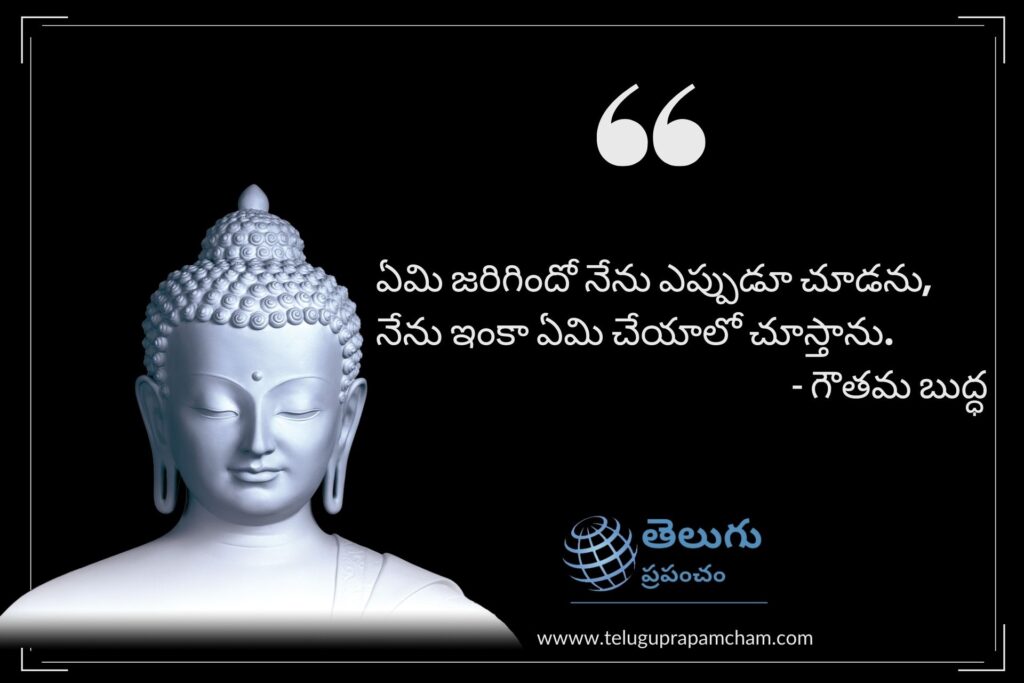
ఏమి జరిగిందో నేను ఎప్పుడూ చూడను, నేను ఇంకా ఏమి చేయాలో చూస్తాను
గతం ఇప్పటికే పోయింది , భవిష్యత్తు ఇంకా ఇక్కడ లేదు . మీరు జీవించడానికి ఒక్క క్షణం మాత్రమే ఉంది .
ప్రతి ఉదయం మేము మళ్ళీ పుడతాము . ఈ రోజు చేసేది చాలా ముఖ్యమైనది .
ఒకే పువ్వు యొక్క అద్భుతాన్ని మనం స్పష్టంగా చూడగలిగితే మన జీవితమంతా మారిపోతుంది .
కాలిపోతున్న ఇంటిని నీటితో ఆర్పినట్లు నీలోని శోకాన్ని ఆర్పేయి.!
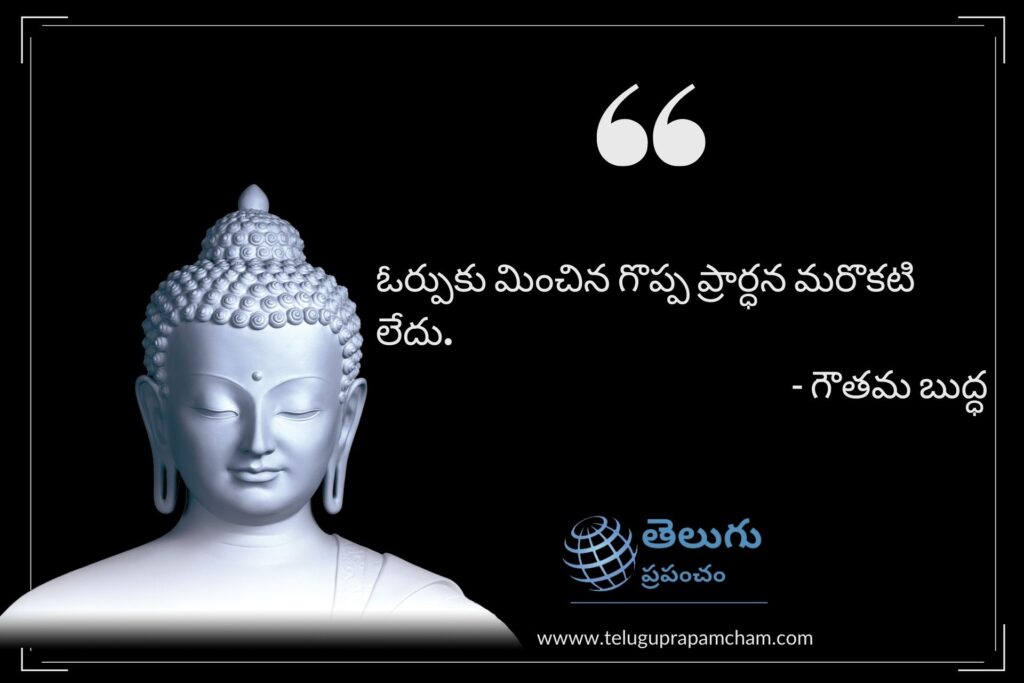
ఓర్పుకు మించిన గొప్ప ప్రార్ధన మరొకటి లేదు
చివరికి ఈ విషయాలు చాలా ముఖ్యమైనవి, మీరు ఎంత బాగా ఇష్టపడ్డారు ? మీరు ఎంత పూర్తిగా జీవించారు ? మీరు ఎంత లోతుగా వెళ్లారు ?
Inspirational Buddha Quotes in Telugu
అందరితో కలిసి చెడుదారలో వెళ్ళేబదులు, ఒంటరిగా మంచిదరిలో వెళ్ళడం మేలు
వాళ్లేమనుకుంటారో వీళ్ళేమనుకుంటారో అనుకుంటూ పోతే సగం జీవితం అయిపోతుంది అసలు నువ్వేమనుకుంటున్నావో అది నువ్వు మొదలు పెట్టు కనీసం ఎదో ఒక్కటన్నా అవుతుంది
నీ గమ్యం చేరే దారిలో ఈర్ష్య పడే కళ్ళుంటాయి . ఎత్తిచూపే వేళ్ళుంటాయి . వ్యంగంగా మాట్లాడే నోళ్ళు ఉంటాయి . బెదిరావో నీ గమ్యం చేరలేవు . సాగిపో నిరంతరంగా .. పరిస్థితులు ఎప్పుడూ స్థిరం కాదు . కష్టం ఎప్పుడు వృధా పోదు .
మనుష్యుడు తన నిశ్చల మనస్సు తోటి పూర్తి నమ్మకం తోటి ప్రయత్నం చేయకుంటే అనుకున్న లక్ష్యం సాధించలేరు .
వయోవృద్ధులను ఆరాధించువారు ఆయురారోగ్యములతో వర్ధిల్లును …
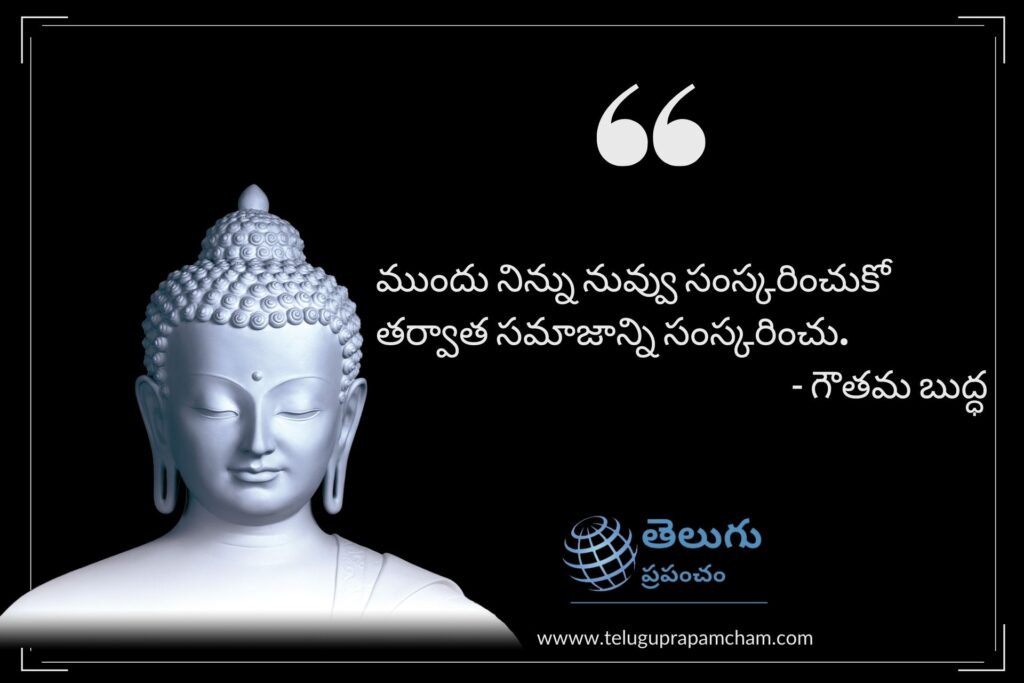
ముందు నిన్ను నువ్వు సంస్కరించుకో తర్వాత సమాజాన్ని సంస్కరించు
నీవు బ్రతికుండేది కేవలం ఈ రోజు మాత్రమే అన్నట్లు .. నీ కర్తవ్యాన్ని నిర్వహించు ఫలితాన్ని మాత్రం భగవంతునికి వదిలివేయి … అప్పుడు ప్రపంచంలోని ఏ బాధా మీ దరి చేరదు… !!
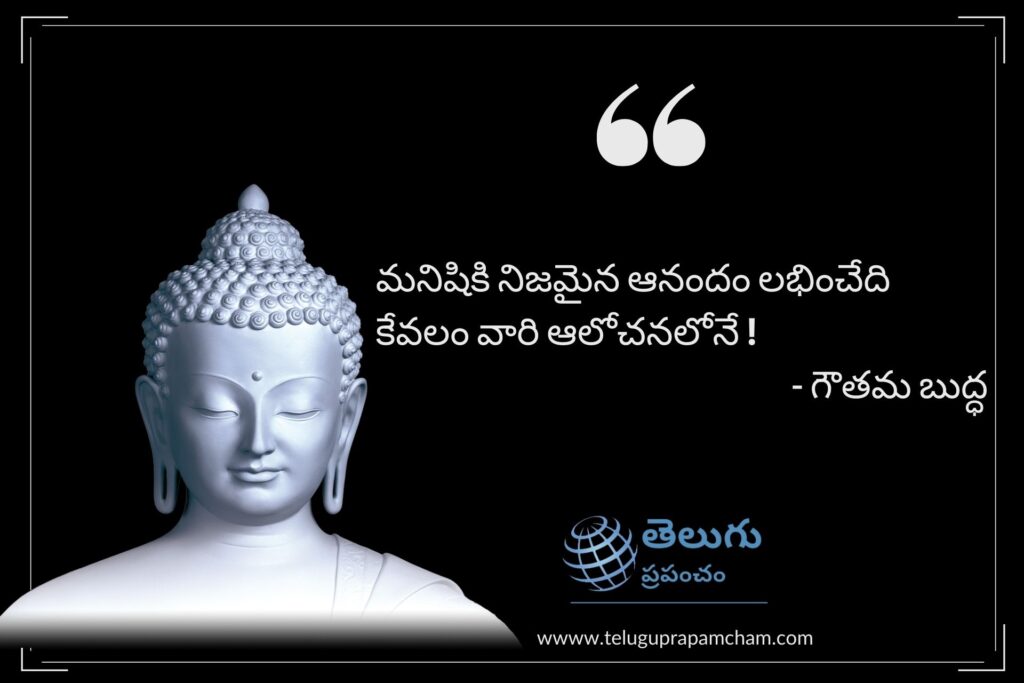
మనిషికి నిజమైన ఆనందం లభించేది కేవలం వారి ఆలోచనలోనే !
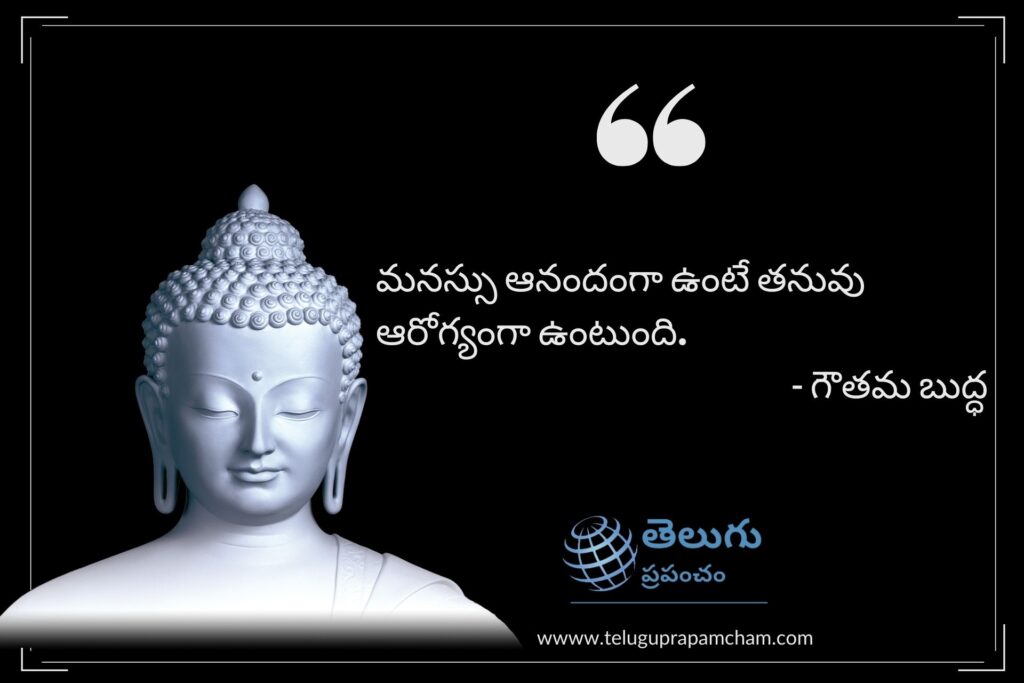
మనస్సు ఆనందంగా ఉంటే తనువు ఆరోగ్యంగా ఉంటుంది.
Also Read: Inspirational Quotations in Telugu Nammakam Quotes in Telugu | నమ్మకం కోట్స్ Swardham Quotes in Telugu | Selfish Quotes in Telugu Sarvepally Radhakrishnan Quotes in Telugu | సర్వేపల్లి రాధాకృష్ణన్ సూక్తులు
Related Posts
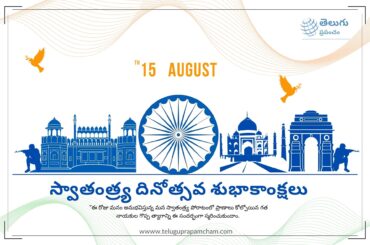
Independence Day Quotes in Telugu | స్వాతంత్ర్య దినోత్సవ కోట్స్

Love Failure Quotes in Telugu | తెలుగులో లవ్ ఫెయిల్యూర్ కోట్స్

Mothers day quotes in Telugu | మదర్స్ డే కోట్స్

Swardham Quotes in Telugu | Selfish Quotes in Telugu
Write a comment cancel reply.
Save my name, email, and website in this browser for the next time I comment.
Type above and press Enter to search. Press Esc to cancel.
- Privacy Policy
- Terms & Conditions
- Moral Stories
- Akbar Birbal Stories
- Tenali Raman Stories
- Panchatanthra Stories
- Buddha Stories
- Mythological Stories
- Freedom Stories
- Love Stories
బుద్ధ నీతి | Sometimes Let It be

శిష్యుడు సరస్సు వరకు నడిచాడు. అతను దానిని చూసాడు అందులో కొంతమంది బట్టలు ఉతకడం గమనించాడు మరియు ఆ సమయంలో, ఒక ఎద్దుల బండి సరస్సును దాని అంచున దాటడం ప్రారంభించింది.అందుకారణంగా , నీరు చాలా మట్టిగా , చాలా గందరగోళంగా మారింది. శిష్యుడు, “ఈ మట్టి నీటిని బుద్ధుడికి తాగడానికి ఎలా ఇవ్వాలి నేను ?” అందువల్ల అతను తిరిగి వచ్చి బుద్ధుడితో, “అక్కడ నీరు చాలా మట్టిగా ఉంది. ఇది త్రాగడానికి సరిపోతుందని నేను అనుకోను ” అని అన్నాడు.
కాబట్టి, బుద్ధుడు, చెట్టు దగ్గర ఇక్కడ కొంచెం విశ్రాంతి తీసుకుందాం అని అన్నాడు . సుమారు అరగంట తరువాత, మళ్ళీ బుద్ధుడు అదే శిష్యుడిని తిరిగి సరస్సు వద్దకు వెళ్లి తాగడానికి కొంచెం నీరు తీసుకురావమని కోరాడు. శిష్యుడు విధేయతతో తిరిగి సరస్సు వద్దకు వెళ్ళాడు. ఈసారి సరస్సులో స్పష్టమైన నీరు ఉంది. బురద స్థిరపడింది మరియు దాని పైన ఉన్న నీరు తాగడానికి సరిపోయేలా ఉంది. అందువలన అతను ఒక కుండలో కొంత నీరు సేకరించి బుద్ధుని వద్దకు తీసుకువచ్చాడు.
బుద్ధుడు నీటి వైపు చూశాడు, ఆపై అతను శిష్యుని వైపు చూస్తూ, “చూడండి,మట్టిగా మారిన నీళ్లు కాసేపు స్థిరంగా ఉండడంతో నీళ్ళు స్పష్టమైన నీరు పైనకి వచ్చింది. మంచి నీటి కోసం మనం ఎలాంటి ప్రయత్నం చేయాల్సిన అవసరం లేదు ”. కాస్త సమయాన్ని ఇస్తే స్వయంగా శుద్ధమైన నీరు తాగడానికి దొరికింది.
నీతి | Moral : మీ మనస్సు కూడా అలాంటిదే. అది చెదిరినప్పుడు, అలానే ఉండండి. కొంచెం సమయం ఇవ్వండి. అది స్వయంగా స్థిరపడుతుంది. దాన్ని శాంతపరచడానికి మీరు ఎటువంటి ప్రయత్నం చేయనవసరం లేదు. మనం ప్రశాంతంగా ఉన్నప్పుడు మన జీవితంలోని ఉత్తమ నిర్ణయాలు తీసుకోవచ్చు.
Related Posts

స్నేహం యొక్క విలువ | The Value of Friendship

సింహం మరియు స్నేహితులు | The Lion and His Friends

పింగళి వెంకయ్య | Pingali Venkaiah
Thank You! Keep Reading.
Thanks Madhu! Keep reading and sharing.
Leave a Reply Cancel reply
Your email address will not be published. Required fields are marked *
Save my name, email, and website in this browser for the next time I comment.

IMAGES
VIDEO
COMMENTS
బుద్ధుడు చెప్పిన నాలుగుసత్యాలు. సంస్కృత గ్రంథం, నలంద, భీహారు ...
The Buddhist prophet Gautama Buddha was born 563 BC and died in 483 AD. That means that the Buddha lived all 80 years. He was born in the Kshatriya dynasty.Siddharth is also called as Gautama Buddha.బౌద్ద ప్రవక్త గౌతమ బుద్దుడు. గౌతముడు క్రీస్తు పూర్వం 563 జన్మించి 483 లో ...
దాదాపు 5 అడుగుల పొడవు ఉన్న ఈ ఏనుగు దంతపు కళాకృతి పైన బుద్ధుని జీవిత విశేషాలకు సంబంధించిన 43 అద్భుత ఘట్టాలను కళ్ళకు కట్టినట్లు ...
Essay on Gautam Buddha ఒక పరిచయం గౌతమ బుద్ధుడిని లార్డ్ బుద్ధ లేదా బుద్ధ అని పిలుస్తారు. అతను పురాతన భారతదేశం యొక్క గొప్ప మరియు మతపరమైన నాయకుడు.
దేవుడు ఉన్నాడా లేదా అన్న ప్రశ్నకి గౌతమ బుద్ధుడి సమాధానం మనల్ని ఆలోచించేలా చేస్తుంది.
The Essence Of Buddha's Teachings . Siddhartha or Guatama Buddha was one of the world's greatest spiritual figure. He originated from Nepal. He started Buddhism which spread to many parts of the world and inspired many. Story first published: Tuesday, December 22, 2015, 14:12 [IST]
బొజ్జన్నకొండ బౌద్ధారామం, విశాఖ జిల్లా. వద్ద ధ్యాన బుద్ధుని ...
ముంగలి : తెలుగు భాగవతం పద్యగద్యాలు, శ్రవణ దస్త్రములు మొదలైన ...
Read buddha stories in telugu. గౌతముడి జీవితం నుండీ, ఆయన మార్గం నుండీ మీకు ...
అదే బుద్ధగయ. బౌద్ధులకే కాదు హిందువులకు పవిత్రమైన స్థలం గయ. how to go buddha gaya, Bodh Gaya is a religious site and place of pilgrimage associated with the Mahabodhi Temple Complex in Gaya district in the Indian state
Abstract. This essay explores the hermeneutics of modern Buddhism in colonial and post-colonial Andhra, the Telugu speaking area of India. Using four literary works in Telugu: Buddhacaritramu by Chellapilla Venkata Sastri and Divakarla Tirupati Sastri (known as the Twin Poets), Saundaranandamu by Pingali and Katuri, a play Tiṣyarakṣita by Buccibabu, and a short poem entitled 'A Jataka ...
BUDDHISM IN TELUGU : అన్ని రోగాలకి ఒక్కటే మందు! Think Telugu Podcast#buddhism #thinktelugupodcast #telugupodcast
Bhaskar Hanumath Kompella, Telugu Translation in the form of Tika (Word by Word meanings) and Tatparya (Substance). Buddha Charitam, Ajo-Vibho-Kandalam Publications, Hyderabad, 2018; Bhavanath Jha. Buddha-charitam Restored into Sanskrit verses by Pt. Bhavanath Jha. (Contains a re-translation back into Sanskrit of the lost cantos).
Buddhism is one of the greatest religions of the world that developed from the doctrines of Buddha. Buddhism started in India over 2,600 years ago. for more details read the article completely. sudarshanbabu Published On October 19th, 2023. Table of Contents.
This essay explores the hermeneutics of modern Buddhism in colonial and post-colonial Andhra, the Telugu speaking area of India. Using four literary works in Telugu: Buddhacaritramu by Chellapilla ...
Here's a selection of translations into Telugu of Buddhist texts and ceremonies taken from the Pali Canon and used in the Triratna Buddhist Community. Many thanks to Manidhamma for contributing most of these! Coming shortly are the Dedication Ceremony, Refuges and Precepts, and more. For other languages please see the main Triratna Translations ...
Essay on Gautam Buddha. Gautam Buddha, the messenger of peace, equality, and fraternity, was born in Lumbini in the 6th Century BC, the Terai region of Nepal. His real name was Siddhartha Gautam. He belonged to the royal family of Kapilavastu. His father was Suddhodhana, the ruler.
This essay explores the hermeneutics of modern Buddhism in colonial and post-colonial Andhra, the Telugu speaking area of India. Using four literary works in Telugu: Buddhacaritramu by Chellapilla Venkata Sastri and Divakarla Tirupati Sastri (known as the Twin Poets), Saundaranandamu by Pingali and Katuri, a play Tiṣyarakṣita by Buccibabu, and a short poem entitled A Jataka Tale by ...
Buddhist Texts In Telugu: Buddhism was founded by Gautama Buddha.The most important source of Buddhism is the Tripitaka written in the Pali language.They are: Sutta Pitaka, Vinaya Pitaka, Abhidhamma Pitaka, Dhammapada, Milinda Panha, Buddhacharita.All of these most important texts of Buddhism were: Sutta Pitaka, Vinaya Pitaka, and Abhidhamma Pitaka.
Buddha Quotations Telugu. మానవుడు ద్వేషంతో ధనవంతుడు కాలేడు, కోపంతో గుణవంతుడు కాలేడు, కానీ మంచితనంతో మాత్రం మాధవుడు కాగలడు…. నాకు ఏమి తెలీదు ...
This essay explores the hermeneutics of modern Buddhism in colonial and post-colonial Andhra, the Telugu speaking area of India. Using four literary works in Telugu: Buddhacaritramu by Chellapilla Venkata Sastri and Divakarla Tirupati Sastri (known as the Twin Poets), Saundaranandamu by Pingali and Katuri, a play Tiṣyarakṣita by Buccibabu, and a short poem entitled 'A Jataka Tale' by ...
Stories In Telugu | తెలుగు నీతి కథలు Jul 13, 2020 Sep 24, 2021 4 Comments on బుద్ధ నీతి | Sometimes Let It be Lord Buddha శిష్యుడు సరస్సు వరకు నడిచాడు.
facebook - https://www.facebook.com/lifeoramainstagram - https://www.instagram.com/mrlifeoramatwitter - https://twitter.com/lifeoramaBUDDHA TEACHINGS ON LIFE...